Dairy Talk
Maintaining a profitable farm
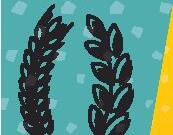

Page 9
DRY COWS
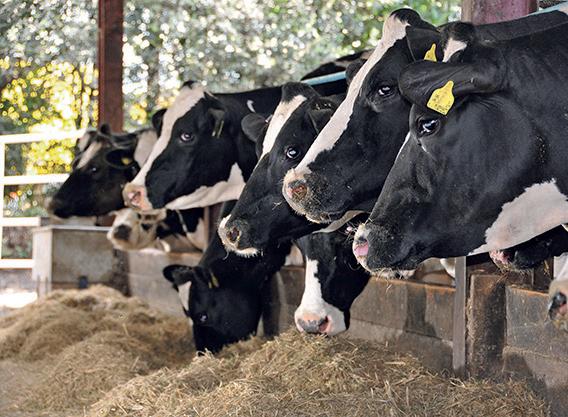
Managing
DAIRY TECHNOLOGY

Making the most of on-farm equipment


Pages 42-54

VET’S VIEW
Expert advice on dealing with the burden of flies

Pages 16-17
MILK PRICES
Pages 60-62
TIP OF THE MONTH: Weigh youngstock to monitor performance – p18-19

WholecropVisualGuide TAKE CONTROL OF WHOLECROP SILAGE QUALITY
PLATINUM WHOLECROP contains a unique combination of proven bacteria and enzymes providing complete flexibility on clamp opening times, plus: UP TO 15 UP TO mj/t MORE energy 131 UP TO % Less yeast & Mould 99 % MorE DM
Getyourcopyofour
MAGNIVA
Pages 30-40
the transition period in your herd
FARMER
DAIRY
June 2023
70 Issue 6
Volume
BREEDING THE WAY TO LOW METHANE COWS
At last, a genetic solution to methane emissions
For the first time producers around the world can genetically benchmark and monitor their herd’s methane efficiency with Semex Elevate®. The genomic test that analyses what you can’t see or measure on farm returning valuable information to aid your breeding decisions.





Breeding for reduced methane production has a reliability of 70-80%, is low cost, permanent and cumulative and what’s more it’s independent from other traits such as milk, fat and protein.
20-30% reduction in methane by 2050 through genetic selection is now a reality.
From the people who brought you the power to reduce antibiotic usage with



Semex UK: www.semex.co.uk : 0800 86 88 90
Contacts
Editor Katie Jones 07786 856 439 katie.jones@agriconnect.com

Content Editor/Designer

Mike Begley 01772 799 405 mike.begley@agriconnect.com
Picture Editor

Marcello Garbagnoli 01772 799 445 marcello.garbagnoli@agriconnect.com
Sales Director
Stephanie Ryder 07917 271 987 stephanie.ryder@agriconnect.com
Account Manager





Mark Jackson 01322 449 624, mark.jackson@agriconnect.com



Classified Advertisements 01772 799 400 fgclassified@agriconnect.com
Advertising Production
Justine Sumner 01772 799 437 Fax: 01772 796 747 justine.sumner@agriconnect.com
Circulation and subscriptions 0330 333 0056 help@subscribe.farmers-guardian.com

Subscription rates: UK £65 a year
Europe: £85 World: £95
ISSN 1475-6994


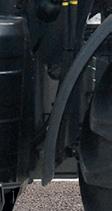




© Farmers Guardian 2023
All rights reserved. No part of this publication may be reproduced or transmitted in any form or by any means, electronic or mechanical including photocopying, recording, or any information storage or retrieval system without the express prior written consent of the publisher. The contents of Dairy Farmer are subject to reproduction in information storage and retrieval systems.
a word from the editor
Ihope by the time you read this, some more of you will have managed to get on with silage-making.
The weather, to put it politely, has certainly not been playing ball here in Cheshire, and farmers are watching weather forecasts in earnest in the hope of a few consecutive days of settled conditions so they can get on with silage-making and maize drilling.

Apprehensive
It has certainly been a long and cold spring, so I was slightly apprehensive about including an article about heat stress in this month’s edition.
But, as recent years have shown, we increasingly have to contend with extremes in the






weather and heat stress is now a real problem on many of our farms.
And who knows, by the time next month’s magazine comes out we may be complaining that conditions are too hot and dry.
All this talk of the weather does take the mind slightly off the milk price situation, which really is a mixed bag at the moment.
ere are still plenty of downward price moves being made by milk buyers, but some market watchers are starting to suggest there might be some glimmers of hope in that the market is beginning to stabilise.
The weather has again played its part in this, with the cold spring helping to keep a lid on production in the UK, which has perhaps helped to curb a more dramatic drop in milk prices.
3 JUNE 2023
DON’T CHANGE YOUR TRACTOR. TRANSFORM IT. WITH A STOLL PROFILINE FRONT LOADER ENGINEERING • Ideal for any tractor from 40 to 270hp • Superb visibility from the cab • Attach/detach in under 2 minutes • Effortlessly smooth, precise control • Unrivalled range of tilt/crowd angles • Ultra-strong steel, superior paint finish MORE WAYS TO ADD MORE PRODUCTIVITY FRONT LINKAGES • FRONT PTOS • PICK-UP HITCHES • WEIGHTS • REVERSING FANS • FRONT PRESSES For further details about any products in the Lynx Engineering range call us today on 01327 843215 or visit www.lynx-engineering.co.uk 3340 Lynx Front Loader Quater Pg Ad DF.indd 1 17/03/2023 11:58 Dairy Farmer, Unit 4, Fulwood Business Park, Caxton Road, Preston, Lancashire PR2 9NZ Origination by Farmers Guardian, Unit 4, Fulwood Business Park, Caxton Road, Preston, Lancashire PR2 9NZ. Printed by Precision Colour Printing, Halesfield 1, Stirchley, Telford TF7 4QQ. No responsibility can be accepted by Dairy Farmer for the opinions expressed by contributors.
What’s inside?
No end in sight to Welsh bTB woes
elsh Government has been urged to ‘get the basics right’ or risk losing farms altogether, with farmers seeing no light at the end of the tunnel on bovine TB.
Farming in the Welsh borders was made even more challenging by differing policies in the two countries, as badger culling was
Wallowed in England while farmers felt they were unable to voice concerns over infected wildlife in Wales.
Dairy Farmer’s sister publication Farmers Guardian convened a roundtable on the Welsh border, with attendees expressing their frustration with bTB policy.
Dairy farmers Susie and Mark Mottershead in North Wales, less than 10 miles from the English border, have had bTB on their

Take action to keep Scotland bTB-free
JFarmers need to plan their cattle-buying policy carefully to help keep Scotland free of bovine TB, with an increasing demand from farmers in England for Scottish breeding stock.
Although Scotland is Officially TB-Free (OTF), there are still an average of 12 breakdowns per year, with the vast majority linked to imports from elsewhere in the UK or the Republic of Ireland.
Uneasy
Only in a few cases is the cause undetermined, but even these are enough to make NFU Scotland president Alasdair Macnab uneasy.
As well as being a farmer near Dingwall, Mr Macnab
is a former Government vet with considerable experience of tackling bTB.
He said Animal and Plant Health Agency investigations indicated there was no significant wildlife bTB infection in Scotland.
He said Scottish farmers did not want to go through the same experiences as their counterparts in Wales and elsewhere.
There was also increasing demand for breeding stock from Scotland being reported by auctioneers south of the border, which Mr Macnab said showed the importance of maintaining the OTF status.
He said: “It can be maintained and needs a cautionary approach.”
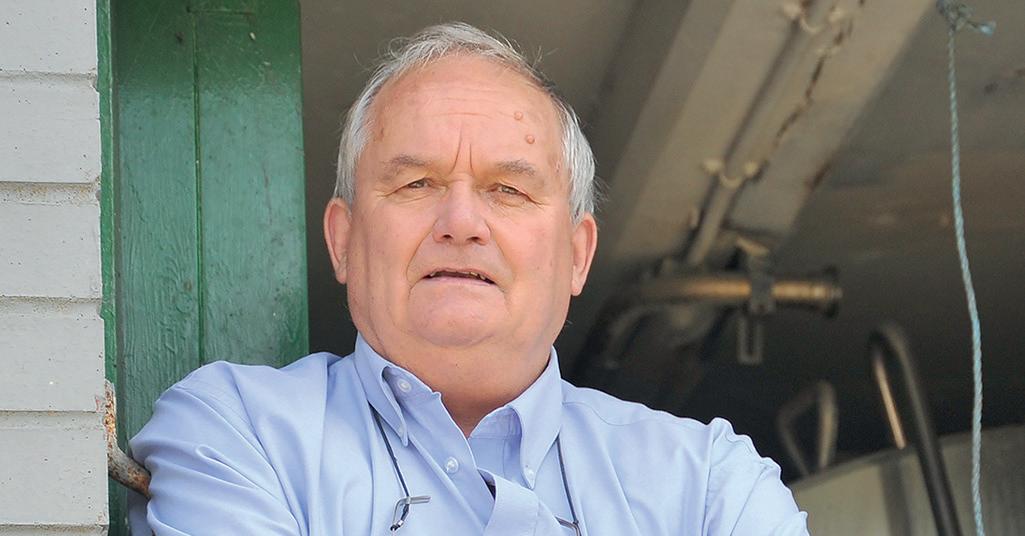
NEWS 4 JUNE 2023
JUNE 2023 VOLUME 70 ISSUE 6 10-12 On Farm 70-71 Good Evans 8 DAIRY TALK Becky Fenton and Dan Burdett 10 ON FARM Genetic improvement key to high performing herd 14 DAIRY MATTERS With Dugald Hamilton of the Agricultural Mortgage Corporation 16 VET’S VIEW Expert advice on dealing with the burden of flies 18 YOUNGSTOCK Weighing routines 20 WORLD DAIRYING South African farm brings unique challenges 22 HEAT STRESS Keeping heat stress at bay on-farm 26 BRITISH FARMING AWARDS Last year’s Dairy Farmer of the Year winner 28 HERBAL LEYS 30 DRY COW MANAGEMENT Managing the transition period in your herd 42 DAIRY TECHNOLOGY Making the most of on-farm equipment 56 MACHINERY Lancashire dairy farm putting robots to use 60 MILK PRICES 64 MILK ANALYSIS 66 NEW PRODUCTS Products hitting the market 70 GOOD EVANS ‘Local legend has it that I was knocked out’ 72 BUSINESS CLINIC Price volatility raises contract pricing questions 74 RESEARCH
farm for a decade. But they fear nothing is changing and that they will live with bTB ‘for the rest of their farming life’.
Mr Mo ershead said language used around bTB made it feel like farmers were ‘always at fault’ and the disease was ‘down to ca le movements’.
And the couple said wildlife needed to be factored in to the conversation around bTB.
“When we are dealing with any outbreak of anything, you look at all the factors that can add into it. Even if it is not wildlife initially, it does not mean it is not relevant
now,” Ms Mo ershead said, adding they were following the rules and asking what else they could do.
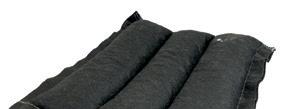
Rural A airs and North Wales Minister Lesley Gri ths said she was not accusing farmers, but the role of ‘informed purchasing’ in tackling the spread needed to be considered.

“Informed purchasing is incredibly important and farmers need to recognise that. I am not blaming farmers, I am just saying we have to work in partnership,” she said, adding farmers needed to ‘take the lead’ on this.
“ at is why I gave the funding















to make sure as much information about ca le is made available before a farmer buys livestock.”


Challenging

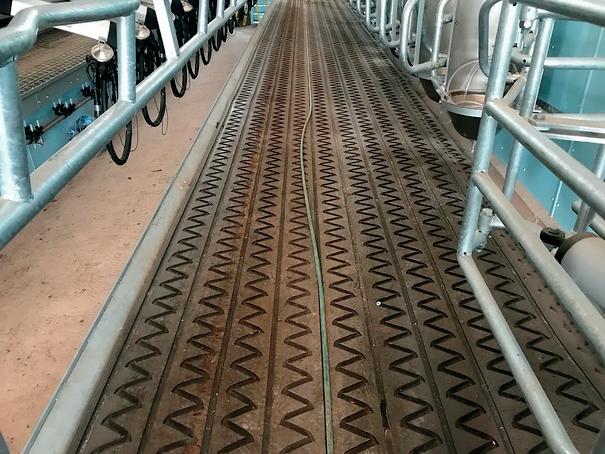
Jonathan Sco , who farms near to the Mo ersheads, said farming on the boundary was challenging, with di erent policies due to devolution.
Mr Sco said the governments use the badger cull ‘against each other’.


He said: “While there are two separate parties in power in Wales and England, this will always be the case.”
JA lack of security over the future of their business is adding intense pressure to tenant farmers already operating in an uncertain environment.

Not knowing whether they will have their farm in five years or not is the biggest worry for most tenant farmers who are under a Farm Business Tenancy.


Tenant Farmers Association chair George Dunn said: “Farming is a long-term endeavour, requiring significant capital investment, patience, good soil management and the ability to balance the profitable years against the unprofitable. None of this is helped by the short-terms offered in today’s FBTs.”
Tenant farmers putting off investment 2023 Gold Cup
JApplications for the 2023 NMR/RABDF Cold Cup competition are now open. The competition is open to all milk-recording and non-milk-recording herds. Farmers can enter themselves or industry representatives can nominate farms they think are worthy of the title. Entries are open until August 1, with the shortlist judged later this year.




Official Distrib f View our cow comfort range: www.wilsonagri.co.uk Contact us at HQ: 028 7086 8430 Mattress Dairy Grip rubber AgriCow Pendulum Cow Brush Calf De-horning crate Calving Gates Cattle Crushes Slat Rubber FARMING EQUIPMENT & TECHNOLOGY FUND 2023 Matthew Evans 07922 422556 Charlie Sutcliffe 07703 679023 Midlands & Wales Scotland & Northern England Eligible items in our ranges: Livestock Equipment www agrikit co uk A COMPLETE RANGE OF COW COMFORT PRODUCTS Pasture Mat the premium cow mattress
NEWS 5 JUNE 2023
Farmers in Wales say they fell unable to voice concerns over TB-infected wildlife.
Farmer confidence at its lowest in three years

Farmer confidence has dropped to its lowest levels since the start of the Covid-19 pandemic, with spiralling costs of production and the phasing out of support hitting businesses.
The latest NFU survey showed 88% of farmers have been, and continue to be, affected by high costs of energy, fuel and fertiliser.
And 82% per cent of farmers said the uncertainty around farming payments, such as the Environment Land Management scheme, was creating a lack of assurance for the future.
NFU president Minette Batters said: “It is shocking but not surprising that our farmer confidence survey is reporting the lowest levels in three years.
“During this time, we have experienced a global pandemic, a war in Europe, tumultuous political change and extreme weather.
“If this lack of confidence and uncertainty is allowed to continue during such challenging times, it has the potential to lead to further shortages on supermarket shelves.”
British farmers have shown a
‘real ambition’ to future-proof their farm business and do what they can to reach the industry’s net zero target by 2040, Ms Batters said, but investment in climate-friendly practices was being hampered.
Energy security
Ms Batters also highlighted farmers role in energy production, with energy security ‘crucial to our nation’.
She said farmers need to be reassured that the Government is supporting through policies which can ‘build profitability and resilience into farm businesses’, as well as transparency on future support.
NFU Scotland president Martin Kennedy said NFUS had found similar results.
He said: “The number one concern of those producing the nation’s food is the growing uncer-
tainty around what Scotland’s future agricultural policy will look like beyond 2025 and what measures will be open to farmers and crofters for support as part of that policy.
“That increasing uncertainty is already eroding confidence –causing too many to question their futures, which ultimately threatens Scotland’s food security, together with its environmental integrity and economic prosperity.”
Creating a pipeline of employees to safeguard industry
JThe Royal Association of British Dairy Farmers (RABDF) has hosted a roundtable at the House of Lords to discuss the growing labour crisis in the dairy industry and outline ways to overcome it.
Di Wastenage, RABDF chair, said the roundtable provided invaluable discussion on how to create a short and longer term pipeline of employees coming into the industry.
She said: “This is not
something that can be done overnight and it will take time to prioritise how we do this and the key stakeholders needed to help us get there.
Access
“It is clear that access to foreign labour is something we still need in the short-term, so we will be reiterating that message in our submission to the Shortage Occupation List review.
“However, it is not a long-term solution. For that, we need to look at a myriad of options from education in schools, brand building, skills development, attracting employees from diverse backgrounds and setting up a dairy scholarship scheme, as examples.”
Ms Wastenage added this pipeline of employees was needed to safeguard the UK’s dairy industry.
She said: “The next steps are to identify the key players and where the shortages lie, which we hope to achieve with our 2023 labour survey.”
Results
Results from the RABDF labour survey will outline where the barriers are to recruitment, the extent of the labour problem on UK farms and the impact it is having.
NEWS 6 JUNE 2023
Most farmers say they continue to be affected by high costs of energy, fuel and fertiliser.
BECAUSE IT’S ABOUT
QUALITY
Creating generations of healthy cows.
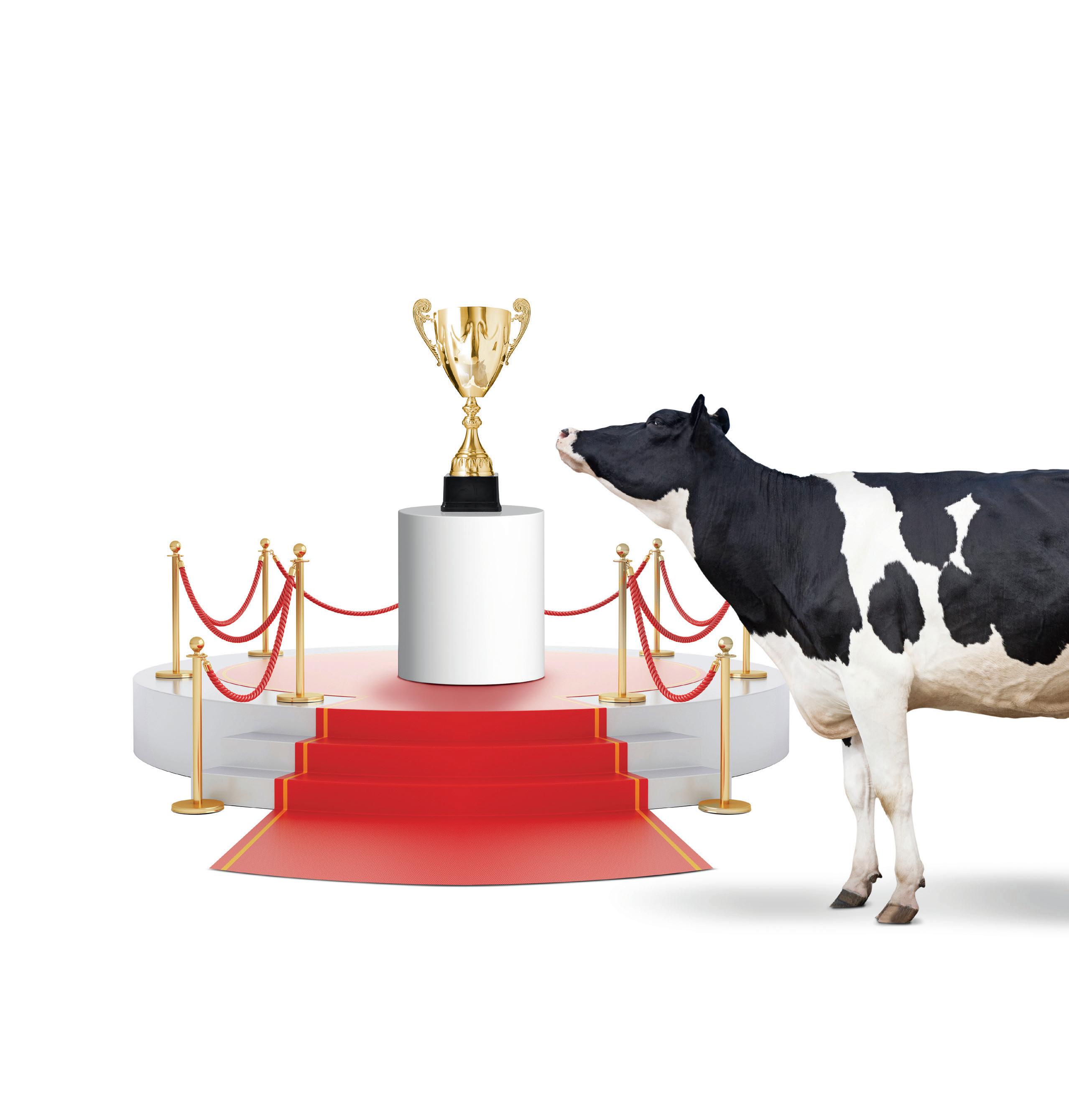
Boost milk production and reduce feed costs with Evonik’s rumenprotected methionine for dairy cows. Mepron® delivers highly concentrated DL-methionine precisely where it benefits the animal most – in the small intestine. How? With science. Mepron® is equipped with a sustained release film coating that ensures handling and mixing stability. It can be mixed homogenously, and is not affected by potentially abrasive components, high temperatures or low pH.
Sciencing the global food challenge. | evonik.com/mepron
DAIRYTalk
Becky Fenton
Becky Fenton and husband Paul milk 200 pedigree Holsteins under the Springlebee prefix at Centenary Farm, a Cheshire county council farm. In 2021, they bought a farm in Staffordshire and they plan to farm there once the new dairy set-up has been built.

One of our good friends once said to us: “You should write a book on your farming life.”
This was mainly due to all our mishaps, bad luck and sometimes stupidity. So I suppose this column gives me the opportunity to keep a note of it all.
The last couple of months have been no different, and a little turbulent.
The most recent escapades have been staff-related problems. A few weeks ago I was outside when a policeman pulled up.
He had had reports of a John Deere swerving all over the road and wanted to speak to the driver (our worker).
Turns out he had no license and when they drug tested him it came back positive.
Fortunately for us, no third parties were involved, but it served as a lesson learned to always check driving licences and not to accept someone’s word alone.
After dismissing that worker, we managed to find another. He had a glowing reference and appeared to be a good candidate. However, from day one there were alarm bells: lateness; taking longer than necessary for breakfast; and going off with the tractor for hours.
On his fourth (and final) day, he put the tractor and trailer in the ditch, denied it and burst a back tyre on the tractor. He was waved off gladly.
Staff (or lack of) appears to be at the forefront for a lot of farmers at the moment. Seeing endless job adverts daily and dispersal sales due to no staff is a worrying sight.
Reliability
Not only is it difficult to find staff, but even harder to find good reliable staff who know which end of the broom to use.
The industry is struggling for manual skilled workers. I recently spoke to Harper Adams about taking on a placement student.
I was informed they are not taking on anymore farmers for the reason that students are no longer interested in on-farm placements.
Students want to explore ancillary careers instead, such as nutrition, land management, genetics, etc. But these careers can only exist with the existence of farmers. Out of 120 students, fewer than 10 were going to work on-farm.
The demand to work in the agricultural industry is strong, but very few people want to work on the farm itself.
I struggle to see a solution for this scenario going forward, but the phrase ‘too many chiefs and not enough Indians’ does come to mind.
We are currently midway through silaging. A very small break in the weather has meant that everything has come at once, trying to silage and get maize in at the same time is challenging.
Having our own silage equipment is advantageous in these small weather breaks. This season we have purchased a new Krone forage wagon and Kuhn twin mowers. Both are performing well and speeding the job up.
Each year I am told ‘we will not need any new machinery next year’, but somehow there is always a sales offer which is ‘too good not to miss’.
The beef enterprise is growing well, albeit to my dismay. I must have missed the memo about a change in our beef calf protocol.
Having said that, with the rise in prices of beef calves, I have finally convinced Farmer Fenton to sell some. This week we sold seven calves, averaging £295.
8 JUNE 2023
“ Staff (or lack of) appears to be at the forefront for a lot of farmers at the moment
Dan Burdett
Dan and his family own and run the 300-hectare (741-acre) Cockhaise Farm, near Haywards Heath, West Sussex. The farm is home to an organic autumn-calving herd of 240 Holstein and Friesian crosses. He also contract farms another organic autumn-calving herd of 220 cows at Bore Place, near Edenbridge, Kent.

After many years of complaining about dry springs here in Sussex, I finally got my comeuppance this year, with March and April both delivering more than 100mm of rain.
To say that this has made decision-making challenging would be to put it mildly, with cows in and out like a yo-yo, spring drilling being drawn out over three weeks and grassland turning to mud daily.
On the positive side, I am hopeful the moisture will allow some rare spring reseeding to happen and the new trees and hedges, planted in February, have never looked so good.
As part of our farming philosophy, we aim to increase biodiversity on-farm, mainly in the form of new hedges, which create much needed wildlife corridors between our various patches of woodland, and our silvo-pasture trials in two of our paddocks.
For this we have planted mixed native trees in a 10-metre grid across seven acres of some of our poorest soil, protecting them with cactus tree guards, meaning cows can graze freely among them.
The long-term aim is to create more shade and shelter, an alternative feed source and hopefully an increase in the fungal population within the soils.
These are all medium- to long-term aspirations and we can only do this as owners of those fields, so we made sure to only invest enough money that we could afford to lose if the project failed.
Much has been said on social media in recent months about the dramatic loss in biodiversity across much of the UK and I feel that as farmers we must admit that not all we do is beneficial to our living environment.
Knock-on effect
The collapse in numbers of many of our insect populations, through wormers, insecticides, tillage and nutrients, is having a knock-on effect on bird populations, with the potential for our generation to see the loss of many of them.
The challenge for us is to maintain a productive and, most importantly, profitable farm, while also trying to minimise our impact on our farming ecosystem.
Along with the hedges we have also invested
in a pto driven chipper, which will take all of the brash left over from felling and coppicing trees for our biomass boiler and turn it into a product we can compost over 12 months and hopefully use to enhance the longer term health of our soils.
We received funding for this through Farming in Protected Landscapes, which is running for another two years in certain parts of the country (we are in the High Weald).
I would highly recommend more farmers to have a look at the funding opportunities which come with this programme, particularly those who would like to invest in machinery or grazing systems that will benefit soil health.
As I look out of the window now, the sun is blazing down and you can almost hear the grass growing, so fingers crossed for a productive spring and summer ahead.
9 JUNE 2023 DAIRY TALK
“ The challenge for us is to maintain a productive and, most importantly, profitable farm
A Profitable Lifetime Index of £228 and a margin-over-purchased feed of £3,424/cow were just two reasons why Rookhaye Farm made the 2022 NMR RABDF Gold Cup finals. Wendy Short reports.
Genetic improvement is key to develop high-performing herd
For Liz Birke and her nephew Alex Rawle, an intense focus on genetic improvement within their 170-cow herd has been re ected in a Pro table Lifetime Index (£PLI) gure which puts the herd in the top 10% of Holstein herds.
The Rookhaye herd, farmed in Salisbury, Wiltshire, has been pedigree for two decades and the status has helped to boost the price potential for surplus females,

although numbers have been scaled back.
“ e options for expanding the farm acreage are limited and therefore we had developed a micro-enterprise selling new-calved heifers and young calves,” says Liz.
“ is has been wound down to some extent, because it was a distraction and we wanted to concentrate on maximising yields.”
All the females have been genomically-tested for the past three years, with sexed semen used to produce replacements
and standard Aberdeen-Angus on the lower end of the herd.
e plan to improve yields has been successful and the herd has moved up from a 9,500kg/ head average just ve years ago, to over 11,000kg currently.
Liz and Alex believe this is due to a combination of feeding and breeding and they have some speci c requirements when choosing AI bulls.
Lixz says: “Country of origin is not important when it comes to sire selection,” she states.

“Our two main priorities are a
£PLI of £400-£500 and a similar gure for milk value. We are paid on bu erfat production, so that is another consideration.
“Obviously the requirements for good udder, legs and feet are other critical factors; fashions may uctuate, but the basics change very li le.
“Holsteins have become rather tall and rangy and we are making e orts to reverse the trend by selecting for slightly reduced cow size.
Rectify
“Our pedigree classi cation data provides a useful start for decision-making, because we can see whether a female has short teats, for example, and try and rectify the trait through bull choice.
“Longevity is another issue. We have not yet achieved our four-lactation target, but we are moving in the right direction. We have one ten-year-old cow and a handful of a similar age.” e move to pedigree breeding started with the importation
10 ON FARM JUNE 2023
Our two main priorities are a £PLI of £400-£500 and a similar figure for milk value
LIZ BIRKETT
The Rookhaye herd has been pedigree for two decades.
of two dozen in-calf heifers from Holland, explains Liz. ey were from the Jantje and Alina families.
“Two of the original females went on to give 100 tonnes of milk and their genetics have



performed very well for the unit, with one of their progeny reaching achieving 130 tonnes.
“In terms of sires, we stick to three or four a year and, at present, we are using Salsbury, Renegade and Justin.


“One bull which stands out from past matings is Wyman, as his females seem to be ideally suited to our system.”
e Gold Cup judges visit the competition entrants and evaluate dairy herds on their system,
targets and progress achieved.
ey were impressed with a number of elements at Rookhaye including the mastitis control programme, which has achieved an average somatic cell count of 140,000 and a mastitis rate of approximately eight cases per 100 cows.
e two main ca le sheds contain a total of 150 cubicles, bedded with deep sand.







e buildings were upgraded two years ago at the same time as the installation of a 20:20 herringbone parlour which permits one-person milking. New silage clamps and calf-housing are two other fairly recent additions.


“We estimate that improvements to the parlour and sheds have li ed yields by about 1.5 litres/head,” says Liz.
“ e main motivation was to improve cow welfare and reduce labour for milking. e yield boost has been a bonus and the

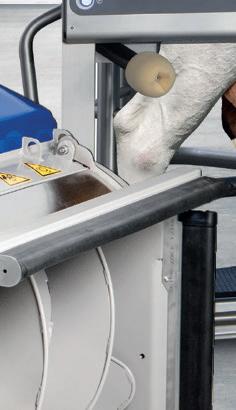


11 ON FARM JUNE 2023
your new team members Find out more • DeLaval feed pushing robot OptiDuoTM • DeLaval milking robot VMSTM V300/V310 • DeLaval manure robot series MAKE YOUR TEAM COMPLETE www.delaval.com
Meet
Alex Rawle and Liz Birkett of Rookhaye Farm in Wiltshire. PICTURES : Nigel Goldsmith
changes have already produced a return on investment.”
e cows are run as one group for feeding, with the total mixed ration fed to maintenance plus 35kg and comprising grass and maize silage, soya hulls, rolled barley and vitamins and minerals. Meanwhile, concentrate usage is 0.38kg/litre.
e dry cow shed is also sand-bedded and has an adjacent straw-covered pen for calving. e dry cow ration is made up of straw, rapemeal, maize silage and minerals.

Balance
“ e ration is made speci cally for the dry cows and grass silage is not included, in an e ort to achieve the correct balance of potassium and calcium,” says Liz.
“It partially follows the principles of DCAD [dietary cation-anion di erence] system.
e idea is to promote a more alkaline metabolic state, with the aim of reducing the risk of milk fever and preparing the cows for the following lactation.”
e farm land ranges from 400-650 feet above sea level and
the soil type is mainly chalk-based with a clay cap.
“ e elds can be prone to drought and the herd was not grazed last year as it was di cult to achieve target dry ma er intakes, due to the lack of rainfall,” says Liz.
“Logic dictates that it is be er to adopt a fully-housed system to give more control over the diet, but I like to see the cows out at grass and grazing has not been ruled out.”
e grass area totals 160 hectares (395 acres) and its rotation with the arable cropping has a positive e ect on soil health, as well as enhancing rst wheat yields.
ree or four silage cuts containing red clover are taken each year.
“One new development for this season is to bring rst cut silage forward and cut every ve weeks therea er,” says Liz.
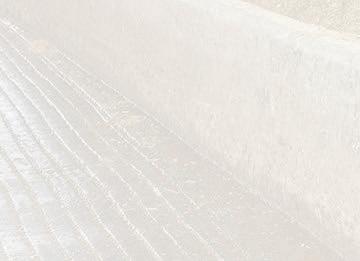
“ e plan is to produce high-yielding crops of uniform weights, rather than going for a bumper rst cut as we have in the past. Our grass and maize is managed with as much a ention to

detail as our arable crops, because we aim to maximise dry ma er intakes and produce as much milk as possible from forage.”
Liz, who is third generation on the farm, is currently planning her partial retirement.
Management is will leave Alex with the dayto-day management of the herd with the help of three full-time sta , some of whom also work on the arable enterprises on the 360ha (889-acre) holding, plus part-time help in the calf unit.
Milking frequency may
Farm facts
rThe 170-cow herd yields an average of 11,270kg at 4.33% butterfat and 3.39% protein on twice-daily milking
rMilk is sold to Muller on a Sainsbury’s constituents contract
rCalving is all year round
rThe herd replacement figure currently stands at 25%, while the calving index is 372 days
rFertility performance is another priority and the average pregnancy rate is 28%
be increased in the future.
“ e improvements have given us the facilities to make a move to three-times-a-day milking. It would increase milk yields by about 10% and help to achieve the full genetic potential of our cows,” says Liz.

“However, increased milking frequency would require additional sta and nding the right people is not always easy; we count ourselves very lucky to have a great team working on the unit.
“Mainly for that reason, the concept is still under discussion. In the meantime we will carry on with our e orts in trying to improve the herd genetics, while also being mindful of pro tability, cow welfare and the farm’s carbon footprint.”
12
FARM JUNE 2023
ON
Recent improvements to infrastructure have included new calf housing.
The farm aims to maximise dry matter intakes and produce as much milk as possible from forage.
Breathe new life into old pasture.

Forefront® T is a high performance herbicide. It is the most effective, broad spectrum weed control solution for grassland.
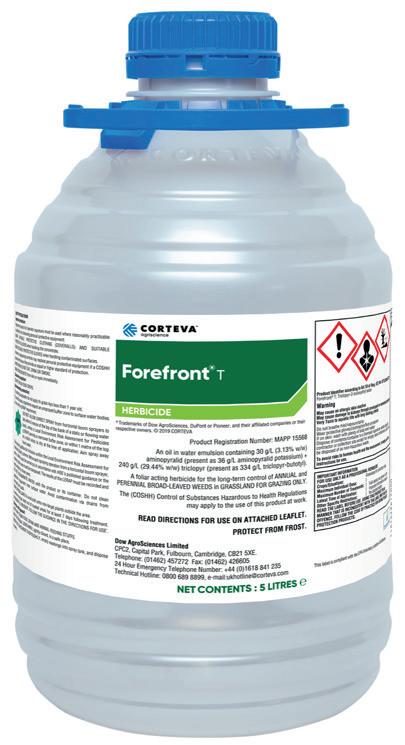
Use it on permanent pastures or grazing leys to control long established or high populations of weeds. It is your cost effective alternative to a full re-seed, quickly increasing the amount of available grass. Let your grass breathe again. Talk to your advisor or find out more at www.corteva.co.uk/forage




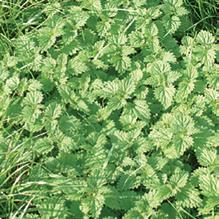

Keep in the know corteva.co.uk/signup @CortevaForage USE PLANT PROTECTION PRODUCTS SAFELY. Always read the label and product information before use. For further information including warning phrases and symbols refer to label. Corteva Agriscience UK Limited, CPC2 Capital Park, Fulbourn, Cambridge CB21 5XE . Tel: 01462 457272. ®, ™ Trademarks of Corteva Agriscience and its affiliated companies. © 2023 Corteva. Forefront® T contains aminopyralid and triclopyr. Technical Hotline: 0800 689 8899 E-mail: ukhotline@corteva.com Nettles Thistles Ragwort Buttercups Dandelions Docks
DAIRYMatters ‘The magnitude of net zero for dairy farmers’
This month, Dugald Hamilton, of the Agricultural Mortgage Corporation, discusses some of the practical steps dairy farmers can take to reduce carbon emissions on their farms and pave the way for a greener, cleaner future.
The NFU has set the ambitious target for the agriculture industry to achieve net zero by 2040, which is 10 years sooner than the national target set by the UK Government. For the dairy sector, this is a big mountain to climb.
When it comes to the subject of greenhouse gas emissions and farming, the dairy sector is often in the spotlight for the all the wrong reasons.
With almost 75% of energy contained in feed and consumed by cows converted into methane, the very nature of dairy farming presents a real sustainability challenge.
Alongside this, feed production and imports account for more than a quarter of the emissions from milk production, while nitrous oxide emissions resulting from nitrogen turnover in soil from the use of synthetic fertilisers and manure and excreta deposited during grazing all contribute to a net zero headache.
So where should dairy farmers prioritise reducing emissions? Given the magnitude of the net zero journey for dairy farmers, it is important not to attempt too much too quickly, making small changes initially.
One of the first steps is to calculate the annual carbon footprint of the farm. By identifying a base level and the areas with the greatest emissions, it makes it easier to decide where efforts should be focused.
Reducing emissions
JDugald Hamilton maps out eight immediate practices dairy farmers can implement to reduce emissions:
rImproving animal health to reduce respiratory, lameness, mastitis and disease issues
rImproving energy efficiency
rFeed efficiency through reducing crude protein and maximising forage quality
rFertility management, optimising replacements and breeding the next generation of cows

rSoil management through mob grazing
rFeed additives to reduce methane production
rLow-emission slurry spreading and covering slurry stores
rUrea-based fertiliser management
Considering how to improve managing the health and welfare of the herd can result in improved milk quality, lower mortality and limit negative consequences of disease.
It is also worth improving energy efficiency through heat recovery systems, as this can reduce carbon dioxide emissions by reducing water heating costs and provide heated water every time milk is being cooled.
Heating can account for about one-third of the energy used in a dairy parlour and using this practice can half it, so it is an investment worth making.
Arguably the most important step to reduce on-farm emissions is improving feed efficiency. This can be achieved by using higher quality feeds and supplements and by increasing the level of nonstructural carbohydrates in the cow’s diet. These will reduce daily methane emissions per cow.
It is also worth reviewing feed supply chains to reduce embedded carbon factors. This can be a
14 JUNE 2023
Dugald Hamilton
Arguably the most important step to reduce on-farm emissions is improving feed efficiency, says Dugald Hamilton.
reasonably easy measure, by simply choosing to import feeds closer to the farm.
While farm replacements maintain herd size, they should be genetically superior to culled cows to contribute to the e ciency and productivity of the farm.

Genetic improvement should be combined with a replacement strategy to improve performance, while also increasing pro tability.
A er all, improved genetic merit can enhance health traits and increase longevity, help to control and eliminate endemic diseases, while also improving management of fertility, pregnancy rates, calving and replacements.
It is also worth looking to adopt regenerative grazing strategies, such as mob grazing, as this can successfully reintegrate farming practices with nature, while making farming businesses more resilient.
Grass which receives a longer recovery period can improve soil health and therefore cow health, while also producing lower costs due to reduced inputs.
And nally, converting to low-emission spreading techniques can reduce contact with the air and reduce ammonia emissions.

To do this well, farmers can use slurry covers, exible sheeting systems and covers to help keep out rainwater which reduces storage capacity, while also maintaining slurry nitrogen value.
Guidance
Seeking sound business and funding guidance to support a farm’s journey to net zero can be key to success, as the initial outlay of investing in more sustainable farming methods can be considerable.
At the Agricultural Mortgage Corporation, we are working with the UK’s three leading carbon calculator tools in their mission to help farmers transition to net zero and can o er lending support for a broad range of investments in sustainable agriculture. Conquering the transition to net zero may not necessarily be easy, but it is an essential journey for all farmers.

15 JUNE 2023 Call us on 01772 690131 FILL A BAG WITH YOUR COLOSTRUM PASTEURIZE IN THE BAG STORE IN THE BAG WARM & FEED IN THE BAG WHAT’S MISSING? Answer = Bags for Colostrum. Simple & Hygienic. Scan here with your phone camera for more information G
ADVICE • QUALITY • VALUE 2022-11 Udda Bags Advert_210mm X 77mm_09_22 copy.indd 1 31/03/2023 14:21
“ Genetic improvement should be combined with a replacement strategy to improve performance
Shepherd Animal Health
Dealing with flies
One of the most serious fly-transmitted diseases is summer mastitis, an infection that usually occurs between June and September.
It is caused by a range of bacteria and is estimated to cost £250-£300 per case.
Katie Arrowsmith, of LLM Farm Vets, says: “A maiden heifer with summer mastitis may lose a quarter, reducing her productivity potential and her resale price. It is also a very painful condition.

“Teat sealants and antibiotics can help, but minimising fly numbers should be a key element of any management programme.”
Another disease carried by flies is New Forest eye, which is a bacterial infection transmitted by face flies.
Ms Arrowsmith says: “It causes extreme pain and cattle can develop
Parasitic wasps
JA fairly recent innovation for tackling fly populations is the use of parasitic wasps, says Ms Arrowsmith.
Unlike chemical products, which can be harmful when used in a closed environment, this biological control method does not pose a risk to human health.
“Parasitic wasps are 1-2mm-long insects which parasitise fly larvae.
“They are native to the UK and offer an environmentally-friendly
an ulcer on the cornea which causes temporary blindness.
“New Forest eye can spread rapidly through a group of cattle and individuals will need antibiotic treatment in order to recover.
“In addition to the physical effects, flies can be a constant irritation to livestock, with a negative effect on feed intakes. There is an accompanying risk of weight gain losses and a potential milk yield penalty.
“Research in the USA has indicated that a stable fly infestation, for example, can cut milk yields by almost 140kg/head per annum.”
Methods
She explains there are five main fly species which affect UK herds –head flies; stable flies; house flies; face flies; and horn flies – and the same control methods will apply across the board.
The majority of standard chem-
alternative to chemical products. Another benefit is that there is no risk of the development of resistance.”
Producers who purchase parasitic wasps will buy the insects by the bag, with one bag normally being sufficient for approximately 50 head of cattle.
The main period for the distribution of the wasps is from March until November.
“The recommended number of wasps required will depend
ical fly control methods contain pyrethrins and pyrethroids. Among these are pour-on products, as well as fly traps, fly strings and fly sprays.
“There have been increasing reports of the development of resistance for both of these active ingredients,” she warns.
“One alternative option is fly bait, sold under the Sheila brand, which has azamethiphos as the active ingredient. The bait uses a pheromone to attract the flies and they are killed when it is consumed.
“Sheila granules can be spread on trays and placed in areas where
on farm size, cleanliness and the severity of the fly problem.
“In our practice, the bags will be delivered by a veterinary technician and wasp numbers will need to be replenished periodically. This is because the fly lifecycle is shorter compared with the wasp and therefore the flies can multiply at a more rapid pace.”
Ms Arrowsmith recommends that producers take a proactive approach to the problem of flies.
flies congregate, including farmyard manure heaps. One factor that is common to all these prevention methods is that they will require regular top-ups to keep on top of fly population numbers.
“Eartags that are impregnated with a pyrethroid fly killer can also be a useful control tool, especially for insects that gather around the animals’ faces. They have the advantage of generally remaining effective throughout the grazing season.”
Environmental fly control methods can be used alongside specific treatment products, she adds.
“A combination of chemical fly control, taking precautions to discourage flies in the environment and the use of parasitic insects is probably the optimum way of keeping fly populations under control.
“If no action is taken, fly numbers can build up quickly.
“This will increase the risk to livestock and potentially lead to infections which can incur significant costs to the business,” she says.
16 VET’S
JUNE 2023
VIEW
Flies are not just a nuisance; they also carry disease which can cause problems with cow health and welfare. So what are the options for fly control? Wendy Short reports.
Many y species are a racted to water, so fencing o water courses can help, while the area surrounding water troughs should be managed to reduce poaching, which in turn can increase the level of standing water.
Where possible, ca le should not be grazed close to manure heaps and kept away from slurry lagoons.
e adult ies on the farm are only the tip of the iceberg, making up only 15% of the threat to livestock, while eggs and unhatched larvae (also known as pupae) combined represent 85%, in terms of numbers. erefore any measures

to control the adult population can only be partially successful at best.
TAKING THE GUESSWORK OUT OF HERD MANAGEMENT
The SenseHub® monitoring system from MSD Animal Health collects data from millions of dairy animals worldwide and interprets this information to allow farmers to make decisions which improve the productivity and well-being of their herd.

Welcome to a new monthly column from MSD Animal Health UK, in which we will be explaining how the latest generation of herd monitoring systems can improve the productivity and well-being of high-performing dairy cows.


In the coming months we will look at how our SenseHub technology can improve heat detection and artificial insemination success rates in maiden heifers and hard-working dairy cows.
We will also discuss how the system’s rumination monitoring function allows you to spot the early signs of potential health issues so animals can be evaluated and, if necessary, treated. The SenseHub system does all of this through the use of neck collars and/or eartags, which collect data around the clock.
This data is analysed by the Sense-
Hub app, which uses algorithms to highlight when cows are in heat or when they are under stress and intervention might be required.
This information is presented as simple charts, heat detection alerts and health alarms which enable herd managers to make quick and accurate decisions to increase their herd’s productivity and well-being.
In effect, SenseHub has three main functions which take the guesswork out of herd management:

1. Class-leading heat detection.

2. 24/7 rumination monitoring which detects potential signs of ill health before clinical symptoms have developed.
3. The ability to assess animals on a group basis enabling herd managers to fine-tune their management protocols to ensure all animals remain healthy and productive.
17 JUNE 2023 17 JUNE 2023
SPONSORED CONTENT To find out more about the SenseHub system, please call the SenseHub team on 01207 529 000. Alternatively, to send us an email, please contact us at allflexuk@msd.com For more information, visit farmersguardian.com/MSDSenseHub SenseHub
cure, or prevent any disease in animals. For the diagnosis, treatment, cure, or prevention of disease in animals, you should consult your veterinarian. The accuracy of the data collected and presented through this product is not intended to match that of medical devices or scientific measurement devices. DF June p17 MSD half vert KJ (Signed off).indd 3 12/05/2023 14:38
is not intended to diagnose, treat,
Katie Arrowsmith
A combined approach is recommended for controlling flies.
Acomparison of ca le feed conversion e ciency illustrates the critical importance of monitoring youngstock performance, says Liz Newman of Advanced Ruminant Nutrition.

She says: “Extensive research has shown that the most coste ective period for weight gain is from weaning to six months.
“A heifer calf on milk will convert feed at a ratio of about 2:1, but conversion e ciency declines with age, so it is essential to maximise growth rates during the early rearing period.
“A heifer should reach 55-60% of her predicted adult weight at bulling and 85-95% by the time she calves. Hi ing these targets will require regular weight monitoring.
“Five weigh sessions in the rst six months is the ideal for adult weight prediction and service date identi cation. Nevertheless, it is be er to take fewer, but accurate, weights, rather than using frequent ‘guesstimates’.
“Some producers can run calves through a weighbridge direct from the pen, while others have to move them some distance away and obviously that can be time-consuming.”

Where possible, calves should be weighed individually, she says.
“However, sample weighing is certainly preferable compared
The old adage, ‘if you can’t measure it, you can’t manage it’, is highly appropriate when it comes to weighing routines for youngstock. Wendy Short reports.
Adopting a routine for weighing youngstock
with no weighing. Try and get a true sample, possibly selecting all the calves with either odd or even tag numbers, for example.
“Another option is to weigh the rst batch of calves which are caught. Avoid sampling twins, because that can skew data.
“ e same calves should be weighed every time when using a sample system, and weights should be taken from a minimum of 10 individuals in a pen of 20 animals.
“ e weighing routine may highlight calves which are signi cantly above or below target. is allows action to be taken at an early stage and will help to improve group uniformity.
“It can provide an alert that something is going wrong and that should prompt a management review. In some cases, weaning may have been too abrupt or the pen groups are too large.
Dehorning
“Another common cause of growth checks is dehorning too close to weaning time. Most issues are linked to stress and the causes are usually farm-speci c.”
Electronic weigh scales used in combination with a calf crush are a worthwhile investment, given the vital role heifer weights play in future performance, Ms Newman says.
“I have found it di cult to achieve accuracy using a height stick, particularly because most ca le will not stand still for long enough to take a proper reading.
“A weigh tape can be a viable alternative to electronic weighing, but it should be done by the same person every time because there will be slight di erences in technique.

“I have experimented by using electronic scales followed by a weigh tape and the results
It is not always practical to weigh heifers regularly, but fewer accurate weights are more useful than more frequent ‘guesstimates’, says Liz Newman.
have been around 2kg di erence either way.
“ e calf would need to stand in a ‘show’ pose, with a leg in each corner and her head up, to use a weigh tape correctly. In reality, most will have their heads down a er being restrained and that can change the reading by several kilos.”
Ms Newman advises producers to compare their ca le weight gain gures against other farms.
She says: “Most farms have some system of weighing heifers and a number of feed rms and vets o er the opportunity to join a benchmarking scheme.
“ is is very useful for identifying practices which have the potential to improve performance.”
She urges producers to maintain a weighing routine.
“Some units will stop weighing heifers a er the six-month stage, but I would encourage its continuation. Studies indicate that calving at 22-24 months is the most pro table option and a period of rapid growth is required in the run-up to service to reach this goal.
“Heifers will need to have had
18 YOUNGSTOCK JUNE 2023
Heifers will need to have had a first oestrus by 13 months and it may take multiple services before they hold
LIZ NEWMAN
a rst oestrus by 13 months and it may take multiple services before they hold. If the average cow weight is 660kg, a heifer
should weigh 380kg at service if she is to calve successfully.
“Judging service readiness by eye can be extremely mis-










Feeding for maximum weight gain
JAn 18% protein concentrate fed with straw is not sufficient to reach weight gain and frame goals for young calves, says Ms Newman.
“I recommend a 20% nut, plus access to high-quality straw. A total mixed ration containing silage can be introduced post-six months and the protein content of the concentrates can then be reduced to match the silage.
“Every farm is different, but in general, the overall dietary protein should be 15-16%, while ME should not generally rise above 10.5.
“Growing heifers are prone to laying down fat at the expense
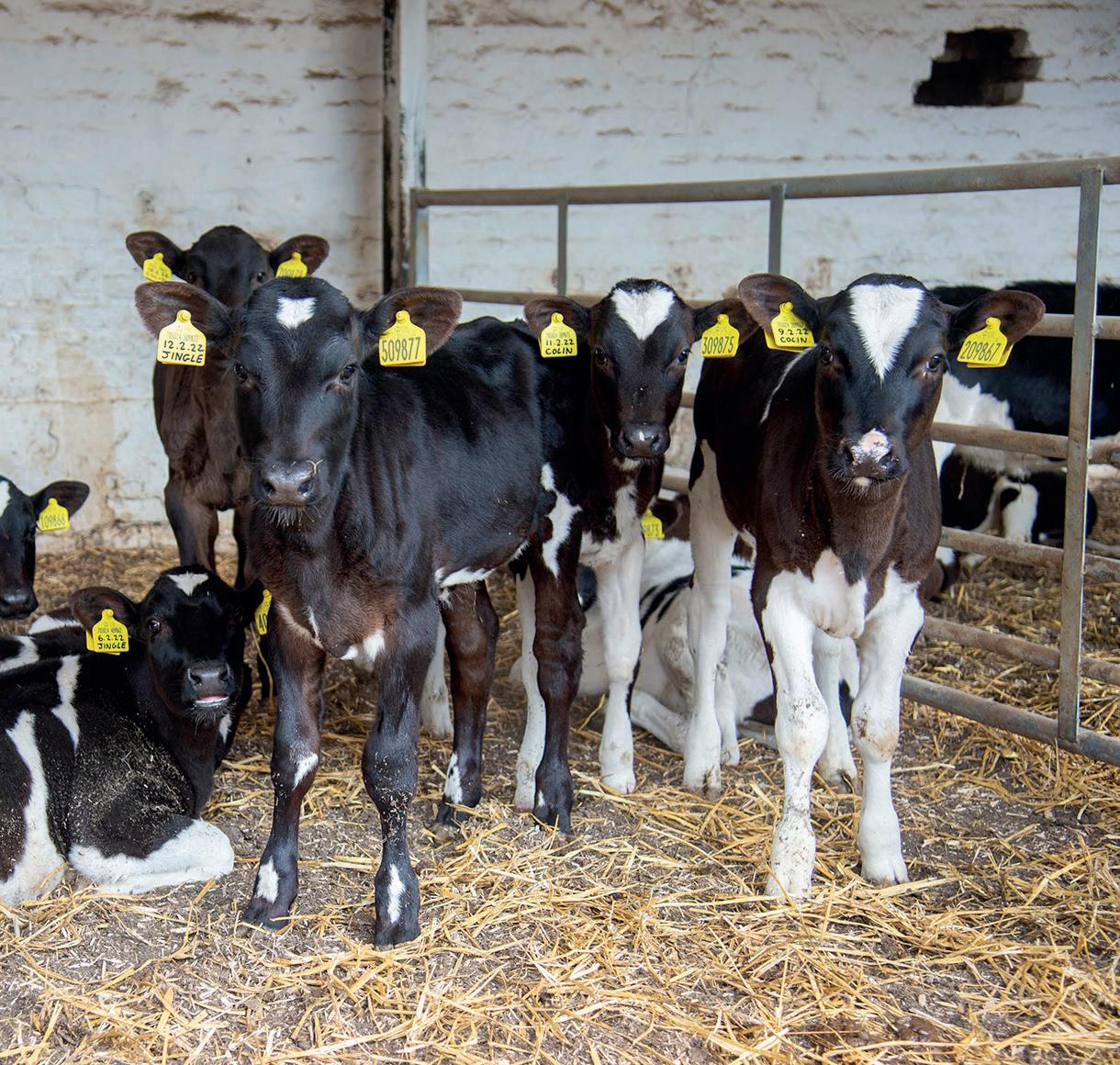
leading. Heifers can reach the appropriate weight at anywhere between 11-16 months, but they may not have developed
of frame. Encouraging skeletal and lean muscle development with a diet high in good-quality protein is essential for minimising fat.
“Regular body condition scoring, alongside weighing, will ensure heifers calve at the correct weights.
Same ration
“The same ration fed on two separate farms can produce very different results, with one group performing well and the other laying down fat. Formulations may look good on paper, but they will often need to be tweaked to individual farm requirements.”
the right frame. erefore, accurate weighing is the best way of making correct decisions about service dates.”









Are your cows insured this summer?
Feeding Equaliser® CoolCow costs around £20 per cow for the 150 day summer period and has been proven to maintain fertility, foot health and yield performance.


T (01845) 578125


E customerservices_dalton@cargill.com
@CargillAnimalUK

19 YOUNGSTOCK JUNE 2023
Dairy farming in South Africa is not without its challenges, but British ex-pat Mark Holliday says things are starting to look more positive. Chris McCullough reports.

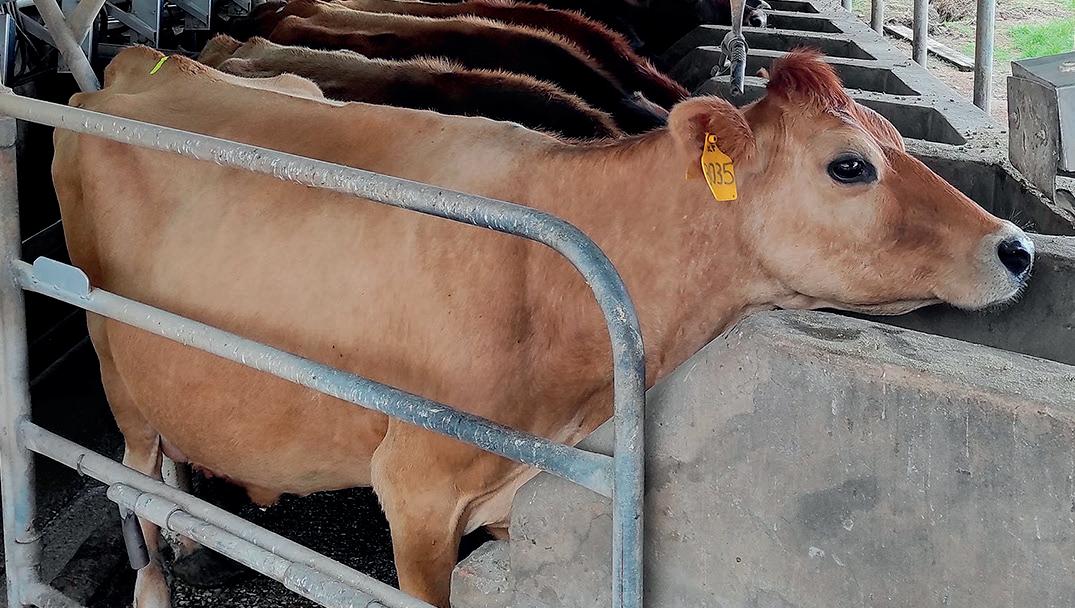
A farming environment with unique challenges
Back in 2001, Mark Holliday and his family sold their farm in Silloth, Cumbria, and bought Sunnyside Farm in Je reys Bay, in the Eastern Cape province of South Africa, where they now milk 900 cows.
It has been quite a rocky journey for the family, says Mark, with many obstacles and challenges along the way, including farm attacks and the s, disease, poor soils and recently a lack of power.
However, he adds that things are now starting to look more positive.
Sunnyside Farm is 840 hectares (2,076 acres), of which 115ha (284 acres) are irrigated, 70ha (173 acres) are unirrigated pasture and the balance is natural grazing.

Mark says: “ e farm was rather run down when we bought it; the soils were thin, rocky and contained no natural fertility, but it was good value for money.”
e farm’s Jersey cross Holstein cows weigh an average of about 450kg, and achieve an average annual yield of 6,500 litres.
Mark says: “We benchmark with a number of other farms, and on a per 100kg liveweight basis,

our cows’ weight performs the best in our conditions.
“We also nd that bigger cows struggle to walk in the heat, and ultimately cull themselves through poor fertility.”
Mark has been cross-breeding his herd for over 20 years using only the Jersey and Holstein breeds, as they o er the biggest choice of bulls.
Breeding
He says: “Anything that looks like a Jersey cow is bred to Holstein, otherwise Jersey is used. On the cows, the ratio is about 70% Jersey and 30% Holstein.
“For calving ease, all heifers are put to Jersey. We only use bulls that have at least 1,000 daughters classi ed, and from these we select on udders, feet and legs.”
He adds that the benign climate means cows can graze all year round.
“Because we are so heavily stocked, supplementary roughage is fed at pasture.”

e farm employs 15 sta and two assistant managers on the farm, and Mark says most of the sta are unskilled manual labourers on a minimum wage of
R23.19 (£1.12) per hour. e farm uses an 80/40 swingover parlour with a combination of Waikato and Delaval kit to milk the cows.
Mark says: “Rotaries have become very fashionable here, but I prefer the simplicity of a herringbone, and labour is not a problem. We feed concentrate in the parlour using a couple of locally made trolleys which run up and down a rail.”
Milk is sold to Coega Dairy at Port Elizabeth. Mark says: “ e factory was set up 10 years ago as we were having di culty growing our production in this province at the time.
“Twelve of us put money in based on cow numbers. e factory produces UHT and cheese,
mostly for a takeaway pizza chain. Because the core product UHT is a commodity, we can never expect top milk price. However, we have no quota, and can grow at will, and can produce seasonally, though there is a penalty for this.”
e milk price is currently R6.45 (31p) per litre and Mark says while this is the best price the business has received for a while, margins are still poor due to feed, fuel and fertiliser prices.
Pasture
e farm’s irrigated pastures consist of a base of Kikuyu grass and perennial ryegrass planted each year, which can produce over 20 tonnes of dry ma er (DM)/ha per year, if there is enough water.
20 WORLD DAIRYING SOUTH AFRICA JUNE 2023
Pumping water for irrigation is a huge problem for Mark due to high diesel prices and high investment costs for renewables.
Jerseys and Holstein genetics have been used on the crossbred herd for over 20 years.
The farm was rather run down when we bought it [...] but it was good value for money
MARK HOLLIDAY
Unirrigated pasture is currently all planted with lucerne. e output is variable depending on rainfall, but is typically between three and seven tonnes/ha per year.
Feeding
Mark says: “Cows are fed a maizebased concentrate in the parlour, which is allocated to yield and stage of lactation.
“We also have maize silage and triticale silage grown on some rented land nearby, along with brewers grain, wet citrus pulp when in season, and bought-in lucerne only when really needed.


“Typically, 40% of feeding comes from grazed grass. e balance of the roughage is fed to the cows at the pasture in feeding trailers.”
When it comes to challenges, Mark’s list is quite long. He says: “ e news says farm a acks and crime in general are the biggest problems. However, our main issues are rising costs and stagnant






milk prices, particularly as we have unemployment over 50% and consumers cannot a ord milk.
“Currently, our country’s power grid is collapsing, leading to hours of load shedding every day. We have installed solar at the dairy which, combined with a diesel generator, works ne.

“ e main problem is pumping water for irrigation. Current diesel prices make pumping with generators extremely expensive, and using renewables even more expensive, as a huge investment will spend a lot of time si ing idle,” he says.
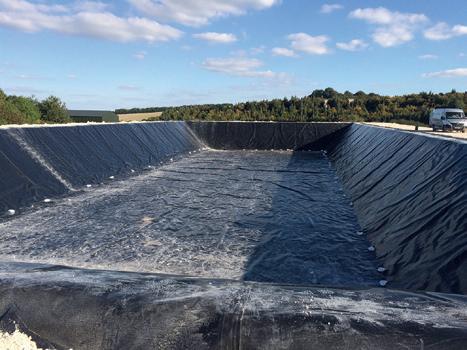
Mark is keen on new technology and has ambitions to expand his milking operations into Zambia.
He says: “I love technology, but we are limited as to what we can get support for. Dairy management systems are available and, on the whole, well supported.

“We also make widespread use of soil grid sampling, and all fertiliser and lime is spread






with variable rate spreaders.” Mark is involved in two equity partnerships, which develop farms from scratch.


Opportunities
He says: “When opportunities arise, we look at them, but a massive jump in land prices over the last few years has made South Africa much less a ractive.
“We have acquired a block of land in Zambia, which we are currently using to grow maize and soya, though the ultimate plan is to milk there, as there is a huge shortage of milk in the country.”
Farm facts
rThe Jersey cross Holstein cows are yielding 6,500 litres/cow/year
rButterfat averages




4.35% and protein 3.65%
rThe milking cows are run in one group and the dry cows run on the natural grazing ground in the winter to take some pressure off the milking platform
r75% of the herd calves in July and August, and the remainder in March and April

21 JUNE 2023 YOUR DEPENDABLE PARTNER FOR SLURRY STORAGE SOLUTIONS enquiries@enviroseal.co.uk t: 01695 228626 www.enviroseal.co.uk SLURRY LAGOON FLOATING COVERS Keeps rainwater out of slurry Reduces odour from lagoons Covers comply with EA and SSAFO legislation SLURRY LAGOON LINERS Comprehensive 25 year warranty Materials meet EA and SEPA requirements Installed and tested by certified technicians Enviroseal provide a complete range of products for slurry storage
The farm uses an 80/40 swingover parlour – labour is not an issue.
Two years’ worth of data from a Cargill study is proving that heat stress is affecting most UK dairy herds during the summer, with a dip in fertility being just one telltale sign. But how do dairy farmers combat the problem? Dairy Farmer reports.
South Lanarkshire-based dairy farmer Andrew Neilson has mitigated some of the e ects of heat stress and his herd is achieving more consistency in key performance parameters throughout the summer.

Andrew runs the 226-cow Overside pedigree Holstein herd, with his parents Hugh and Liz, on a high-input high-output system.
e herd is fully housed and the herd calves all year round with average yields of 12,300kg at 4% bu erfat and 3.44% protein, on three times-a-day milking, and milk is sold on an aligned Muller Tesco contract.
Andrew says: “Our system is designed to make the best use of our resources. Average rainfall is about 165cm – too high to have ca le out grazing.
“We did run late lactation and dry cows on grass, but conditions
Keeping heat stress at bay
were unpredictable. Intakes dropped and this a ected body condition and fertility su ered.”
So the focus is on making good-quality home-grown forage from the 142-hectare (350acre) unit.
Conditions determine cropping and although they cannot grow high-energy crops, they get the best from grass by reseeding regularly to maintain quality and, despite higher fertiliser costs, they still recognise its value.
Great care is taken to maintain
cow health and welfare and, as part of this, he is tackling heat stress issues.
Peaks and troughs
Andrew says: “We were seeing fertility peaks and troughs through summer. Our records showed a drop in submission rates, conception rates and pregnancy rates that we could relate to warmer and more humid weather.
“Our evidence was not particularly ‘scienti c’, but we could certainly pick up the trends

in freshly calved cows and those which were served in ho er spells. Also, it was noticeable that cows were not showing signs of heat.
“We would typically see insemination and conception rates drop between 5% and 10% during summer and these were very closely related to hot spells.”
High targets are set for the Overside herd. Andrew is anxious to make sure early lactation cows do not lose too much condition and are able to get back in-calf easily.
Cows are served a er a 50-day
22 HEAT STRESS JUNE 2023
Andrew Neilson has mitigated some of the effects of heat stress on his herd.


HEAT STRESS
voluntary waiting period and the current pregnancy rate is 25%, with a calving interval of 387 days.
Andrew says: “I wanted to see pregnancy rates improve and nudge towards 30%, and this meant ironing out the dips we were seeing in summer. It is all part of improving e ciency and our carbon footprint.”
Andrew keeps an eye on housing
conditions during summer, but he has also upped the game with more preventative measures.
He says: “It is the combination of temperature and humidity which causes heat stress in cows and it is this temperature humidity index – that really counts.
“We have to manage this to keep cows comfortable.”
In spring 2022, a talk on feed eciency and managing heat stress by GLW Feed’s Kerri Arthur prompted Andrew to add a specialised rumen bu er, which also o ers an internal cooling e ect, to the milking herd’s total mixed ration (TMR).
Andrew says: “We fed it at a rate of 150g/cow/day when it was particularly hot and 100g either end of
summer, adding it to the TMR from early June to the end of September.
Knock-on effect

“We have seen more consistent insemination and conception rates, with very li le dip, even in the hot summer of 2022. is has a knock-on e ect on our calving interval and on our annual milk production and herd e ciency.”
Maintaining feed intakes is integral to performance. With the help of nutritionist Hugh Kerr, they formulate a diet which encourages high dry ma er intakes, looking for average daily intakes of 24kg for fresh calved cows and 25kg for the whole herd average.
Andrew says: “We want to drive intakes, so we add 12 litres per head of water to the TMR to help this which is probably even more valuable in summer.
“We use sprinklers to keep them cool in the collecting yard.
“We are working with what we have and we have brought CoolCow back into the diet for this summer, so we reduce any risks of heat stress in our cows.”
Heat stress
JResults from a study by Cargill UK of conditions in housed milking herds in two summers – 2021 and 2022 – highlight the frequency and prevalence of lengthy spells of heat and humidity across all regions of the UK.
A trial also highlighted the impact of housing and feeding improvements on fertility –the first victim in periods of heat stress.
Data from monitors in 47 buildings housing milking cows across the UK from May to September 2021 and 2022 recorded the temperature and humidity index (THI) every 15 minutes and results are automatically updated on Cargill’s online THI website.

Cargill’s Donald Macleod says: “Temperature and
humidity combine to cause heat stress. Humidity is generally about 50-60% in the UK, although during the hotter drier heatwaves this can drop.”
Based on 60% humidity and a temperature of 14degC, which are common conditions in early summer in the UK, the THI is 57.
Cargill’s study showed that this THI was triggered across the UK on most days from May to September in 2021 and 2022.
If the THI averages 57 for at least 24 hours, research has shown that oestrus behaviour in cows can be affected.
A regional daily average THI of 65 or more was logged on at least 42 of the 153 days from May to September 2022, with the South recording this level on 38% of days.
Donald says: “This is the
THI level where conception rates will be affected, and the consequences of heat stress become more costly.”
Studies also show that if daily average temperatures equal or exceed 22degC (THI 68) for at least three consecutive days, milk yield, particularly protein, dropped.
Donald says that it is not just environmental conditions which are heightening the risk of heat stress.
He says: “Today’s highproduction cow also produces a lot of metabolic heat. Cows producing 46kg of milk a day produce 26% more metabolic heat than one producing 32kg of milk a day.”
Cargill looked at fertility performance on eight farms where THI monitors were installed
and compared the effect on fertility in the highest THI weeks of summer where no action was taken and where fans and the specialised rumen buffer Equaliser CoolCow was included in diets.
The results showed that if no action was taken, conception rates were seen to fall by up to 50%, from 40% at a THI of 60 to only 20% when the THI exceeded 65. Where fans or the specialised rumen buffer or both were used, the effects of heat stress were less, with the best improvements seen where a combination of both were used.
In this case, conception rates remained more consistent and only dipped from 40% to 35% as the THI increased from 60 to 65 or above.
24
JUNE 2023
Maintaining feed intakes is integral to performance.

TRANSFORM HOW YOU FEED YOUR HERD With Feedlync’s weigh system & feeding app you can: > Quickly & easily analyse your feed accuracy > Instantly save money by reducing feed waste > Access your data instantly from your mobile anywhere, anytime > Integrate with your processor, herd management, nutritionist and more! Speak to our friendly team today to find out more! Call +44 20 3966 90 63 or visit www.feedlync.com
DAIRY FARMER OF THE YEAR
A crisis around his milk contract prompted Gordon Davies to launch into new business territory, a move which saved the farm and prompted an admirable succession plan.
Danusia Osiowy nds out more about the journey of last year’s Dairy Farmer of the Year.
Gordon Davies and his family are rightly proud of their dairy farm business and the results they have collectively achieved after facing challenging times in the sector. When the milk market was at one of its lowest points in 2015, the Davies family lost their contract after the decision was made from their buyer to retire. The only option was to find a new market for their Channel Island milk and what followed changed the face of the business.
Gordon, who has farmed the pedigree Rivermead Jersey herd for 11 years with his wife Hazel on
A word from the sponsor
XThis award recognises those who are brave enough to challenge conventional thinking and bring fresh ideas to our industry.
As an innovator in feed, KW Feeds is looking forward to celebrating some of the most brilliant thinking, ideas and innovation in dairy farming today.
Richard Slack, head of commercial at KW Feeds, says: “Our dairy industry never stands still. Great dairy farmers are constantly looking for new and better ways to improve performance, increase standards and lower emissions.
“As a trusted partner to some of Britain’s top performing dairy farms of all sizes, we are proud to recognise businesses which share our commitment to innovation and are brave enough to make change for the better.”
a Farm Business Tenancy (FBT) with Devon County Council, researched the trends around the dairy product and found Channel Island Milk was used in ethnic foods and for making Indian desserts and puddings.
They then formed a company with a cheese expert and began marketing their own milk in a factory in London and worked with other local farms in the area which were in the same predicament.
Control
Gordon says: “Setting up the second dairy business has allowed the family to be in control of their own destiny. Diversifying has allowed us to purchase new equipment and invest in facilities and staff.”
Gordon, whose cows produce about two million litres of highquality milk and constituent each year, purchases a further 4-5m litres from Jersey milk producers across the south of England.
In total, with a collection pool from 17 farms, 14m litres of milk is purchased to produce a range of products, including paneer cheese, mozzarella, yoghurt, Indian desserts and ice cream to areas of London, Leicester and the South West.
His daily role sees Gordon lead on dairy logistics and transport with their tanker fleet, but with a strong circle of support surrounding him, strength lies in teamwork.
Hazel helps rear calves and eldest son Mark leads the management of the 280-head herd of Rivermead Jerseys, concentrating on the breeding and high health status of the herd and marketing any sale of cattle.
Second eldest son Kevin is a keen stockman and manages the staff and day-to-day running of the farm, along with crops and harvesting.
Daughter Emily is undertaking
her final year at university, but heads up the calf rearing, with a particular interest in showing livestock and genetics.
Gordon says: “As a family we are all stockmen and every one of us has a passion for dairy cows and livestock. It is that passion which has progressed through to our grandchildren, along with the desire to have good cows and stock.
“I believe that what gives young people a good work ethic is being able to go to work and have fun. For us as a family and a business, what drives us is enjoying what we do and working with the people we do, be it staff, suppliers or customers.”
Animal health, welfare and performance take equal precedent at Westcott Farm, which comprises 101 hectares (250 acres).
A further 18ha (45 acres) is rented from the same landlord on a short-term tenancy and a further 22ha (55 acres) rented from a private landlord on a five-year FBT. Noted for its success on the show circuit, the Rivermead herd is fully housed and co-run by stockman Richard Saxby.
Gordon says: “There is an emphasis on cow health and welfare. Examples of this include the herd’s strict Johne’s
SUSTAINABLE PRACTICES
XThe dairy has upgraded the fleet of lorries to meet Euro 6 requirements
XThe business continually reassesses logistics to try and reduce food miles
XSets aside wilding areas in fields
XPlants wildflowers in areas adjoining natural habitats, such as along the side of the motorway and railway line
XWorks to reduce flood water with the Environment Agency
As a family we are all stockmen and every one of us has a passion for dairy cows and livestock. It is that passion which has progressed through to our grandchildren, along with the desire to have good cows and stock
Gordon Davies
disease control strategy and our commitment to reducing antibiotic usage, with only 4% of the herd receiving a dry cow tube at drying off.”
Attention to detail is all part of their focus on sustainability.
Gordon says: “The general public may well demand far higher welfare standards and accountability than they do presently. We, as farmers, need to be prepared for this and answerable to it.
Accountability
“We need to ensure our business and our farm suppliers are accountable for their actions and present a good image to the public at all times.”
The subsequent impact of the change in direction of the business is considerable and is positively reflected across the entity.
Gordon says: “As the business grows and becomes more profitable it becomes easier for everyone to do their jobs more efficiently and productively.
“This encourages the whole team to achieve more and grow the business further.




“Our business has grown to a stage where we can focus more on cost control production and management methods, as we can employ good staff and concentrate on managing our business.


britishfarmingawards.co.uk 26 JUNE 2023
Vox Conference Centre, Birmingham Thursday, October 19, 2023
“In the early years it was extremely difficult to manage three of the five businesses when we were busy collecting and delivering milk or milking the cows. It is now easier to focus our time on managing the business, investing in it and enjoy working in it.”
BUSINESS AIMS


XControl costs and management methods
XPresent a good public image at all times
XPrepare for rising energy and fuel costs
XProduce high quality milk from healthy cows
Gordon’s passion for the dairy industry is palpable, which was one of numerous reasons he captured the attention of judges and went on to win Dairy Farmer of the Year at last year’s British Farming Awards.
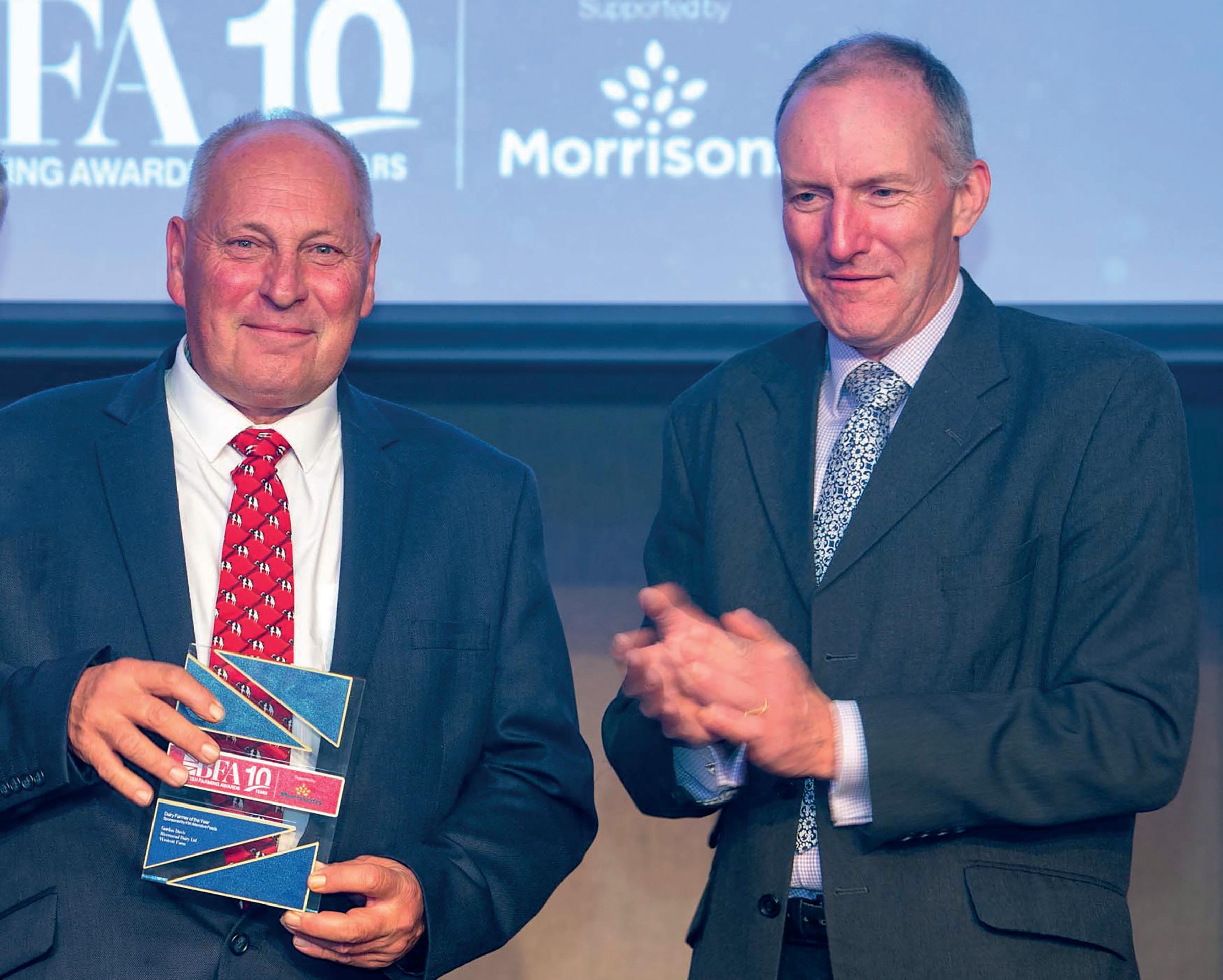
He says: “I am proud to be a part of an incredible industry which has only grown through adversity.
“It is a tremendous pleasure to work with people who have a passion, a smile on their face and want to improve. This may be to make a cow give more milk, run the transport logistics more efficiently or to look at the accounts and adopt a cost-saving measure.
“All of these things ultimately allow a business to become more
productive, more efficient and more tenable. A massive part of our own business growth over the past few years has been down to those strong and reliable relationships with our customers.
“Working closely with our farm suppliers means we are able to
ENTER OR NOMINATE NOW
XExploring new ideas and opportunities, you will be shaping your business to become more robust, sustainable and adaptable against an ever challenging sector.
Whether you have a large-scale dairy unit or a smaller familyrun farm, using progressive technologies to improve
pay a fair price for the products we need. As farmers ourselves we understand the needs of our milk suppliers and understand fully the pressures which come with farming and I believe we need to take some responsibility for those suppliers.”
efficiencies or developing your chosen system into something more niche, you enjoy challenging conventional thinking.
ENTER OR NOMINATE
For more information on the category and the British Farming Awards, visit britishfarmingawards.co.uk
27 JUNE 2023
Gordon Davies (left) and James Hallett, regional sales manager (South) of KW Feeds.
Sponsored by
Herbal leys can be a game-changer for livestock farmers and nature-friendly farming. Chloe Palmer reports.
Herbal leys a ‘no-brainer’ for forage-based systems
Many farmers are finding that herbal leys will produce more with less and improve animal performance and the environment, says Ben Rodgers, of Catchment Sensitive Farming (CSF).

He has been running the White Peak trials of herbal leys across the limestone area in the Peak District.
He says: “Herbal leys are a ‘no-brainer’ for forage-based systems, as they offer many benefits over monoculture ryegrass swards.
“They do not require any fertiliser, but deliver similar or even greater productivity. And because the species in them are deep-rooting, they are recognised for their nutrient and mineral ‘mining’.
“We saw during the drought on many farms on the limestone last year that herbal leys were the only thing still growing strongly.
“The herbs and legumes prioritise root growth, which improves soil
structure, allows better access to minerals and nutrients deeper in the soil profile and aids water percolation during wet periods.
“Here in the White Peak area, we were looking at ways of building nature recovery connections between the species-rich limestone dales across intensively managed grassland.
“The herbal leys provide a habitat for pollinators and other species, but also a high-quality forage, with protein levels often several percent higher than ryegrass swards and with equivalent metabolisable energy levels.
“As a variety of species are included in mixtures, there is always one which is at its optimum growth stage, providing a much wider window for grazing.
“A four- to five-week grazing rotation on dairy farms will result in high-quality forage and good yields, while still maintaining sward composition.
“Plate meters do not work very well when measuring covers across herbal leys, because the varied sward structure is difficult to calibrate. Sward height is likely to be a more reliable measure.”
A partnership of White Peak farmers, CSF, Natural England, the Peak District National Park Authority and Severn Trent led the trials.
Methods
They experimented with different methods of establishing leys within improved permanent grassland, notably ploughing, minimum tillage and direct drilling.
Mr Rodgers says: “The main take-home message is that for the best chance of successfully establishing herbal leys into improved grassland, competition from the previous sward must be removed. Minimum tillage and direct drilling after glyphosate can be just as effective as ploughing.
“Seed to soil contact is paramount,
In the field Geoff Walton, Rising Sun Farm, Tideswell
JGeoff Walton experimented with direct drilling of herbal leys into grass and he is delighted with the results.
He says: “We took down the sward as far as we dare and let it grow back before spraying glyphosate, then applied about 9,000 litres/hectare of slurry. We harrowed it twice before shallow direct drilling in both directions and then flat rolling.
“We had an excellent take, but we did have quite a bit of chickweed to start with, but this went when we grazed it off with sheep.
“In the past, with some
grass reseeds we experienced some issues with pests such as frit, leatherjackets and wire worm, so next we will try drilling after a brassica break crop.
Lighter
“The first cut was slightly lighter than the equivalent ryegrass cut, but the second cut did far better than everything else on-farm, even though we only applied slurry to it.
“We have grazed over winter with sheep, but we steer away from set stocking, as sheep will selectively graze out all the herbs and the leys need a rest.”
Farm facts
rDairy and sheep, with most land lying at about 350 metres (1,150ft)
rStarted growing herbal leys in 2021
rDirect drilling following grass or forage brassicas
so good consolidation after seeding is vital, especially for smaller seeded species.”
Bob Marsden, CSF river basin co-ordinator for the East Midlands, urges caution before ploughing, as the trial results suggest in some circumstances, particularly warm spring weather, a ploughed seedbed can favour grasses at the expense of legumes.
Mr Marsden says: “We think this is because the release of nitrogen following ploughing encouraged grasses and herbs. It also resulted in more docks because it disturbed the seed bank.”
The trials experimented with a range of different interventions at establishment, with and without glyphosate. Slurry applications prior to drilling have proved to be key to success on many farms, Mr Marsden says.
“We found slurry applications
rUses a Vredo drill with a seed rate of 40kg/ha (16kg/acre)
rHerbal ley mix includes red clover varieties, plantain, burnet, lucerne, sainfoin, yarrow, common bird’s foot trefoil and chicory
28 HERBAL LEYS JUNE 2023
In the field Dilks family, Home Farm, Bakewell
JDirect drilling on an organic farm is difficult because of the weed challenge, according to Bob Dilks. After cultivations, the herbal ley was drilled using a modified slot seeder.
He says: “We cut the slot seeders off the drill and fitted rake tines to it so the seed flutters out of the back of it but is still calibrated. We then flat rolled it and used a Cambridge roll to put a crimp into it.

“The ley cropped well






are essential when direct drilling, because the soil is not aerated, so the old crop uses up any residual nitrogen in the soil when breaking down, leaving nothing
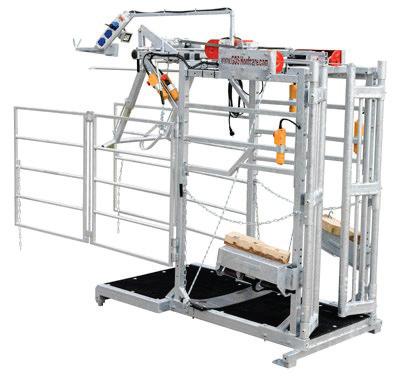
and analysed at 14% protein and 11 ME. We have also grazed the herbal leys and the cows love it, so we have to be careful they do not eat it down too far.
“After first cut this year we will
for the germinating herbal ley seeds,” he adds.
Maintaining the optimum pH in soils where herbal leys are grown is vital, Mr Rodgers says.

apply slurry either with a trailing shoe or the umbilical. All our herbal leys are in our Countryside Stewardship scheme and we have designed the rotation with the aim of maximising payments across the farm.”
“We found a pH of 6.2 is the minimum, but 6.5-6.7 is ideal on our local soils. Agricultural P and K indices of above two are also important for the leys to thrive. Herbal

Farm facts
rOrganic dairy farm across two sites

rAll land in organic Countryside Stewardship

r130 dairy cows, currently expanding to 180 cows; on once-a-day milking since March 2023
rGrown herbal leys since 2020
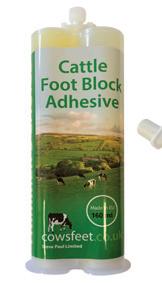
leys are not suited to low-fertility sites or old or valuable unimproved grasslands which are likely to fall into the Environmental Impact Assessment [Agriculture] regulations.”

29 JUNE 2023 Prefer to speak to a human? Give us a call on 01963 824448 "Thank you to Steve and his team for an excellent and very quick service and very competitive prices every time, thanks!” JOHNNY MILLER, LANCASHIRE LAMENESS WORKSHOPS October 22 £125 per person
Limited The UK's leading cattle foot care company TRIMMING • TRAINING • SUPPLIES Free next working day UK mainland & Ireland delivery ORDER BY 3PM when you spend £100 online excluding VAT Make your life easier with our Electric Farmer Crush Do ring us if you’d like more information!
Steve Paul
Cowsfeet advert Farmers Guardian 200x130mm March 2020.indd 1 14/02/2020 09:40
From farmer cattle crushes to wooden blocks, we have everything you need to keep your cows' feet healthy!
This special provides advice on feeding the dry and transition cow, suggests protocols for foot-trimming in the dry period and looks at the benefits of vaccinating against calf scour.
Getting the ration wrong for dry cows has two effects – a higher risk of production diseases and a lower peak yield, says Dr Dave Davies of Silage Solutions.
And to ensure diets can be formulated specifically for dry cows, as opposed to the milking portion, Dr Davies says it is useful to have two types of silage.
He says: “One should be high quality, about 12-12.5 ME with 16% crude protein for the milking herd.
“The second should be specifically for dry cows, ideally about 10 ME. D-value should be less than 60 and protein content should be around 10-12%.”
To achieve this, Dr Davies says grass should be in full seed head formation before cutting.
“This means we are not improving the nutrition of the cow; we are maintaining the same body condition score at drying off.”
Dry cows at pasture
Feeding dry cows effectively allows them to start their new lactation in the best possible metabolic condition, so how can farmers make sure they get the dry cow diet right? Dairy Farmer reports.
Importance of silage management for dry cow diets
He adds that, ideally, dry matter should be at 45% to encourage good intake levels to get the rumen working well.
He says: “High forage intakes enable the rumen wall to recover after the lactation diet, enabling elongation of papillae and better uptake of nutrients when they go onto the lactation diet.”
And while dry cow silage can be
for a maximum of two weeks and leave at least four weeks before using it again.
of lower nutritional value, Dr Davies says hygiene should never be compromised.
“Poor hygiene problems, such as poor fermentation with enterobacteria and/or clostridia or mould, will lead to a lower intake from the dry cow.
“High intakes get the rumen working well and ensure we can maximise forage utilisation in early lactation.”
He also says maintaining low potassium levels in silage is crucial for the health of cows during calving.
around calving. Therefore, it is essential to carefully manage grazing and silage production.”
Grazing and silage management are vital, and Dr Davies says it is important to avoid later cuts for dry cow silage in late summer/ autumn as potassium uptake into grass increases during this period.
Excess
dry cows over winter, managing dry cows at pasture is not without risk.
He says: “Exposure to different disease-causing bacteria and variable environmental conditions during grazing can increase the risk of clinical mastitis and high somatic cell counts for many dairy herds.”
To reduce these risks, Mr Ball says dry cows should be kept in the same lying area
Adequate pasture drainage should be maintained to avoid surface flooding or severe poaching, and dry cows should be moved to a different field if severe poaching of the land and/or gateways occurs.
Managing poaching around gateways/feeders using bark is also recommended. Housing conditions should be maintained as in winter if dry cows have access to housed lying areas during grazing.
Health issues
“High levels of potassium intake can lead to serious health issues, such as milk fever, hypercalcemia and retained placenta.
“Ideally, the potassium content in silage should be no more than 1% and it is recommended to avoid fertilising fields planned to be cut for dry cow silage with any potassium, which means leaving out slurry and using nitrogen-only fertiliser.
“Potassium in dry cows is one of the major causes of disease
Dr Davies says: “Managing grazing during autumn and early winter is also critical as leaving an excess during this period can reduce the quality of spring growth and increase the risk of aerobic spoilage and mycotoxins.
“Each year is different and it takes careful management. Grazing it off to get a clean regrowth at the start of the season is beneficial. I would be grazing it with sheep or cattle over autumn/early winter, up until New Year’s Day.
“This will allow the sward to be grazed down to the base and for fresh growth to start, allowing for an early first cut for the milking herd silage or a later first cut for dry cow silage.”
30 JUNE 2023 DRY COW MANAGEMENT
32 TRACE ELEMENTS What is needed? 36 TRANSITION COW The importance of getting nutrition right 38 HOOF HEALTH Trimming and footbathing 40 CALF SCOURS Impact of vaccinating your cows
JDavid Ball, AHDB senior technical knowledge exchange manager, says while planning silage for
Dry period feeding timeline
JFor dry cows, feed a bulky low-energy ration of 9-10

MJ ME/kg dry matter (DM)

JTarget dry matter intake of 12kg DM/cow/day
JFor cows between drying off to 21 days before calving,
do not overfeed, particularly starch, as this predisposes to poor transitioning
JFrom 21 days before the expected calving date, ensure the ration has long fibre, for example more than 3kg of
long chop which is at least 3cm in length
JSupplement with selenium and vitamin E, as low levels can affect the cow’s immune status and increase the risk of mastitis
JMonitor and maintain body
condition scores between 2.5-3 through to calving; do not allow cows to get fat
JMinimise stress and pen/group moves in the run-up to calving, as this can reduce DM intake

31 JUNE 2023
A silage made specifically with dry cow diets in mind should be made.
Trace elements can help ensure the dry period provides maximum benefits to the cow. But which trace elements are needed? Ruth Wills reports.
Making the most of minerals for dry cows
Abene cial dry period can in uence the future success of the cow’s lactation and the dry period has a number of functions, says Dr Graham Shepherd, founder of G Shepherd Animal Health.

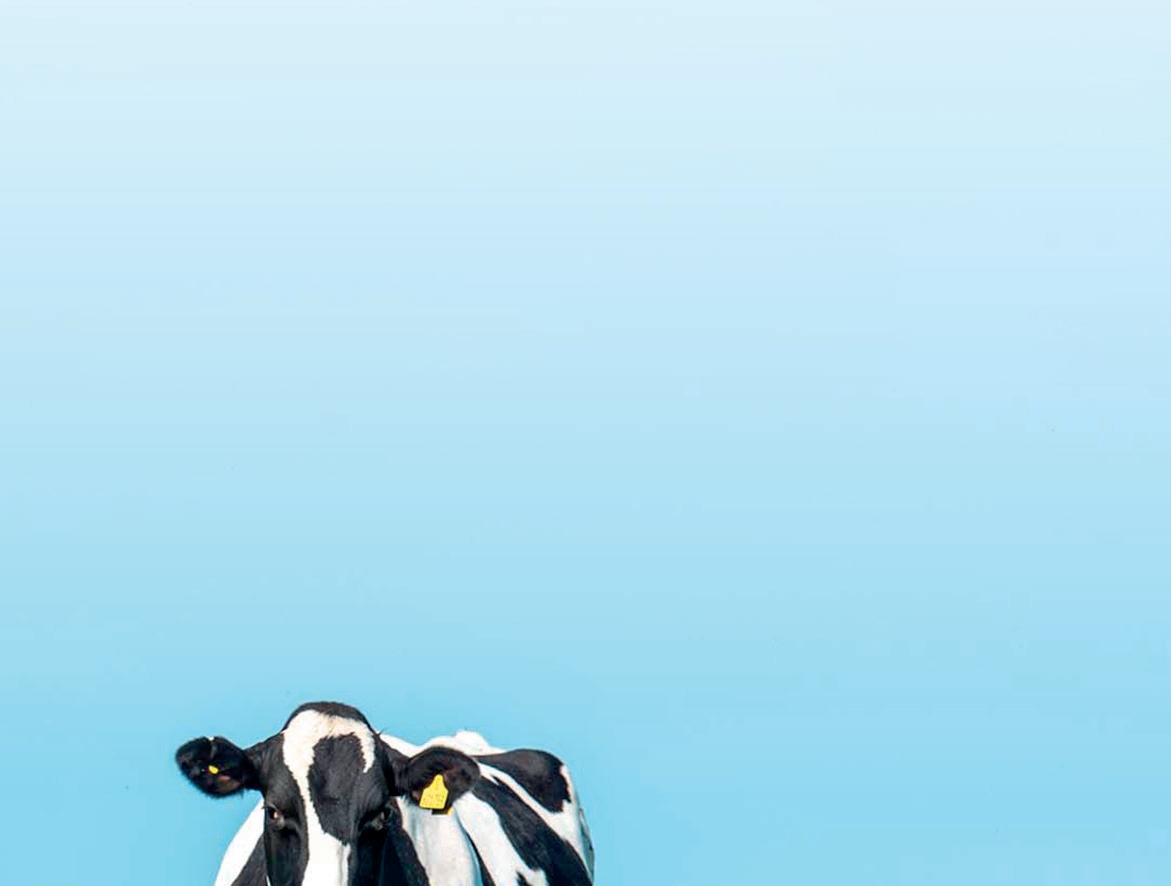
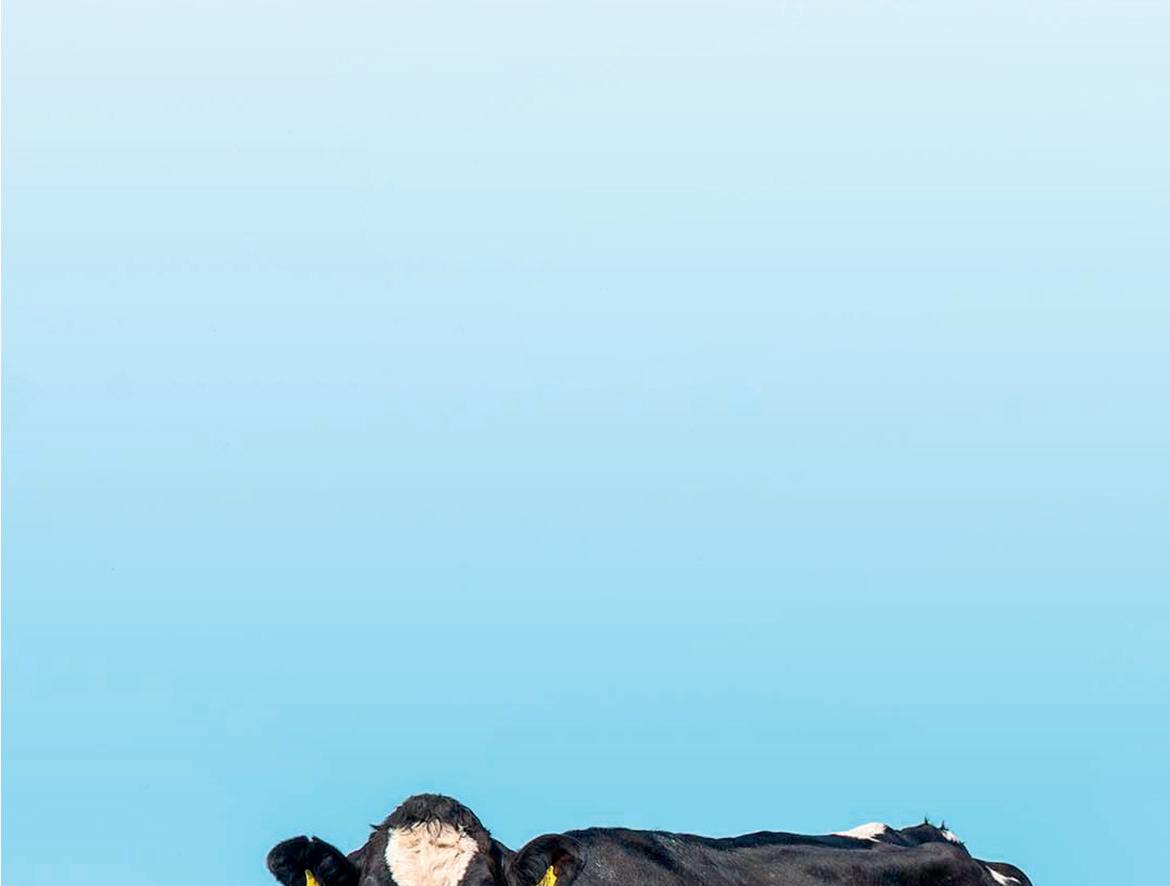
ese functions include stabilising body condition, evening out mineral levels, udder repair, controlling infection in the udder, healthy calf development and maintaining a good rumen function.
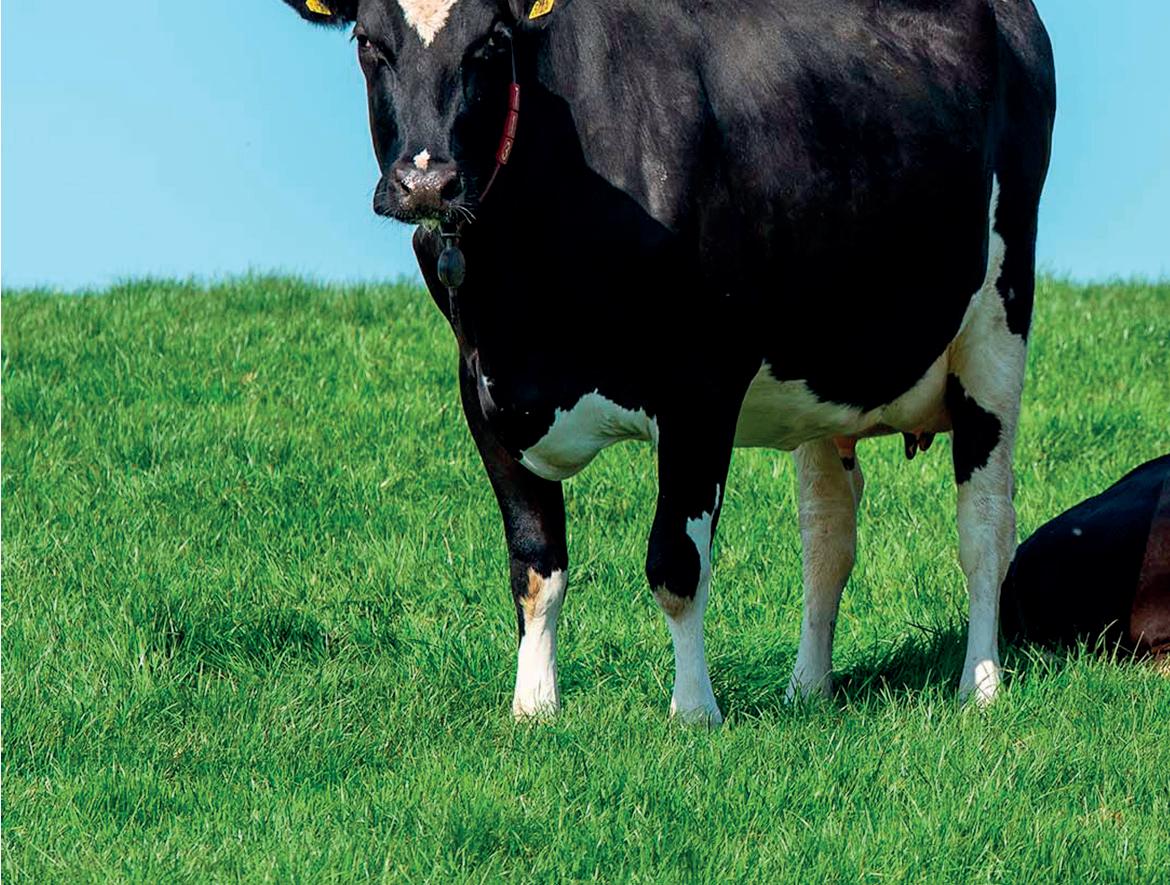
Dr Shepherd says trace elements and minerals can support the dry period, and a good starting point is to nd out what requirements are via blood tests, forage analysis or a liver biopsy.
He says: “It is important to build up a whole picture – a mineral pro le of the forage is a good way of doing that. And if there have been issues with fertility, or production suspected copper poisonings then liver biopsies would be prudent.”
Once it has been established which trace elements are required, it is helpful to understand how they bene t di erent functions (see panel).
“It is likely that some or all of those minerals will be needed, unless there has been a history of toxicity,” says Dr Shepherd. “But all requirements need calculating based on the results of samples.”
If available, chelated versions of minerals can o er higher availability, adds Dr Shepherd.
“Chelation is a process of a aching the mineral to a larger molecule – usually an amino acid – which covers it. Availability is enhanced by the body seeking to absorb amino acids for protein, so taking in the a ached mineral. is reduces interactions with rumen bugs and increases availability compared with the plain minerals. So, because the availability is high, a lesser amount of minerals will be needed. And because copper
and zinc are antibacterial, they will have an e ect on the bene cial rumen bugs unless they are chelated – that protects the rumen bacteria from the potential killing e ect of the copper and zinc.”
e most common way of ge ing these minerals into the dry cows is through the feed. Other options are boluses, in the water or feed blocks.
Dr Shepherd says: “ e best way would be through the feed ration. If not, then I would recommend boluses and, nally, mineral blocks. I recommend giving minerals in the feed due to consistent intakes, instead of mineral buckets which can have erratic intakes.
“Be careful not to accidentally feed too much of an element. For example, if the cows are fed a cake in the parlour which has copper in it, have access to mineral blocks in the eld which have copper in them, and are also being administered boluses with copper in them, it could lead to an excess of copper in the cow’s system – which can lead to poisoning.”
Macro-mineral nutrition is also



important in the dry period. “ ese are minerals required in the diet, including calcium, magnesium, phosphorus, sodium, potassium and chloride,” says Dr Shepherd.
Magnesium can help with calcium absorption around calving, as well as the cow’s metabolism, but farmers need to ensure the balance is correct with potassium as it can inhibit magnesium. But do not forget the basics, says Dr Shepherd.

“Never forget that an unlimited supply of clean water is vital. It is also wise to analyse the water for minerals, as di erent sources may impinge on health at calving.”
Minerals
rCopper: Important for energy processing, but can easily reach toxic levels

rSelenium: Aids immunity and muscle function, but toxic in excess
rCobalt: Key for immunity, energy and general thrift
rZinc: Benefits hooves, skin and hair

rManganese: Good for energy, skeleton and fertility
rIodine: Helps the growth hormone and calf vigour; iodine deficiency commonly causes stillbirths




32 DRY COW MANAGEMENT JUNE 2023 PICTURE
: John Eveson
Dr Graham Shepherd
three options to get the best feed value from your crop

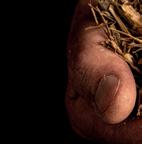
So
got



cereal
Lientjie Colahan, technical sales support at Lallemand Animal Nutrition, outlines what to consider as cereals start to mature and how to safeguard nutritional value.



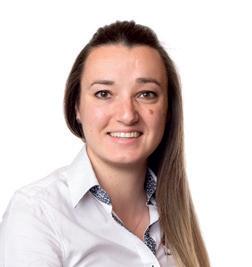


Wholecrop silage
1

Making wholecrop silage could reduce the amount of feed you need to purchase this winter. It can:



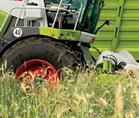


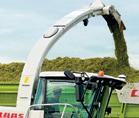

> o er a supplementary forage if grass silage is limited.
> give you another source of bre as the straw content balances less brous, highly digestible grass silage.


> supply starch as well as bre into the rumen.
> balance other highly acidic forages.

Things to consider:
> Wait until rst and second-cut grass silage has been analysed: if you need more forage and/or bre, wholecrop silage is a good option.
Using inoculants





Making wholecrop silage or crimping grains can be tricky. Using a speci cally tailored inoculant from Lallemand’s Magniva range helps you control the process – learn more with our guides, just scan the QR codes. Your local Lallemand contact can help with advice: to nd them visit: bit.ly/3EyloGN



2

Crimped grain
Crimping your grain can:

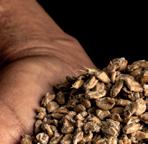
> provide a rumen-friendly source of starch which is cheaper than bought-in concentrate.


> keep straw available for feeding or bedding – just dry it for at least 48 hours.
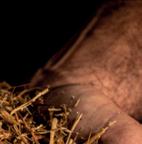
Things to consider:
> Handling & storage facilities: crimp is a very high value feed source prone to spoilage during feeding if not properly treated, so small concrete clamps work best.
> Grains should be harvested at a moisture content of 25 - 40% – typically two or three weeks earlier than conventionally

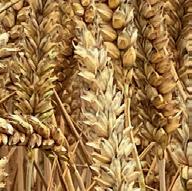




















































combined cereals.
> Due to this high moisture content, all crimped cereals need to be treated with an appropriate inoculant to reduce spoilage and nutrient loss.
3 Combining grain

Letting the crop ripen fully gives you dry grain and straw to feed / sell.
Things to consider:





> The grain value versus the likely value of meat/milk produced from the grain.



> Any cash ow implications.
Wholecrop guide

MAGNIVA PLATINUM WHOLECROP: Rapidly acidi es the forage and stabilises it during feed-out.
MAGNIVA PLATINUM CRIMP: Drives the acidi cation and reduces the yeasts and moulds that cause spoilage at feeding.


Crimp guide


TAKE CONTROL OF QUALITY
you’ve
your
crop growing – now is the perfect time to weigh up your options.
LALLEMAND ANIMAL NUTRITION ■ SPECIFIC FOR YOUR SUCCESS www.lallemandanimalnutrition.com +44 (0) 1684 580022
NDF Starch D Value Starch % D value % NDF % 30 40 50 5 10 15 20 30 25 60 70 Wholecropping Combining CROP MATURITY Crimping
ADVERTORIAL
While we actively focus our efforts on the prevention of mastitis and achieving good udder health, there will always be clinical cases of mastitis which require treatment. How best should we treat these cases and how do we know if the treatment is optimum on your farm, asks vet Dr Jude Roberts, veterinary consultant at Map of Ag.
Mastitis treatment success on your farm
Starting point: Review mastitis treatment protocols and cure rates
NDr Roberts says: “In some cases this is easier said than done. Clinical mastitis data can be taken from on-farm software, from paper records or extracted from a medicine book.
“If you milk record, a good way to make the most of the data is to provide clinical case records to your milk recording organisation.
“These can be combined into one CDL data file for analysis.
“By looking at the cure rates of mastitis on your farm you can understand how the current treatment regime is working. It can also be useful in showing whether udder health can be improved by altering treatment protocols and continuing to monitor the results.”
Maximising chance of successful treatment
NSpeed of detection: Allowing prompt treatment: Studies show that there are poorer outcomes with delayed treatment of first cases. Good mastitis detection allows cases to be treated promptly and efficiently. Review how clinical mastitis is detected and whether all members of staff are trained in early detection of clinical signs.
NFirst case compared with repeat cases: The first case
of mastitis has the highest potential for cure. Ensure cows are treated when they first present with mastitis.
NPrevious history: Cows of a higher parity and particularly those which have a history of previous mastitis are likely to have poorer cure rates. Talk to your vet about how best to treat these animals and the likelihood of treatment success.
Assessing the cure rate on your farm
NWhat proportion of cows are only affected once?
NWhat proportion of cows have no further clinical signs and remain at a low somatic cell count?
NTreatment success is when you have no recurrence of clinical mastitis symptoms
Treatment options
NON-STEROIDAL ANTIINFLAMMATORY DRUGS (NSAIDS)
NSAIDs, such as Metacam ® , have multiple actions on the body:

N Anti-inflammatory
N Anti-pyretic (reduce fever)
N Counter endotoxin-induced cellular damage
N Provide analgesia (pain relief).
Dr Roberts says: “There is a significant amount of evidence
and the next three milk recordings are less than 200,000cells/ml
NFocus on first (initial) cases rather than repeat cases: what is the figure on-farm?
NThere is significant variation between farms, so discuss with your vet where the farm sits among a group of similar farms
to justify the use of NSAIDs in all cases of clinical mastitis – mild, moderate and severe – and this approach is being used on an increasing number of farms.”
The improvements described following the use of a systemic NSAID include better clinical outcomes (recovery), improved bacteriological recovery, lower somatic cell count, improved fertility, reduced size of udder, reduced pain signs, improved physiological parameters
34 JUNE 2023 SPONSORED CONTENT About Boehringer Ingelheim Animal Health UK: Boehringer Ingelheim is the second largest animal health business in the world. We are committed to creating animal wellbeing through our large portfolio of advanced, preventive healthcare products and services. With net sales of €3.9 billion and about 10,000 employees worldwide, we are present in more than 150 markets.
For more information, visit farmersguardian.com/metacam
and whether this figure could likely be improved by altering treatment protocols
NBenchmarking between comparable farms can be useful, but it is even more interesting to benchmark against yourself as you make changes to improve treatment success

(rectal temperature, rumen contractions and respiratory rate) and improved milk appearance 1,2,3
INTRAMAMMARY ANTIBIOTIC THERAPY
N Most cases of clinical mastitis are caused by bacterial infection in the udder, therefore prompt treatment with an appropriate antibiotic is recommended.
There are currently eight
different intramammary antibiotics marketed in GB for lactating cows.
Dr Roberts says: “These vary in terms of dosing interval, treatment duration and milk withdrawal.
“Most importantly, they vary in terms of active ingredient and whether the product provides broad spectrum or narrow spectrum cover against the target bacteria.
“Your vet will be able to
use

advise you which to use and when, based on information such as mastitis infection rate and pattern, bacteriology and through close monitoring of the recurrence and cure rates.
“Where possible, a narrow spectrum treatment should be chosen to ensure antibiotics are used responsibly.”
N Talk to your vet about optimising your mastitis treatment protocols to maximise cure rates for mastitis on-farm.

Top tips
NDetect and treat cases promptly

NUse a NSAID
NFollow the appropriate antibiotic treatment course
NMonitor cure rates on your farm

NReview treatment protocols regularly with your vet
References: 1, McDougall et al (2009) J Dairy Sci 92: 4421–4431; 2, McDougall et al (2016) J Dairy Sci 99(3): 2026–2042; 3, Banting et al (2008). Vet Rec. 163(17):506-9. Metacam® 20 mg/ml solution for injection for cattle, pigs and horses and Metacam® 40 mg/ml solution for injection for cattle and horses contain meloxicam. UK: POM-V. Advice should be sought from the prescriber. Further information available in the SPC or from Boehringer Ingelheim Animal Health UK Ltd., RG12 8YS, UK. Tel: 01344 746 957. Email: vetenquiries@boehringer-ingelheim.com. Metacam® is a registered trademark of Boehringer Ingelheim Vetmedica GmbH, used under licence.
©2023 Boehringer Ingelheim Animal Health UK Ltd. All rights reserved. Date of preparation: March 2023. BOV-0035-2023. Use Medicines Responsibly.


35 JUNE 2023 SPONSORED CONTENT
Dr Jude Roberts (right) says vets will be able to advise you which treatments to
and when.
Farmers and herd managers across the UK know the transition period is crucial to the lifetime production of their herd and are also under real pressure to reduce antibiotic usage while increasing production.
So with this in mind, Will Tulley, head of technical services at Advanced Nutrition, says the real question is ‘why are we still not ge ing transition management right?’

He says: “In recent years, transition management has really focused on high straw diets used to control energy intakes, but this can result in lower protein diets and can be at the expense of early lactation milk production.

“Rather than just looking at how to reduce transition disease, we need to see the dry period as an opportunity to set cows up to optimise their performance in the next lactation. Some of this is around diet formulation, but it needs to be backed up by strict management protocols.
Positive impact
“If we can manage ration preparation and delivery, energy intakes, protein and amino acid levels and control of hypocalcaemia, we can minimise the depressing work of
Getting nutrition right in transition
managing sick cows and we can have a positive impact in long-term health, production and pro tability.”
He adds that studies have shown that for those cows which transition without disease, there is only a 1% chance of culling by 60 days in-milk.
In comparison, those which transition with a fresh cow disease are 5% more likely to be culled by 60 days in-milk.
Mr Tulley says this means that not only are farmers spending
Protein balance
JMr Tulley advises looking at the protein balance around calving.
He says: “During early lactation, a cow requires about 16-18% protein to fulfil her needs as her body recovers from calving and produces her peak milk flow.

more money to treat productions diseases, 6% of the herd are also likely not to have paid for themselves, which in turn has a real impact on herd sustainability.
He adds that good results have been achieved for a number of years with controlled energy diets. He says: “We really focus on consistent dry matter intakes. This way, when we get to post-calving, we can really maximise intakes and therefore energy levels.
“We need to start thinking in
“However, rather than only looking at overall dietary protein supply, we should be looking at supply of available protein to the cow and, ultimately, the supply and balance of amino acids.
“Amino acids are the building blocks for milk and body proteins
terms of se ing the right energy levels at the right time. Continual monitoring at this point is also key, especially around subclinical milk fever prevention.”
Regardless of the nutritional approach taken, Mr Tulley says it is essential to understand and monitor the transition cows’ dry ma er intakes and formulate rations appropriately to achieve the required energy and amino acid supply, without underfeeding or overfeeding.
and so are critical for health and immune function. If we do not get this right, the cow can start to mobilise skeletal muscle, which is associated with an increased risk of mastitis and sole ulcers in early lactation.”
36 JUNE 2023
A focus on nutrition is one part of transition management, with key areas having an impact on performance. Dairy Farmer reports.
Will Tulley
It is important to manage dry matter intakes around calving to minimise the gap in nutrients at this stage.
Nutrient intakes

JMr Tulley says at four to five days in-milk, a cow’s nutrient requirements increase by up to seven times.

He says: “Dry matter intake does not increase quickly enough to provide all these additional nutrients, so cows mobilise body tissue and require increased calcium uptake from the gut and bone stores.
“If feed intake is too low, they start to excessively mobilise fat due to excessive negative nutrient balance.”
He says key at this stage is the management of dry matter intakes to minimise the gap in nutrients around calving.
“The dip is normal, but if we can minimise it, cows will be healthier and get up and eat well. If they eat well, they produce more milk and are in a better metabolic state.”
He says: “Close monitoring of rumen fill immediately before and after calving is an excellent tool to indicate any issues with dry matter intake in this critical period, but remember that physical ration prep-
A North American study looked at the impact of straw chop length at the period around calving. Researchers compared a four-inch chop length with a one-inch length.
With the shorter chop length, the cows sorted less and ate more. Across the entire dry period, the shorter chop length increased intakes and there was less of a drop in dry matter intakes as the cows approached calving.
The shorter chop length also had a positive impact on energy and protein levels and there were less ketones in the blood three weeks after calving.
Adding water to the diet seven to 10 days prior to calving also led to more consistent dry matter intakes, less sorting and a higher rumen pH after calving.
aration plays as large a role in success as the actual formulation of the diet.”

Here are some nutritional areas of focus, that Mr Tulley says can have a positive impact on the transition period.
Calcium mobilisation
JCalcium mobilisation is another area to watch in terms of diets for a transitioning cows, says Mr Tulley.
The cow needs to mobilise calcium at calving for the calving process as well as the production of colostrum and then milk. However, Mr Tulley says milk fever is controllable.
“In terms of key performance indicators, all farms should be aiming for less than 1% clinical milk fevers. Anything above this suggests a more robust control programme is required.
“In the UK, DCAB is quite often used to manage calcium metabolism. However, it can be a complicated system to



implement and monitoring the dietary mineral levels is difficult in a timely manner.
“In the USA there is a shift towards the use of zeolites [minerals which contain mainly aluminium and silicon compounds] as a management tool for transition cows, not just for milk fever, but for all metabolic diseases.”
Studies
Mr Tulley says there are some comparative studies showing the effect of the zeolites compared to DCAB diets and all show better control of blood calcium levels around calving in animals fed the zeolite diets.
37
COW
JUNE 2023 The first dairy compound range with SHEEP BEEF PLANET DAIRY PLANET PLANET Successfully fed on farms since 2019 ZERO soya and palm kernel Contact Massey Harpers Feeds: Holmes Chapel: 01477 536300 Preston: 01772 206200 Holsworthy: 01409 254300 or scan: Fo cu se d on n utriti on Fo cu se d on n utriti on Reduce your carbon footprintwith
DRY
MANAGEMENT
Dairy cows are at their most vulnerable to health issues, including foot problems, at the point of calving, says vet Jon Reader of Synergy Farm Health. erefore, it is essential that producers maintain a high standard of management and foot care throughout the dry period.
Mr Reader points out that claw horn lesions are one of the most common causes of lameness.

He says: “As calving approaches, the cow will experience hormonal changes that help to ease the passage of the calf during birth. ese changes result in a slackening of all the ligaments in the body, including those which hold the pedal bone in position. is can lead to instability and possible rotation of the pedal bone within the foot.
“In turn, this instability and pedal bone rotation can have a ‘pinching’ e ect on the corium, which is similar to the quick of the human nail and contains the nutrients and blood vessels required to produce new hoof growth. is sequence of events is how problems with claw horn lesions can start.
It is of critical importance to pay close attention to cow foot care in the dry period in order to set the animals up for a successful lactation. Wendy Short reports.
Caring for feet in the dry period
“Producers can do li le to prevent the slackening of the ligaments, but it will help if cow comfort is maximised before and a er calving, and if standing times are reduced where possible.”
Another risk factor for claw horn lesions is when cows undergo weight uctuations in the dry period and around calving time.
“Metabolic changes may lead to changes in the composition and structure of the fat pad which cushions the underside of the foot.
“ is feature is sometimes described as a shock absorber, but in fact its purpose is to dissipate pressure away from the pedal bone.
“A reduction in fat pad function
can also contribute to the development of sole ulcers. at is why body condition scoring and matching the diet to the cow’s requirements are just as crucial in the dry period as they are while the cow is milking.”
Footbathing
Infectious diseases are another widespread cause of cow lameness, and regular footbathing is a key preventative measure that should be included in all dry cow management routines, he adds.
“Most farms have an excellent system for footbathing the milking cows, but there is not always a similar set up for the dry cows, especially where they are

managed or housed away from the main milking herd.
“I would advise footbathing dry cows on a weekly basis, where practical. Formalin is an e ective and relatively low-cost option and it can be included at a solution of 5% for regular footbathing, but the product must always be used in line with health and safety recommendations.”
e traditional advice has been to set aside two periods each year for foot trimming, but Mr Reader advises caution with this approach.
He says: “It is be er to view the routine as a foot inspection, rather than a foot trimming session, and drying o is a good time to
38 DRY COW MANAGEMENT JUNE 2023
Vet Jon Reader advises footbathing dry cows on a weekly basis.
DRY COW MANAGEMENT

perform a check. It is perfectly acceptable to pick up a foot and take no action; in fact over-trimming will often cause more harm than under-trimming. It is no longer appropriate to aim to trim the hoof until it looks clean and white.”
Repeated studies have found that one case of claw horn lameness will predispose the animal to become lame again in the future. Meanwhile, further work showed that administering an anti-inflammatory injection to heifers at calving will reduce the risk of lameness over the whole of the forthcoming lactation.
“This applied to heifers in particular. In the study, the treatment was given whether or not the heifer was showing signs of lameness,” Mr Reader says.
“Other research has found that foot trimming heifers before they calve down for the first time had little effect on their future foot health under UK conditions. It appeared that the general good
management of these heifers was likely to be the more critical element to minimise lameness risk in later lactations.”
Mobility scoring
Mobility scoring can help producers to detect dry cow lameness at an early stage, but Mr Reader says this group is often omitted when routine scoring is undertaken.
“Mobility scoring will pick up a problem which may necessitate
immediate action; it might highlight a hoof block that requires replacement, for example.
“Treatments must be meticulously recorded and any follow-up intervention delivered on time. I recommend following the AHDB’s Healthy Feet Programme, which uses the EDPET [Early Detection and Prompt Effective Treatment] system as a guideline.”
The regular monitoring of foot
health and swift response to any problems which arise are an essential component of maximising dairy farm performance, he stresses.
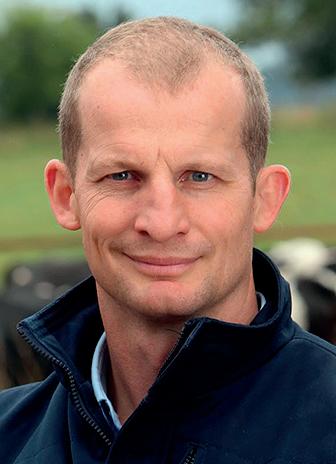
Mr Reader says: “It is understandable that milking cows are the main focus of day-to-day management. Nevertheless, the dry cows must receive a similar level of attention if they are to fulfil their potential post-calving.
“I would also suggest that at least one team member should be trained to be competent in delivering cow lameness first aid. LANTRA-accredited courses are becoming available and it is advisable that anyone who is regularly involved in cow foot health on farm should have attended one of these training sessions.
“Adopting a high standard of dry cow foot care is only one part of a holistic programme of dairy cow management that takes into account all aspects of their health and welfare.”
Dry cows must receive a similar level of attention if they are to fulfil their potential postcalving
JON READER
With calf scour still having an impact on calf health, it is key that a multifactorial approach to control is taken. Dairy Farmer looks at how vaccination of the pregnant cow can form part of this strategy.
Vaccination against scours
Vaccination against bovine respiratory disease (BRD) has long led the race in terms of disease prevention in dairy calves, but vaccination against infectious scours is fast catching up, with the number of cows vaccinated across the UK dairy sector increasing year on year.
Kate Ingram, technical adviser at Virbac, says this is unsurprising as neonatal calf scour remains very common in the UK.
She says: “Studies show that diarrhoea a ects about 50% of dairy calves and gastrointestinal infections were the most commonly diagnosed cause of mortality in calves under one month old submi ed for post-mortem.”
She adds that focus by the industry on improving all aspects of calf health and reducing the use of antibiotics, alongside the increased awareness of the impact of calf scours, has led farms to seek control strategies, and key among them is vaccination.

She says: “Calf scour is a multifactorial disease and its control requires a multifactorial approach. Ultimately, in order to prevent
disease, not just scour, our aim is to maximise a calf’s immunity while simultaneously minimising the disease challenge it faces.”
And she says vaccination has the bene t of positively impacting on both a calf’s immunity by ensuring high levels of the antibodies speci c to the disease it faces and reducing the disease challenge it faces by reducing the shedding of pathogens by a ected animals into the environment.
Benefit
Vaccination bene ts both the individual calf and its herd mates. Unlike BRD vaccines, where it is the animal at risk which receives the vaccine, with scour vaccination the vaccine is given to the pregnant cow or heifer to then protect her calf.
Ms Ingram says: “When a cow or heifer is vaccinated in the last trimester of pregnancy [dosing protocol is vaccine-dependent so ensure manufacturer guidelines are followed], she produces high levels of antibodies or immunoglobulins [IgG] to the pathogens contained within the vaccine. ese are then passed into her colostrum.”
e graph (below le ) compares
antibody levels to the key pathogens rotavirus, coronavirus and E.coli F5 in cows vaccinated with a calf scour vaccine versus unvaccinated cows, while graph two shows the impact on those same cows’ colostrum.
Ms Ingram says: “IgG levels were signi cantly higher in the vaccinated cows’ serum and colostrum than in the serum and colos-

trum of the unvaccinated cows.”
She adds that studies have shown feeding colostrum from vaccinated cows and heifers to calves is an effective way to help control calf scour – reducing the severity and duration of diarrhoea and, importantly for the wider group, reducing the amount and duration of pathogen shedding by infected calves.
40 DRY COW MANAGEMENT JUNE 2023
SOURCE : Virbac SOURCE : Virbac IgG concentration in cow serum after vaccination IgG concentration in colostrum Unvaccinated control Unvaccinated control Bovigen Scour Bovigen Scour E.coli F5 (K99) E.coli F5 (K99) Coronavirus Coronavirus Rotavirus Rotavirus 100 80 60 40 20 0 100 80 60 40 20 0 Mean level of antibodies expressed in % of light inhibition Mean level of antibodies expressed in % of light inhibition
Vaccination is a key tool in our armoury in the fight against scour, says Kate Ingram.
Take the next step with Mastitis Vaccination


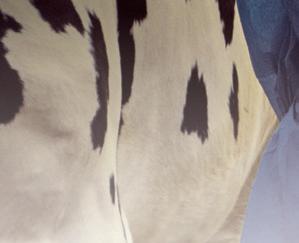







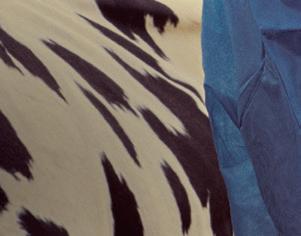





Ask your vet about your mastitis prevention plan



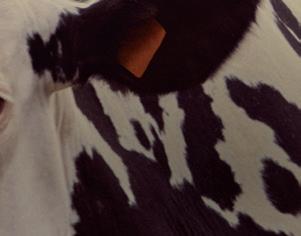


28,2% E. coli

11% Staph. aureus





11% Non-aureus Staph

Andrew Biggs BVSc, FRCVS and Vale Veterinary Laboratory Data Primary pathogen identified in all high SCC and clinical mastitis milk samples from 2019-2021. STARTVAC® Inactivated vaccine, Bovine mastitis, in injectable emulsion. COMPOSITION PER DOSE (2 ML): Inactivated Escherichia coli (J5) 50 RED60*; Inactivated Staphylococcus aureus (CP8) SP 140strain expressing SAAC** 50 RED80***. Adjuvant. * RED60: Rabbit effective dose in 60% of the animals (serology). **SAAC: Slime Associated Antigenic Complex. ***RED80: Rabbit effective dose in 80% of the animals (serology). INDICATIONS: Cows and Heifers: To prevent Mastitis. For herd immunisation of healthy cows and heifers, in dairy cattle herds with recurring mastitis problems, to reduce the incidence of sub-clinical mastitis and the incidence and the severity of the clinical signs of clinical mastitis caused by Staphylococcus aureus, coliforms and coagulasenegative staphylococci.The full immunisation scheme induces immunity from aproximately day 13 after the first injection until approximately day 78 after the third injection (equivalent to 130 days postparturition). Further information available from the SPC or on www.hipra.com. For more information about side-effects, precautions, warnings and contraindications please refer to the SPC, the packaging or product leaflet. LEGAL CATEGORY: POM-V- Veterinary medicinal product under veterinary prescription.
MARKETING AUTHORISATION HOLDER: Laboratorios Hipra, S.A. la Selva, 135, 17170-AMER (Girona) SPAIN. MARKETING AUTHORISATION NUMBERS: UK(GB): Vm17533/5010, UK(NI): EU/2/08/092/003-6. Use Medicines Responsibly.
UBAC®, emulsion for injection for cattle. COMPOSITION PER DOSE: Lipoteichoic acid (LTA) from Biofilm Adhesion Component (BAC) of Streptococcus uberis, strain 5616 ≥ 1 RPU. Montanide ISA 907.1 mg. Monophosphoryl Lipid A (MPLA). INDICATIONS: For active immunisation of healthy cows and heifers to reduce the incidence of clinical intramammary infections caused by Streptococcus uberis, to reduce the somatic cell count in Streptococcus uberis positive quarter milk samples and to reduce milk production losses caused by Streptococcus uberis intramammary infections. Further information available from the SPC or on www.hipra.com. For more information about side-effects, precautions, warnings and contra-indications please refer to the SPC, the packaging or product leaflet. LEGAL CATEGORY: POMV- Veterinary medicinal product under veterinary prescription. MARKETING AUTHORISATION HOLDER: LABORATORIOS HIPRA S.A Avda. la Selva 135. 17170 Amer (Girona) Spain. MARKETING AUTHORISATION NUMBERS: UK(GB): Vm17533/5011, UK(NI): EU/2/18/227/001-004. Use Medicines Responsibly.
These products are not licensed for concurrent use. A decision to use either of these vaccines before or after any other veterinary medicinal product therefore needs to be made on a case-by-case basis.
41 JUNE 2023 HIPRA UK and IRELAND Foxhall Business Centre, Foxhall Lodge, Foxhall Road, Nottingham, NG7 6LH. United Kingdom Tel.: (+44) 0115 845 6486 · ukandireland@hipra.com · www.hipra.com
35,9% S. uberis 4,4% Strep. dysgalactiae 2,5% Bacillus 2,7% Coryne. bovis 0,9% Klebsiella spp 3,6% Others
A focus on the latest in feeding and milking parlour innovation and also an insight into what is going on within the industry’s state-of-the-art research and development facilities.

The South West Dairy Development Centre (SWDDC), near Shepton Mallet, Somerset, is home to a 180-cow herd and also some of the most up-to-date, cu ing edge dairy farm technology, some of which is in early stages of development and some which is already on the market.
All this technology is being put through its paces at the facility, which acts as a vital test bed for the UK dairy industry.
e SWDDC is part of Agri-EPI, the centre for agricultural engineering precision innovation, and is one of three speci c dairy research facilities, the other two being the Midlands Dairy Research Centre, located at Harper Adams University, and the Calf Research and Innovation Facility, based on Scotland’s Rural College-owned Crichton Royal Farm, Dumfries.
Duncan Forbes, Agri-EPI Centre dairy project specialist, says: “We are not promoting this facility as some sort of
While the South West Dairy Development Centre is run as a commercial dairy farm, what is unusual about this facility is that it offers an innovative environment for the research and development of a whole host of technologies which have the potential to revolutionise dairy farming. Katie Jones reports.
Vital test bed for cutting edge tech
blueprint of the ‘perfect dairy’, but we have built something which provides a resource for research and development in a close-to-market environment.
“We are able to push the boundaries and have a go and test things which might not otherwise see the light of day.”
Unique
However, Mr Forbes also says the south-west facility is unique in that Agri-EPI has collaborated on it with the Christensen family of Steanbow Farms,
who own and look a er the day-to-day running of the all-year-round calving herd.
Agri-EPI also has a network of commercial farms throughout the UK, which provides a platform to host research projects and evaluate developing technology in a commercial farm environment and help close the gap between research and the farmer.
e facility at SWDDC, which was opened in 2018, was built with animal health and welfare rmly in mind, says Mr Forbes.
He says: “ is is state-of-theart housing, using automation and robots to look a er cow health and welfare, which we are now looking to combine with precision grazing.”
e main building itself was designed and manufactured by Dutch company ID Agro and was the rst of its kind in the UK.
It measures 100 metres long by 28m wide and the translucent fabric roof comprises three layers: a black outer layer; a carbon bre mesh middle layer; and an inner white layer. e

42 JUNE 2023 DAIRY TECHNOLOGY
The cubicle housing was designed to transmit even levels of light across the entire building.

DAIRY TECHNOLOGY
white layer is designed to transmit even levels of light across the entire building.

e lightweight roof, which weighs about 3.5 tonnes, meant smaller steel uprights were needed compared to a conventional concrete bre roof.
is, says Mr Forbes, had a positive e ect on the environmental impact of construction, but has also meant cow environment is improved, as there are fewer obstructions within the shed itself.
e open sides of the building are ed with Galebreaker curtains, which raise and lower automatically according to weather conditions, with inside temperature, as well as windspeed, wind direction and rainfall all monitored via sensors.
Mr Forbes says: “We can change the parameters for when we open and close the curtains, but crucially this type of building has no open ridge in the roof.
“Instead, we rely on cross-ventilation to regulate the temperature in the shed.”

e facility has high levels of automation and Mr Forbes says this has not been done with the idea that all labour will be replaced in the future.
He says: “ ere is a shi in where we are going in terms of labour availability, and generally herds are ge ing larger.
“One of the biggest costs is labour, so we need to optimise how we use that labour, and anything that will enhance
the skills of our labour force will help with this.”
In particular, Mr Forbes says being able to automate the milk harvesting process frees up skilled stock keepers to be able to spend more time with the animals themselves rather than just standing in a parlour pu ing units on.
Cows in the facility are milked via three Lely robotic milkers, with cows averaging 3.2 milkings a day.
Feeding is also automated, with a GEA Mullerup mounted
on rails positioned high in the building.
is means the cows receive feed li le and o en, which Mr Forbes says leads to high dry ma er intakes and very li le waste in the feed troughs, which are also coated with resin to provide a clean, smooth feeding surface.
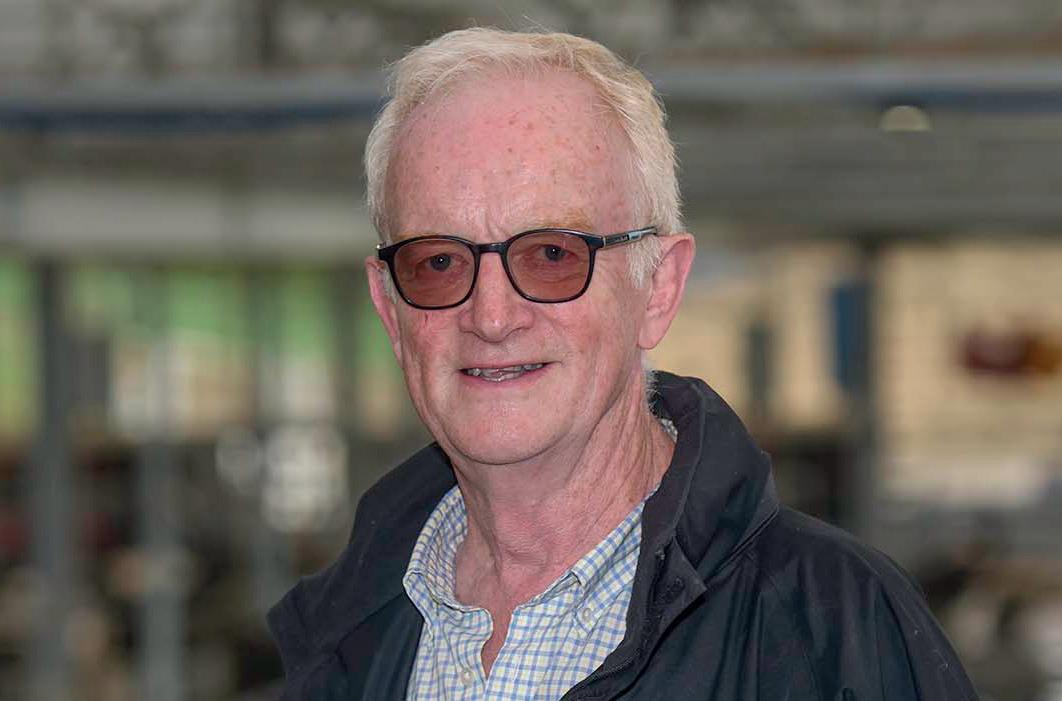
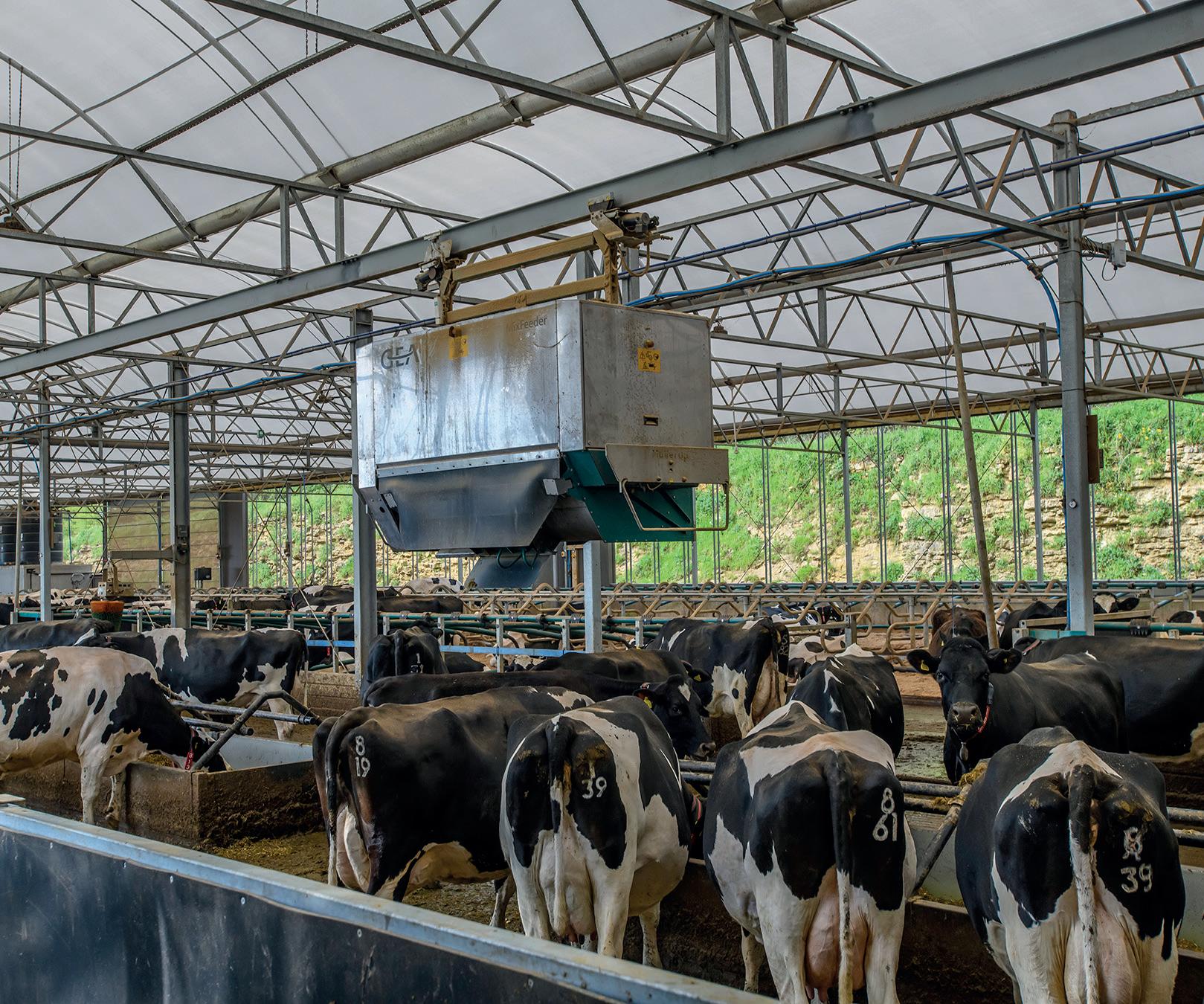
Upgrades
Following a relaunch of the facility in April, infrastructure and technology have been upgraded to allow cows improved access to grass, with the aim being to use technology to deliver precision grazing. is will be facilitated through a Grazeway gate and will also crucially rely on monitoring of grass growth.
Mr Forbes says: “This comes back to the mantra of ‘if you don’t measure it, you can’t manage it’, so at the very least for precision grazing to be effective, we need to be plate metering covers. However, this is a time-consuming
task, so we are looking at how this can be automated and will be trialling technologies which involve the use of drone and satellite technology to measure grass covers.”
With milk sold to Barber’s, it is necessary for the herd to graze for part of the year, but Mr Forbes says this is not the only reason for investigating the viability of precision grazing.
He says: “Economics are also involved in this decision and grazing is the cheapest way to produce milk. However, it is only cheap if that grazing is well-managed.”
As well as being a demonstration facility for technologies already available to the industry, the SWDDC also provides companies which might not have had any relationship with the agricultural market, with a route to market, and will also assist with bid writing for companies wanting to access funding opportunities.
Continues over the page...
44
JUNE 2023
Duncan Forbes
The automatic feeding system delivers feed multiple times a day.



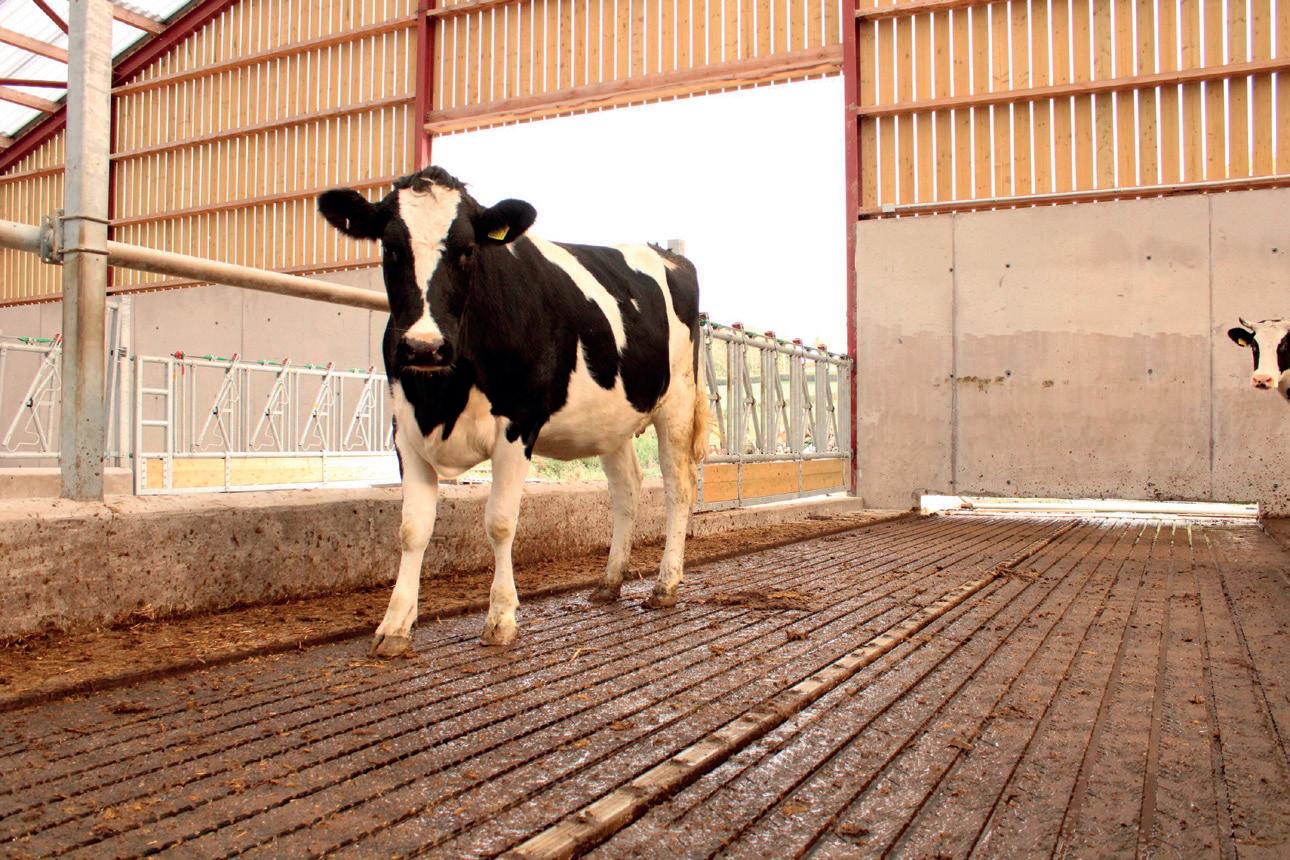




45 JUNE 2023 Call: 028 6774 8377 (NI) +44 28 6774 8377 (ROI) www.teemoreengineering.com • Fixed and mobile handling systems • Manual and automatic crush • Weigh kits & EID compatible products • Calving Gates • Positive pressure tube ventilation • Head Scoops
FARMING EQUIPMENT AND TECHNOLOGY FUND
DAIRY TECHNOLOGY
Hoofcount
JWith funding of £250,000, Hoofcount is running a project at SWDDC which aims to develop a system using computer vision and machine learning to visualise daily changes to foot health and, in turn, make early detection of any potential issues, including digital dermatitis.
Mirico Orion CH4
JThe Mirico Orion CH4 system, located in the grazing paddocks, is monitoring methane emissions.


This is essentially a research tool to help inform the centre on how its farming
Early detection will enable farmers to make earlier treatment.
Researchers
The project will also involve researchers at the Centre for Machine Vision at the University of the West of England, Bristol, and Bristol Robotics Laboratory.
Levno for Milk
activities influence methane emissions.
The Mirico will contribute to building a databank of information which will enhance the research capabilities and value of the farm.
JLevno is a milk monitoring system designed in New Zealand to provide producers with complete visibility of the milk in their tank. The system, which has been installed on top of the farm’s bulk tank, monitors milk temperature, volume of milk in the tank at any time and agitation. It can help aid farm
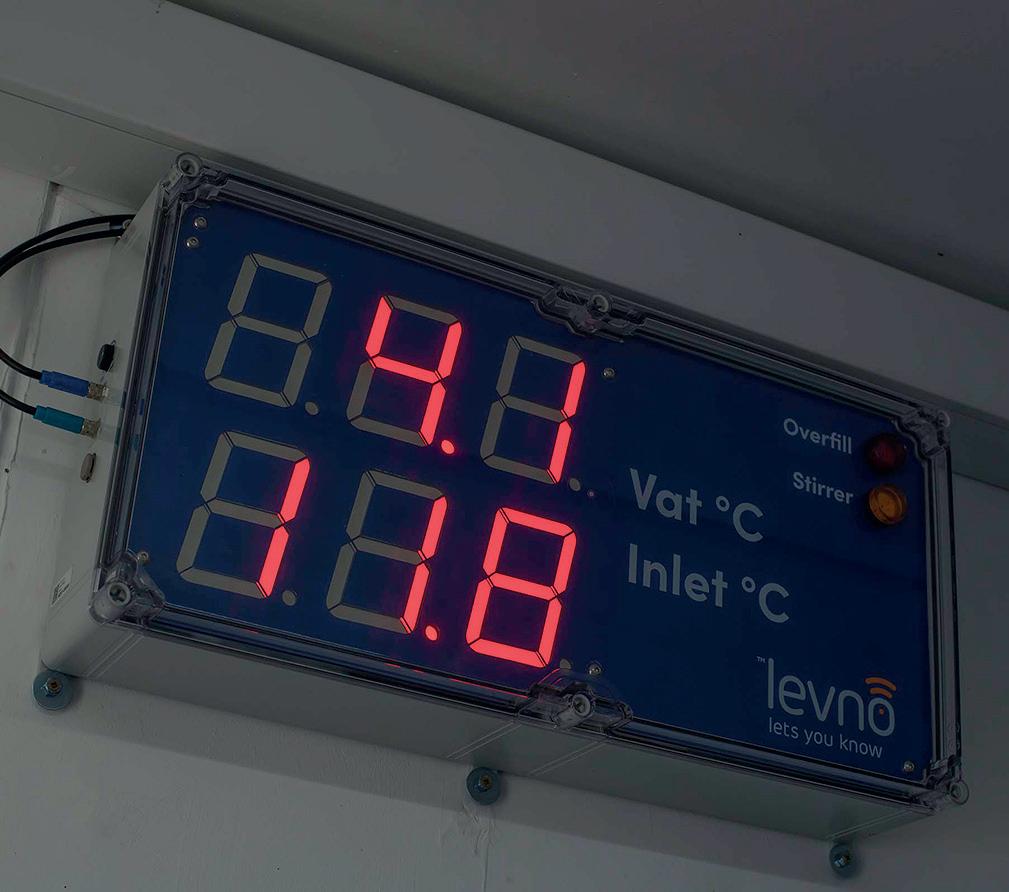
smaXtec
JsmaXtec rumen boluses have been introduced to each of the commercial herd’s 180 cows to monitor changes in behaviour, including rumination rate, body temperature, water intake, activity and information on fertility. In turn, they provide early detection of health issues, heat, birth and drinking activity and water intake.
The boluses are enhancing the skill of the team managing
Soil sensors
JMeasuring soil moisture and temperature at six different depths, Agri-EPI’s data team aims to integrate the data from these sensors with other sensor data to provide an accurate model and forecast of grass growth for each field on the farm.
Mr Forbes says: “Data integration is a growing challenge for all developers to
tackle. Farmers needs to be free to choose the sensor technology they want which is right for their system but does not want to have to open multiple programs to see the results and then do the integration in their heads.
“The future for precision farming is one where multiple sensor systems talk to each other to provide the optimal decisionmaking support for the operator.”
management decisions and diagnose any issues with refrigeration or plant. It also provides accurate records of milk temperature to meet with processor requirements, insights on wash behaviour and temperature, and alerts to power outages.
The relevant reports and data are supplied via an app, text or email.
the animals. For example, 10-15 hours pre-calving, the system flags that a cow is close to calving, at which point staff can take the animal and introduce her to the specialist calving pen.
The boluses are also proving to be useful for heat detection and health monitoring, in terms of activity, body temperature and water intake, to enable early intervention.
46
JUNE 2023
Here we look at some of the technologies being developed and demonstrated at the SWDDC.
Second cut presents different conditions to first cut, as the grass is more fibrous and lignified and days are longer, meaning grass will dry more quickly.
Peter Smith of Volac suggests farmers need to bear this in mind when deciding on wilt times: “Second cut grass is inherently drier, so a 24-hour wilt is often excessive. Unless the weather is wet it may be possible to pick up grass on the same day.

“If using a contractor, they will be able to provide feedback on their experience of optimum wilting times this season.
“If filling on top of first cut, always place a layer of fresh grass before travelling on the silage, as otherwise carbon dioxide will be displaced from the silage already in the clamp and oxygen will move in.

“Clamps should be filled in layers no deeper than 150mm and each layer rolled before adding another.
“Once the last layer has been rolled, it is important to place the sheet on as


Fine-tuning conditions ahead of silage-making
soon as possible and fully seal the clamp to prevent any oxygen entering.”
Check
Krone’s Eleazar McKeever urges farmers to take time to check mowers, tedders and rakes are correctly adjusted to conditions on the day.
He says: “It is vital to select the right speed on the mower conditioner. For heavy crops, the higher speed of 900rpm is appropriate, whereas for lighter crops, the grass will need less conditioning.
“There are seven settings for the


Spring or autumn reseed?
SPRING ADVANTAGES
XWider window of good conditions for establishment
XNo heading in first season
XBetter opportunity to out-compete weeds
AUTUMN ADVANTAGES
XMinimal impact on yield loss
XSeedbed has time to settle over the winter
XGives the option of growing an

Sponsored by


intervening cover or catch crop to help control pests and diseases
SPRING DISADVANTAGES
XLoss of peak grass growth
XShorter window for soil to settle before carrying stock
AUTUMN DISADVANTAGES
XWeed competition can be significant with late reseeds
XNarrower window of suitable establishment conditions
distance between the baffle plate and top of the mower. For drier crops, choose a higher setting to maintain a greater distance for less conditioning and, for wetter crops, a lower setting will result in more bruising of the grass, leading to a quicker wilt.
“Avoid closing it up too much as this can lead to excessive power consumption and increased fuel usage.
“Setting the correct top link length to set the pitch of the blades will determine the length of stubble left in the ground.
“If mowing when the ground is soft, leaving a longer stubble length is desirable to prevent contamination.”
Mr McKeever says tines on the tedder should be set with around 20mm tine tip to stubble to avoid them scraping the ground.
He says: “The pitch of each tine on Krone machines can be adjusted individually by altering the angle of the wheel between 13-degrees and 19degrees. For wet, heavy crops or when making hay, a low setting will spread the grass out as far as possible; for lighter crops or for repeat tedding of a hay crop, a higher setting is recommended.
“The pto speed for a tedder should be no faster than 450rpm and ideally between 350 and 400rpm with the higher revs reserved for heavier crops.”
Options
If first cut yields are disappointing or quality is below expectations, this often indicates weed grasses are out-competing sown species and a reseed might be the best option, John Spence of Limagrain UK says.

“After the 2022 drought followed by a late spring, many farmers need more grass this season. Ploughing a field up now will mean taking a hit to production when grass growth is at its peak.
“A preferred option could be to boost production from existing swards by over-sowing with more productive, fast-growing ryegrasses and introducing clover species. Alternatively, some farmers may wish to hold off reseeding until autumn, or sow a break crop, such as stubble turnips or kale, to provide an autumn winter forage before reseeding with grass.”
47 SPONSORED CONTENT JUNE 2023
out more about Campaign for Better Silage at farmersguardian.com/ bettersilage, or scan the QR code
Find
Taking account of field conditions ahead of silage-making is vital in order to maximise quality.
Poor cluster presentation and excessive liner slippage had been ongoing issues on the 40:40 rapid exit parlour used to milk 800 cows three times a day at Simon Bugler’s Pilsdon Dairy Farm, Dorset.
A er seeing the impact Lactalign cluster support devices had on milkings within rotary parlours, the devices were installed at Mr Bugler’s parlour in late October 2022.
James Hudson, managing director of J.F. Hudson, developed the product along with Philip Metcalfe of Metcalfe Farms, where the devices were rst trialled on a rotary parlour.

Mr Hudson says that as part of this installation at Pilsdon Dairy Farm, an independent study was carried out by the Dairy Group’s milking technology national specialist, Ian Ohnstad.
Mr Hudson says: “Ian carried out a pre-installation visit and two post-installation visits in March and April of this year to assess the di erence Lactalign made over a period of six months.
“ e assessment shows that it has brought a 57.4% reduction in liner slippage, a 56% reduction in the number
After being successfully used on rotary parlours, Lactalign cluster support devices have now been trialed on a rapid exit parlour where an independent study has been carried out. Katie Jones looks at the results.
Rapid exit parlour and cluster support device
of kick-o s and a 42% reduction in rea achments.
Milking comfort
“While visual observations did not detect a measurable di erence in cow behaviour, the study states that the reduction in both kick-o s and rea achments would strongly
indicate there is an improvement in milking comfort.”
e impact the use of the device may have on mastitis will require a longer period of evaluation, but Mr Bugler says the improved positioning of the cluster will lead to an improvement in teat end condition, which will have a further
Importance of cluster positioning
JOn cluster positioning, Mr Ohnstad explains the importance of getting it right. He says: “I want cows to be milked quickly and evenly and I do not want liner slippage.”
He says there is widespread consensus that even milking can
Lactalign
JLactalign is a retrofit cluster support, which has been designed and engineered to support the weight of a milking cluster evenly under the cow, providing equal weight and vacuum across all four quarters of the cow’s udder.
Manufactured from durable high-density polyurethane hygienic plastic, it can be installed in most milking parlours, including rotary, herringbone and rapid exit parlours.
only be achieved when a milking cluster is presented squarely under the cow with equal weight distribution on all quarters. However, this can be difficult to achieve, says Mr Ohnstad, and it can be particularly problematic
positive impact on mastitis incidence.
He says: “All the sta are using the supports, which is good. ey realise the value and I am not having to remind anyone to use them. e reduction in liner slip was immediately obvious within the rst milking.”
Mr Ohnstad says the reduc-

where cows are presented at 90-degrees to the kerb, as is the case in rapid exit parlours.
He says in many parlours there can often be issues with incorrect lengths and routing of the long milk and pulse tubes, which can end up twisted.
It works by supporting the weight of each cluster’s pipes, which in turn supports the weight of the cluster, preventing the weight of the pipes unbalancing the cluster.
An individual Lactalign cluster support is secured to the parlour below each cluster’s pipes. Once the cluster has been fitted to the cow’s udder, the Lactalign support is swung into place by the milker, providing three positions to support the cluster’s pipes.
The milker selects which position to mount the pipes, depending on the height of the cluster. The ACR cord should then be located below the pipes (or the same notch if positioning the pipes in the bottom notch).
Once milking is complete, the ACR engages, releasing the cluster. The retracting ACR cord and the weight distribution of the Lactalign cluster support combine, ensuring the Lactalign automatically swings back out of the way.
48 DAIRY TECHNOLOGY JUNE 2023
Ian Ohnstad
tion in liner slippage, kick-o s and manual rea achments was ‘measurable’.












He says: “All these factors will lead to smoother, more






e cient milking. e robustness and simplicity of the device is a ractive, with no reported breakages or failures during the evaluation. Ongoing



maintenance and service costs appear to be minimal.

“ e farm owner and milking sta all commented how much milking has improved



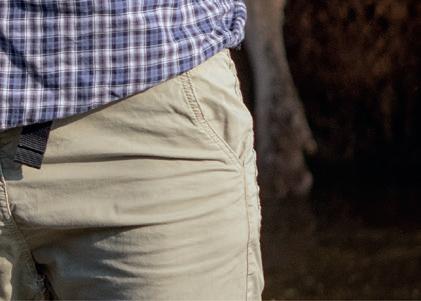



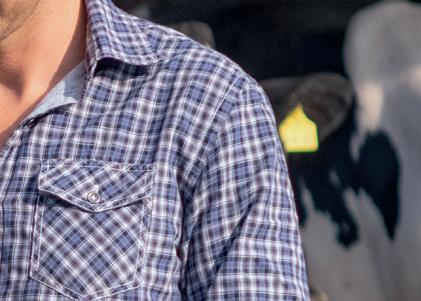

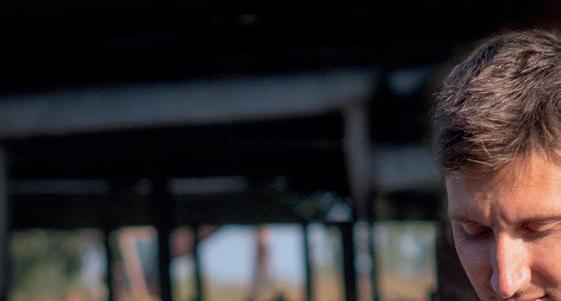
with less slippage and unit kick-o s. Initial concern at how easily the devices would be adopted by milking sta has proven un-founded.”








49 JUNE 2023
Lactalign can be installed in most milking parlours, including rotary, herringbone and rapid exit parlours.
Adjusting robot access times for cows across the herd has helped to drive milk yields, particularly from early lactation cows, for Lancashire producers Steven and Tracey Holden.
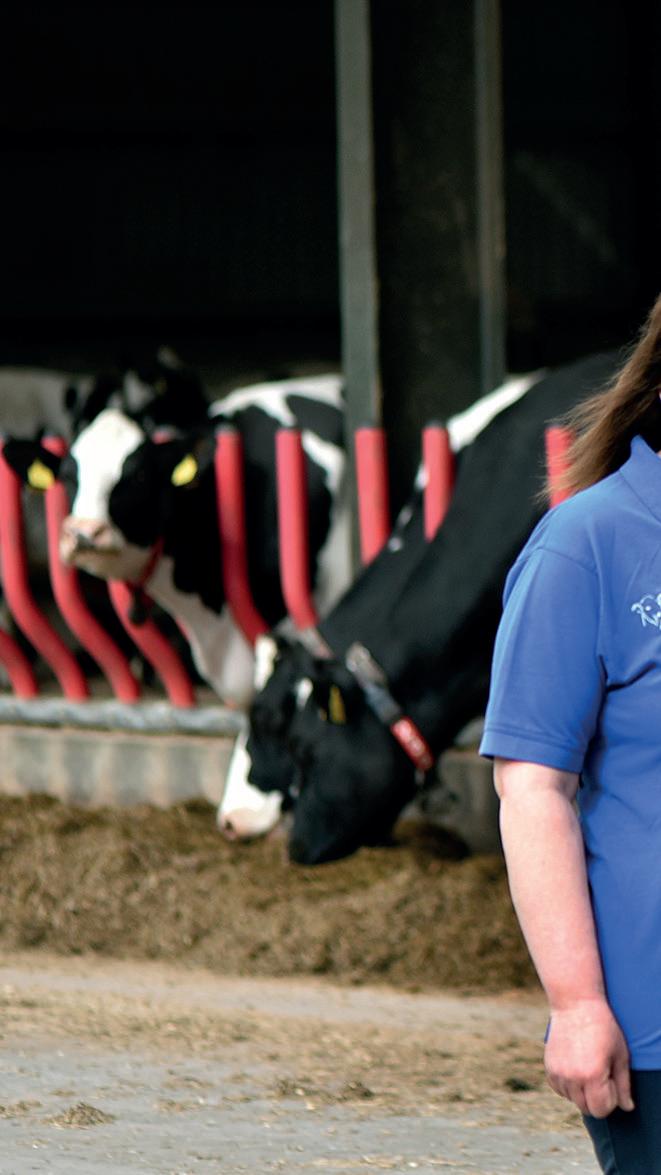
Optimised robot settings driving milk yields

After converting to robotic milking in 2019, Steven and Tracey Holden now milk 110 Holstein Friesians, with an average yield of 10,800 litres per cow per year at 4.3% butterfat and 3.24% protein, on two Lely Astronauts.
Their purpose-built, light airy shed was designed to enable cows to reach their potential. With feed barriers along both sides and generous access to clean drinking troughs, cows never have far to walk for their
next mouthful and there is enough feed barrier space for the whole herd to eat at the same time.
Getting the balance between out-of-robot and in-robot feeding, which can be a significant challenge on any automated milking unit, was an early priority, says Steven.

He says: “We were struggling to consistently hit 28-30 litres/cow/day and do so economically. I felt that we could get more out of the cows without becoming over-reliant on concentrates.
“We produce plenty of good quality grass silage on our 56 hectares and I
was keen to utilise this as much as possible, along with other forage sources.”
Steven got in contact with ForFarmers specialists, who visited the farm and worked with him to come up with a revised approach to feeding and have supported the herd ever since.
He says: “We have simplified our in-robot feeding, cut back the amount of blend we feed and its protein content. And just over a year ago we started adding maize silage into the cows’ diet to increase the energy.
“We had been feeding different types of nut via the robots, to separate
Steven and Tracey Holden milk 110 Holstein Friesians, with an average yield of 10,800 litres per cow per year at 4.3% butterfat and 3.24% protein.
sections of the herd, so one of the first things we did was switch to feeding the whole herd with just one type of Optima, high-performance nut.
“To increase the overall energy provision in the diet, we also introduced maize silage into the ration fed down the barrier and rebalanced the protein levels in the blend.
“This is fed at a rate of 3.5kg/cow/ day compared to the 5.5kg/cow/day fed previously.”
The herd is now fed 25kg of grass silage at the barrier, along with 15kg of maize silage, 3.5kg of Intamix meal, 4.5kg of a moist blend and minerals.
Steven says: “We have used a moist blend for a long time and this, coupled with the maize silage, increases the ration’s palatability and fuels higher intakes.

“I think we were feeding too much protein before. Now we are feeding lower rates of blend things seem to be about right and overall the diet is nicely balanced. The results speak for themselves.
“Milk yields used to be about 28-30 litres/cow/day, but now they are hitting
50 SPONSORED CONTENT JUNE 2023
Getting the balance between out-of-robot and in-robot feeding was an early priority.
35-36 litres. And all while decreasing concentrate use and increasing milk yields from forage – we consistently achieve a rolling average of more than 35% total yield from forage.”
The Holdens use ForFarmers’ Robotic Analysis Programme, which provides insights into how the herd is performing at group and individual level.

ForFarmers account manager Emma Moore recently used the data to identify an issue which was holding back yields in some of the herd.
She says: “We found that milk access settings on the robots were working against the early lactation animals and particularly the heifers, restricting their access to the robots.

“We also found that mid and late lactation animals were taking up too much time in the robot and their milking efficiency could be improved.
“By adjusting the settings to allow
greater access to cows and heifers at 0-100 days in-milk and slightly reducing access to mid and late lactation animals by encouraging them to give more milk per visit, we were able to drive yields in early lactation while maintaining yields and improving milking efficiency in later lactation.
Targets
“Cows in the first 100 days of lactation should be giving 50% of that total lactation’s yield. Cows in the 100-200 days in-milk group should be giving 30% of their yield and the 300 days-plus cows should be giving 20% of the total yield.
“We did not always see this with the Holdens’ herd and through the Robotic Analysis Programme we could see that access settings were working against those early lactation animals.”
Increasing access to the robots for cows in the 0-100 days in-milk group saw an average milk yield


increase of 3.5kg/cow/day and 0.3 milkings, taking the group average to 3.8 milkings in 24 hours.
For the heifers in that group, there was an increase of 3.4kg milk yield per day and an increase of 0.3 milkings, to an average of 3.6 milkings in 24 hours.
For the 100-200 days in-milk group which had their access to the robot reduced slightly, results showed an increase of 2kg of milk per visit leading to a decrease of 0.2 milkings/cow per 24 hours, with average yields maintained.
It was a similar story for the 200-plus
days in-milk group, which reduced their average milkings per 24 hours by 0.3, but still maintained their average yields.
Emma says: “The Holdens are a great example of how data can work to drive performance.
“The cows have the right diet, a great environment in which to perform well and the data allows us to identify groups and individual outliers in the system and adjust the settings so they can all reach their full potential.”
51 SPONSORED CONTENT JUNE 2023
For more information, visit forfarmers.co.uk
ForFarmers’ Robotic Analysis Programme is used to analyse robot data.
On a farm built around simplicity, a new feeding and monitoring system has helped to achieve impressive yields from forage, while improving margins over purchased feed. Dairy Farmer reports.

Feed system helps manage raw materials and intakes

Rob Chilman and his wife Debbie have built their success at Old House Farm, near Tibberton, Worcestershire, around a simple management system focused on not over-complicating feeding, but providing high-quality forage, which keeps cows happy and comfortable.
Running a herd of 230 pedigree Holstein cows under the Alcath pre x, averaging more than 11,500 litres on a Muller Tesco contract, Mr Chilman’s management system is based on maximising margin per cow, driven by increasing milk from forage.
Most of that forage, on average 60% maize and 40% grass, comes from the 80 hectares (200 acres) Mr Chilman farms each year, made up of just over 28ha (70 acres) of owned land and the remainder is rented.
He also buys-in about 40ha
(100 acres) of grass silage per year from a farm about four miles away.
His philosophy of keeping things simple, while always having a focus on margins over purchased feed, meant Mr Chilman was more than open to the opportunity through AB Agri to trial a new feed management
system and keep an even closer check over feed use and e ciencies.
He says: “We were initially offered the opportunity to trial the new technology and, as we knew it could be linked up to our herd management system, we thought we would give it a try.”
e cloud-based system is designed to provide accurate data on consumption of feedstocks and the components of the ration, while o ering the ability to monitor feed costs.

He says: “Our backbone is ge ing good-quality forage. We aim to keep our rations simple and consistent, so the opportunity to accurately measure ingredient inclusion and monitor e ciency was an easy decision.”
From the initial free trial some three years ago, Mr Chilman has now fully integrated the Feedlync digital system by CowConnect into his yearround housed operation and, combined with other improve-
ments and advances in feeding, is certainly reaping the bene ts from the milking herd.
With a margin over purchased feed per cow of £3,873, Mr Chilman’s cows are achieving milk yields of 11,734kg, with concentrate use at just 0.23kg/litre.
Milk from forage stands at 4,225kg, with 4.03% bu erfat and 3.31% protein. e low concentrate feed rate is more akin to a low-input herd.
Ration
All the milking cows get the same total mixed ration (TMR), with no concentrates in the parlour. Based on rstcut grass and maize silage, the milking ration includes 7kg of a bespoke 27% protein blend and 9kg of Tra ord syrup.
Mr Chilman has also, in part, adopted a compact feeding system, involving adding water to help prevent sorting, a er learning about the system following a visit to Denmark through the
52 DAIRY TECHNOLOGY JUNE 2023
Rob Chilman has integrated the Feedlync system into his operation.
Rob Chilman runs a herd of 230 pedigree Holstein cows under the Alcath prefix.
Are you looking to improve milk quality?
“LactiBute Prime can increase butterfats in cows at grass, helping to maintain milk quality even when heat stress and dietary pressures force fats down.”

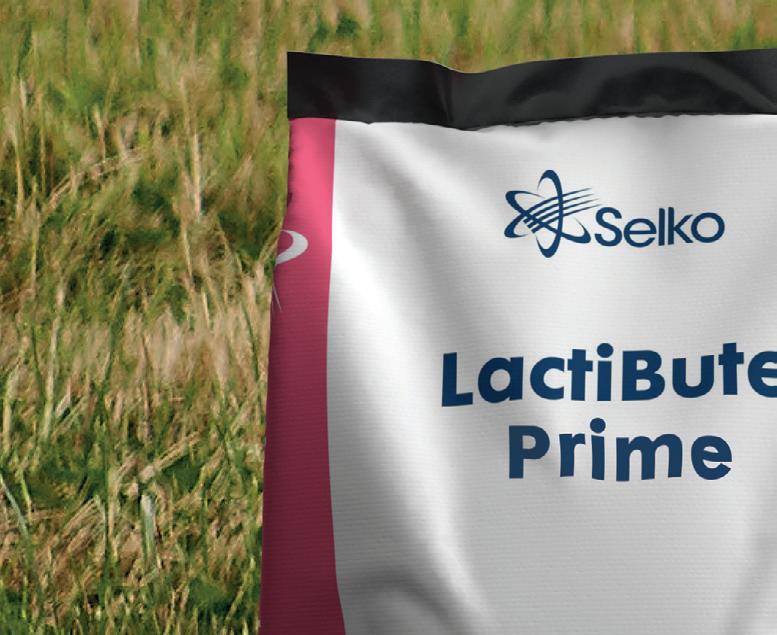


 Mark Hall
Mark Hall
Ruminant
Trouw Nutrition GB


Selko LactiBute Prime has the ability to:

• Improve fats even during heat stress
• Increase incorporation of dietary fat
• Improve efficiency of energy utilisation


For more details about LactiBute Prime visit trouwnutrition.co.uk/lactibute



Technical Manager
Midland Holstein Club. He now adds water to the TMR to get the ration to 41% dry ma er (DM).
e Feedlync system helps maintain this consistency, allowing for instant adjustment of feed composition and cow numbers, even making DM corrections to ensure weather does not impact milk pro ts.
He says: “ e weather adjustment tool is really useful, meaning I can make accurate adjustments to keep the DM percentage consistent, if we have a sudden heavy downpour or face a period of sustained heat.
“We can keep a check on what the cows are doing and if they have not cleaned up I might drop the DM ratio down by a few percent.
“It is only the forage which will knock things out of sync, as the concentrates will stay the same, so making adjustments here has a positive impact.”
Mr Chilman says the impressive performance gures are also aided by his investment in
a second-hand mixer with a horizontal augur system, replacing his previous paddle mixer, around the same time the feed system was installed.
He says: “We saw instant results with both the mixer and the feeding system, with yields going up. I believe this was because the feed was mixed more thoroughly, leading to less sorting.
Value
“ is combination certainly helped see a steady increase in production and is adding value to the operation.”

Mr Chilman operates most of the feed system features from his phone, upgrading to the latest version a li le over 12 months ago. Operating via an app (iOS and Android) and an online portal, the system is live all the time and can be accessed via multiple mobile device logins.
He says the hardware consists of an external weigh system and gateway unit that xes on to the mixer wagon, while
the cloud-based, digital feed management so ware system is quick and easy to operate.
He says: “ e hardware was easily installed on the mixer and, a er a few tutorials to get to grips with using the system, I was up and running.
“It makes it so much easier to maintain the consistency.”
Working with the weigh system, Feedlync ensures the feed is mixed precisely so Mr Chilman’s cows get the correct ration every time, not only saving on feed costs and wastage, but also supporting the health of the animals.

He says: “If you keep things simple, there are fewer things to go wrong. We can keep the basic ration we use all year round really consistent with the feed management system. e cows want the same and this consistency is good for them.”
While the key to Mr Chilman’s impressive performance gures is undoubtedly down to his commitment to a happy and healthy herd, the feed management system is certainly paying for itself in helping to improve e ciencies.
On average, the system increases feed accuracy by 4%, helping producers use less feed to produce a litre of milk and o ering a return on investment within 94 days on average.
Capabilities
Mr Chilman says: “I am probably only scratching the surface of the system’s capabilities, but it is certainly adding value. ere is always room for improvement and we will continue to monitor the herd and the feeding e ciency closely to get these improvements.”
54 DAIRY TECHNOLOGY JUNE 2023
It is only the forage which will knock things out of sync, as the concentrates will stay the same
ROB CHILMAN
Rob Chilman’s cows are achieving milk yields of 11,734 litres, with concentrate use at just 0.23kg/litre.

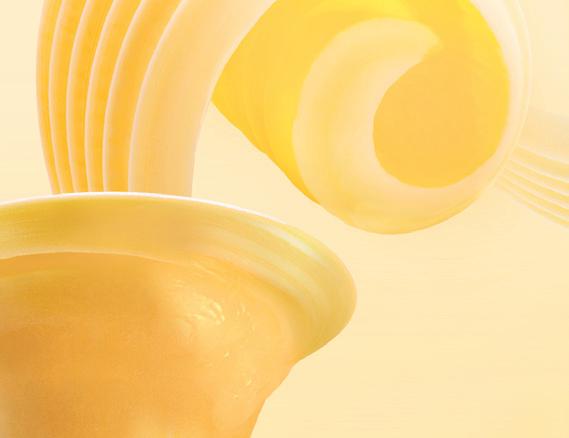









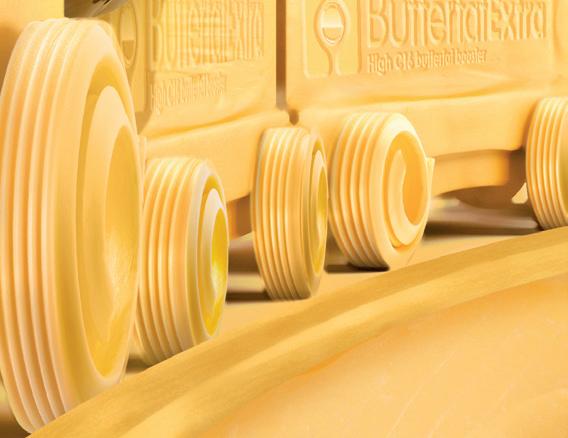


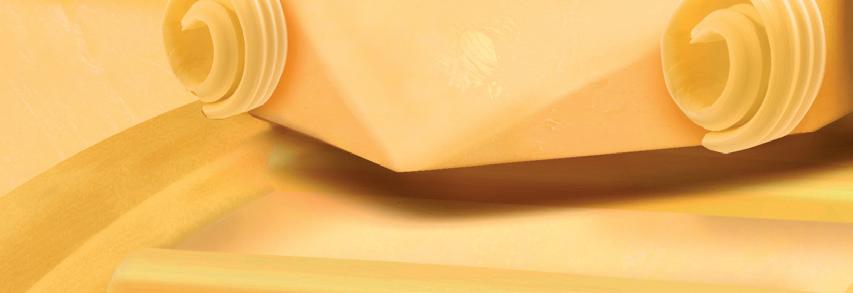



















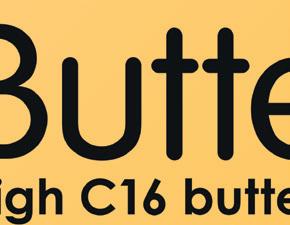



TRIED &TESTED BY UK FARMERS Keep your butterfat levels on track this Spring Boost your herd’s milk yield and milk fat content by adding Butterfat Extra to their regular feed throughout the Spring. Butterfat Extra is: ■ Highly digestible with rumen-protected fat ■ Easy to store and ready to feed Butterfat Extra can help you achieve: A typical rise in butterfat of 0.3% Increased milk yield by up to +1 litre per cow/day Contact your local merchant or call Trident on 07540 819080 tridentfeeds.co.uk
Scraping cubicle housing can be one of the most time-consuming parts of the day on some dairy farms. James Huyton visits a dairy which is saving time and labour with a robotic system.


Lancashire dairy farm adopts robots
Andrew Metcalf farms 120 hectares (297 acres) at Hare Apple Tree Farm, Quernmore, Lancaster. e farm’s herd of 120 Holstein Friesian ca le averages 8,500 litres of milk destined for an Arla care contract. Mr Metcalf aims for a bu erfat content of 4-5% and a protein content of 3.4-5%. He views this system as a

sustainable approach to milk production, with most of the feed ration formed around home-grown grass silage without any soya used in the total mixed ration.
Mr Metcalf says: “I like to keep the farm rations as simple as possible, with our dry cow mix consisting of grass silage and straw and the lactating ration a blend of Tra ord gold, grass silage and straw.”
When considering the robotic

scraper option, Mr Metcalf says: “We were looking at ways to improve time e ciency on-farm. I love the dairy business, but sometimes the thought of scraping out on a Sunday could be time be er spent with my young family.”
Options
Looking at the options for the business, Mr Metcalf liked the idea of the Lely Discovery 120 Collector.
Unlike some robotic scrapers, this system vacuums and collects the slurry from the housing oor, while applying a jet of clean water in its tracks.

Once full and the cycle completed, the Lely Discovery
returns to its storage bay to empty, recharge and reload with clean water. e ability
56 MACHINERY JUNE 2023 INNOVATION EFFICIENCY RELIABILITY EXPERTS IN SLURRY HANDLING & BIOGAS SOLUTIONS FOR ALL YOUR FARMING NEEDS Separators & Green Bedding Screw Conveyors & Long Shaft Pumps Submersible Pumps & Agitators ABOUT US SEPCOM® and CHIOR® offer advanced solutions through a comprehensive range of machines and accessories for livestock manure treatment and for effluents in biogas production Livestock manure treatment Digestate agitating & pumping Biomass conveying & feeding WHY CHOOSE US ? Innovative products suitable for heavy duty operation, offered at a fair price 0 1 6 8 4 2 9 9 1 0 4 0 7 8 5 1 2 5 2 6 2 7 Owen Bond@Saveco-Water co uk www saveco-water co uk
I like to keep the farm rations as simple as possible, with our dry cow mix consisting of grass silage and straw
ANDREW METCALF
Andrew Metcalf
Parameters
J

introduced cut
gates within his cubical house to allow the robot to work freely without restriction. When installed, the team from Lely UK mapped the cubical housing and provided the Discovery set parameters to work within.


57 JUNE 2023
The farm now runs two Lely Discovery machines.
Mr Metcalf has
down
MACHINERY
to retro- t the system within existing housing also appealed to Mr Metcalf.
He says: “Alterations had to be made to some of our housing to accommodate the system, as we operated both cubical housing and a straw-based system.”
Mr Metcalf says the changes were necessary and not too di cult to introduce.
e Lely Discovery docking station required the removal of a cubicle bed for installation and an access point cut into the slurry chamber to unload collected material. Water and electric feeds were also installed at this point.
e Lely system utilises an automated docking system to connect to the charging point and water supply for reloading.
Each docking bay is also complete with its own mobile
phone-based control system to set run time parameters or take manual control of the machine.
Mr Metcalf says: “Traditionally, we would scrape out our cubical housing once a day, taking about two hours, but with the introduction of the Lely machine we have doubled our cubical space.
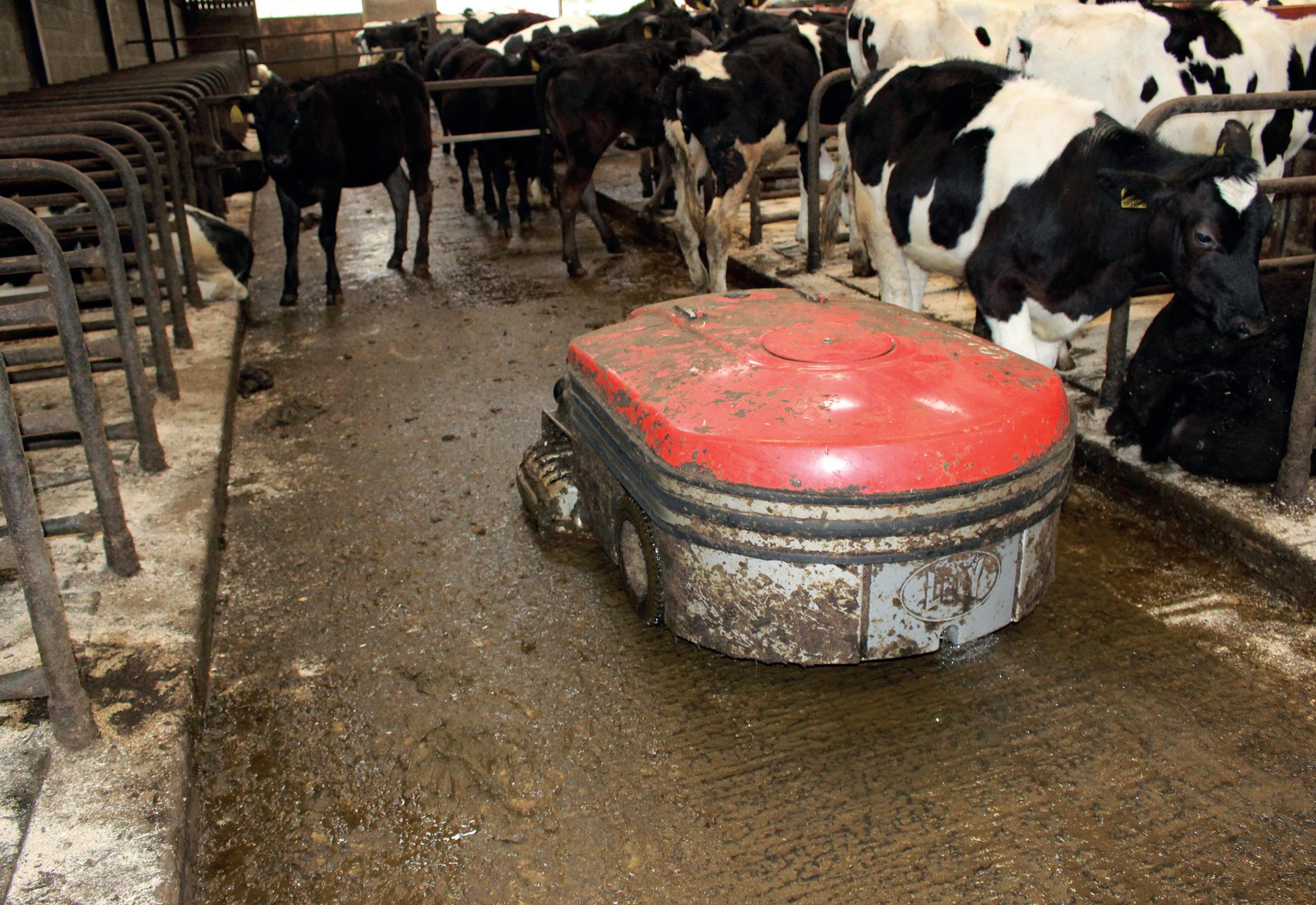
“We have saved a potential four hours a day cleaning out once every 24 hours.”
Passes
Mr Metcalf says the Lely machine achieves nine passes within a 24-hour period down each cubical passage.
He says: “Sheds are a lot cleaner, cows are happier and I have more time to manage the business and spend time with my family.”
Mr Metcalf highlighted
one of the key bene ts of the system constantly collecting the slurry. Reduced ammonia losses gained from the short period of time the slurry spends on the housing oor.
He says this improves air quality and ensures a higher proportion of available nitrogen reaching the lagoon and later with application to the elds.
Mr Metcalf says: “I was fortunate enough to receive Farming Equipment and Technology Funding to pay for a proportion of the machine’s outlay.”
Asked if he would go back to his old system, Mr Metcalf says: “I now run two Lely Discovery machines. I appreciate they were a costly outlay, but they have transformed my working day.
“My grandad bought our old scraper tractor in 1963 and

I hope to get it refurbished as it is currently gathering dust.”
So pleased with the system, Mr Metcalf now invites other local farmers to see the robots working and highlights the bene ts to his business.
58
JUNE 2023
Sheds are a lot cleaner, cows are happier and I have more time to manage the business and spend time with my family ANDREW METCALF
The Discovery vacuums the building floor before washing with clean water. The unit automatically returns to its dock to refill and recharge.
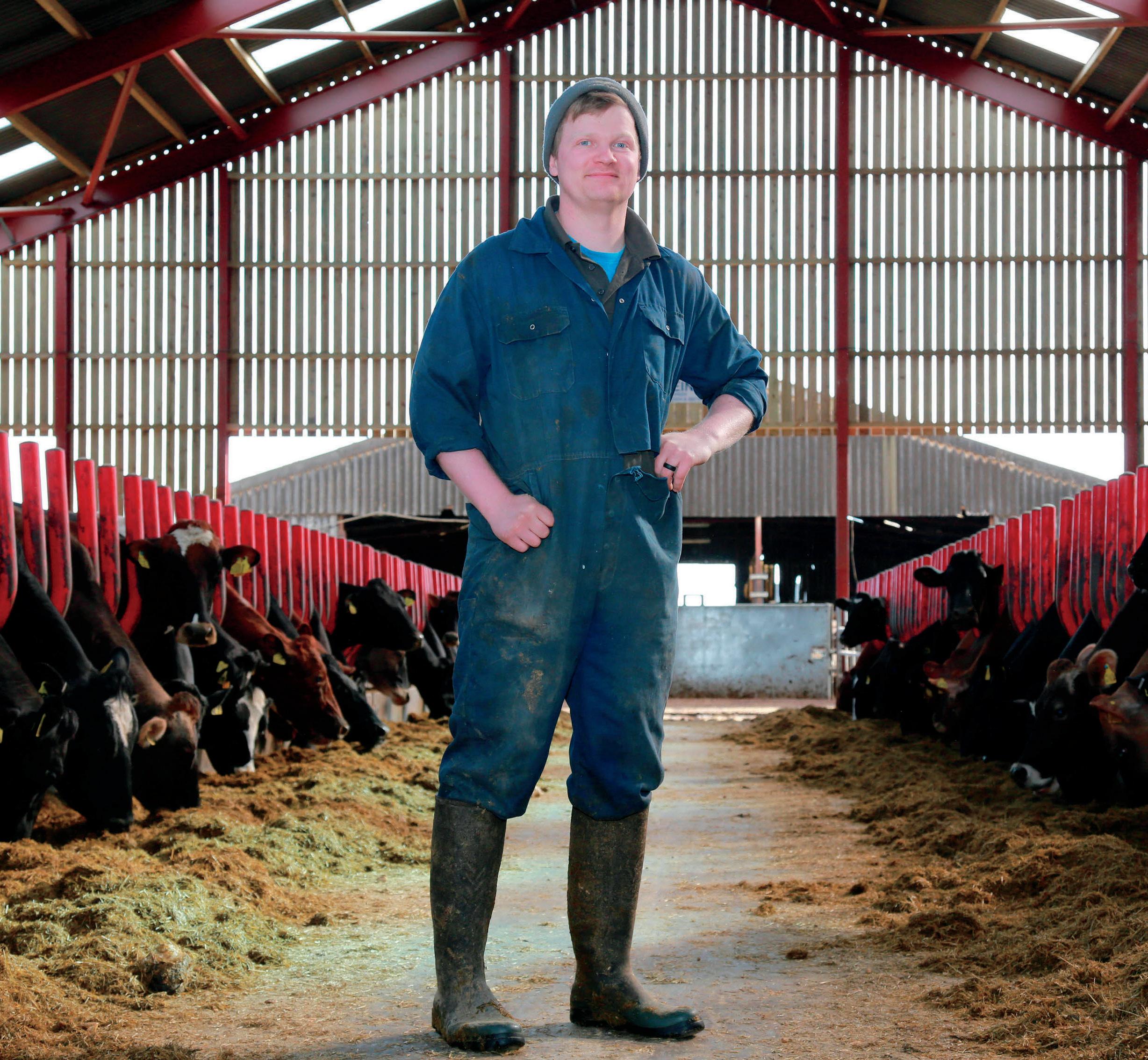





59 JUNE 2023 I would not look back after making the switch to EASYFIX, just seeing how comfortable and content the cows are, a picture paints a thousand words www.easyfix.com Providing Farmers With Peace of Mind 07985 602767 - Tom Pemberton, Dairy Farmer Our Dairy Housing Solutions Are Grant Approved! Call For A Free Quotation Flexible Cow Cubicles Cow Mattresses Feed Rail
MILKprices
Muller makes a stand on milk price






J Over the years we have become familiar with Arla Foods being the flag bearer for UK milk prices, either leading the charge upwards or being able to maintain a sizeable premium over most other milk buyers.


So it feels almost surreal when another milk buyer should decide to step into the breach and especially at a time when the Arla milk price is really being put through the mangle with a further three euro cents (2.65ppl) cut for May.
The last time something similar happened was back in October 2021, when Freshways increased its milk price by 1.5ppl when milk prices looked to be going into hibernation for winter and Arla Foods had cut its price by 0.9ppl the month before.
This time step forward Muller, which, in the face of virtually every non-retailer ex-farm milk price expecting to take another step down for June, decided to hold both its conventional and organic milk price for its Direct (non-retailer) suppliers.

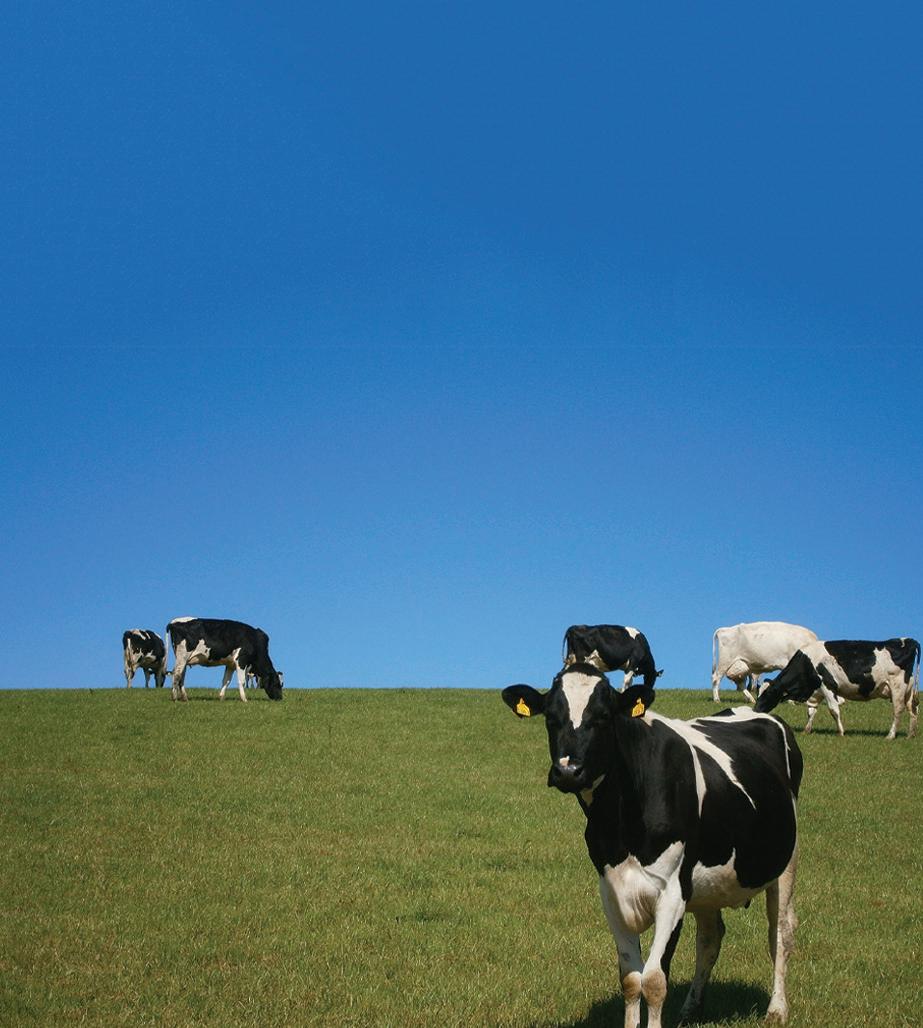
There can be no doubt the company’s new balancing


scheme, which commenced this April, has had a part to play in helping with the stabilisation of its main headline milk price of 40ppl for our liquid standard* and 49ppl for organic.
But the decision to hold is certainly a bold one that time-wise could well play out near the bottom of markets. Of course time will tell.
Cherry-picking

In the meantime, the company has been successful in cherry-picking a few new producers in selected parts of the country, especially down in the South West.

The decision to hold for June follows the 2.5ppl decrease for May, maintaining the company’s total reduction of 8ppl for the year to date, as well as keeping the price just 1.55ppl below that paid for June last year.
Unfortunately, most other milk buyers for liquid have not been able to make such a stand, with most middle ground liquid processors cutting between 1ppl and 3ppl for June as they juggle their own price levels with timelines.
BUYING LIVESTOCK? SPREAD COSTS & PAY MONTHLY 01827 300 333 www.financeforfarms.co.uk Finance for business use customers only; subject to application, credit, terms and conditions. Finance for Farms is a trading name of Shire Leasing PLC who is authorised and regulated by the Financial Conduct Authority for certain types of consumer credit lending and credit related activities that are regulated under the Consumer Credit Act 1974 and by the Financial Services and Markets Act 2000. auctionfinder.co.uk Your one stop shop for all agricultural sales Search by sale type, mart, auctioneer or region DEEP GROOVES FOR SOLID FLOORS SLAT GROOVES DIAMOND CUT 60 JUNE 2023
Milk price analyst Stephen Bradley on the latest milk industry developments.

A little positivity returning
JOn the manufacturing side, it is Barber’s Cheesemakers and Parkham Farms which have put markers down to say ‘enough’ by holding their June milk prices unchanged from May.
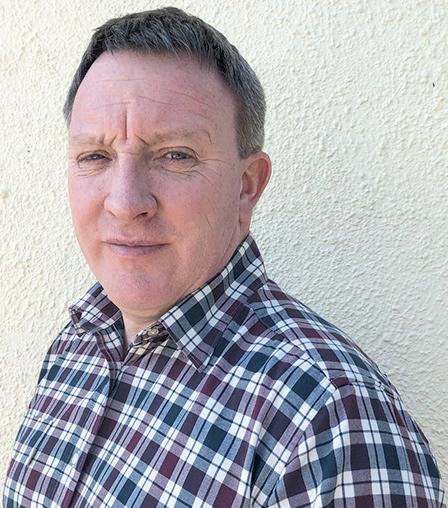
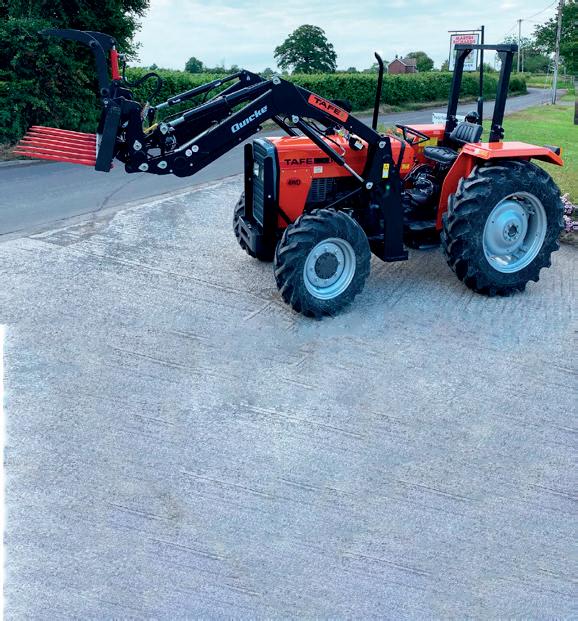
Both companies report that they are starting to see a little positivity returning to the cheese market, with an uptick in fresh demand.
At the same time, there is little doubt now the inclement weather this

year has played a pivotal role in keeping a lid on milk supplies this spring flush, as milk balancers were starting to report pulling gaps in their processing capacity in early May. This is starting to add fear that milk might possibly go tighter than expected in the back end.



The price hold by both cheesemakers maintains our manufacturing standard litre* on 39.1ppl and 39ppl respectively.
Tesco to hold until August
JAdding to the mood of price stability, Tesco has confirmed it is to hold its Tesco Sustainable Dairy Group milk price of 43.51ppl (Muller) and 43.26ppl (Arla Foods) for our liquid standard* until the end of July.
The hold follows the 1.01ppl increase from May, maintaining the retailer’s overall price reduction for the year to date at 4.49ppl.

However, suppliers to Sainsbury’s have seen a further reduction of 0.77ppl for June, taking prices down to 42.14ppl and 42.02ppl for Muller and Arla suppliers, respectively,


making an overall reduction for the year to date of 5.36pl.

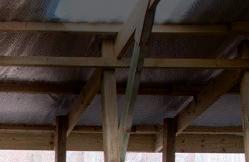

Co-operative Completing our retailer round-up, the Co-operative reduced its June price by 0.26ppl to 41.88ppl for our Muller supplier making for a half year to date reduction of 5.95ppl, while our Muller Marks & Spencer price reduces to 50.67ppl after cuts of 0.23ppl for April and 1.77ppl for May.

After its increase of 1.28ppl for January, the overall reduction for the year to date is currently just 0.71ppl.
*Our liquid standard litre is 4% butterfat and 3.3% protein, for our manufacturing 4.2% butterfat and 3.4% protein and, in both cases, Bactoscans of 30,000/ml and SCCs of 200,000/ml, with Thermodurics of 500/ml, 1m litres/year on EODC (max vehicle accessibility) based on level supply and therefore before seasonality (but includes the winter premiums paid in Northern Ireland), as well as monthly profile adjustments, balancing charges, capital deductions or annual/part annual growth incentive schemes or supplements not directly linked to dairy market price movement.

Call Andy Berry about “Crypt-Occur” 07969 164 066 www.berrysagriculture.co.uk Maintaining Calf Health Call us on 01258 817372 email: info@tractorsuk.co.uk TRACTORS UK SOLE UK IMPORTER OF TAFE TRACTORS FROM THE BEST PEDIGREE BASIC, SIMPLE & RELIABLE TRIED & TESTED FOR GENERATIONS 08R04B � Drum or oil immersed brakes � Roll bar or cab � 2wd or 4wd � 2 Years’ warranty � Comprehensive parts backup www.tractorsuk.co.uk ✆ 01258 817372 ✉ info@tractorsuk.co.uk BASIC, SIMPLE & RELIABLE www.tractorsuk.co.uk • • 2 Years’ warranty Comprehensive parts backup • Oil immersed brakes 2WD or 4WD • Cow kennels • Perfect Shelter • Designed for Animal Health • Excellent Ventilation • Shelter from Wind & Rain • Shade from the Sun • Plenty of Fresh Air • Ample Space • Minimum Draught • Many options available Telephone: 01772 785252 www.farmplus.co.uk RECRUITING REPS See website for details 61 JUNE 2023
MILK PRICES
Notes to table
Prices for both Liquid & Manufacturing tables paid for a producer sending 1mltrs/yr on EODC (max vehicle size accessibility) with Bactoscans of 30,000/ml and SCC’s of 200,000/ml with Thermodurics of 500/ml. Excludes capital retentions or AHDB levies, profile adjustments from level supply, seasonality, balancing and A&B price schemes (includes the winter premiums paid in NI). Excludes annual / part annual growth incentive schemes or supplements not directly linked to dairy market price movement. Liquid price for milk contains 4% b/f and 3.3% protein. Manufacturing price for milk containing 4.2%/b/f and 3.4% prot. All prices for non-aligned prices are before monthly retail supplements. (i) Jan’23 prices before seasonality or B pricing (ii) Feb’23 prices before seasonality or B pricing (iii) Table ranked on simple rolling 12mth average of monthly prices Mar’22 to Feb’23). (i) v (ii) The difference Feb’23 compared with Jan’23. UK Arla Farmers 1.13ppl decrease from Jan’23 includes forecast 13th payment reducing from +1.24ppkg (+1.278ppl) to 1.23ppkg (1.267ppl) based on our liquid std litre. UK Arla Farmers 1.12ppl decrease for Jan’23 includes forecast 13th payment reducing from +1.29ppkg (+1.329ppl) to 1.28ppkg (1.318ppl) based on our manufacturing std litre. UK Arla Farmers 2.54ppl decrease from Feb’23 includes forecast 13th payment holding on 1.23ppkg (1.267ppl) based on our liquid std litre. UK Arla Farmers 2.65ppl decrease for Feb’23 includes forecast 13th payment holding on 1.28ppkg (1.318ppl) based on our manufacturing std litre. First Milk price includes 0.5ppl Member Premium accrued as a 13th payment paid Apr’23. First Milk Haverfordwest Tesco Cheese Group includes 2ppl retailer premium averaged as 1.5ppl based on seasonal profile. Fresh Milk Company price before Morrisons monthly cheese supplement (last payment made in Dec’22 of 0.072ppl for Jul’22 to Dec’22 period). MMG Direct price includes 1ppl Premium paid annually in arrears to Direct/Organic farms meeting specific Müller Direct criteria (Quarterly payments from Apr’22).Crediton Dairy price includes FarmMetrics Scheme Bonus of 0.5ppl paid monthly. South Caernarfon price includes flat 0.7ppl annual member bonus. ‡ Price includes 12mth average rolling profile fixed at 0.57ppl. * UK Milk Futures Equivalent (UKMFE) net to producer includes 5% processor margin and allowing 2.55ppl ex-farm haulage + milk testing for Feb’23. ** Ave delivered spot milk net to producer allows 3ppl covering haulage + milk testing and margin. (iv) Latest confirmed milk price at the time of going to press. UK Arla Farmers 3.39ppl decrease from Mar’23 includes forecast 13th payment holding on 1.23ppkg (1.267ppl) based on our liquid std litre. UK Arla Farmers 3.52ppl decrease for Mar’23 includes forecast 13th payment holding on 1.28ppkg (1.318ppl) based on our manufacturing std litre. UK Arla Farmers 5.10ppl decrease from Apr’23 includes forecast 13th payment holding on min 1.23ppkg (1.267ppl) based on our liquid std litre. UK Arla Farmers 5.31ppl decrease for Apr’23 includes forecast 13th payment increasing from 1.28ppkg (1.318ppl) to 1.29ppkg (1.329ppl) based on our manufacturing std litre. UK Arla Farmers 2.54ppl decrease from May’23 includes forecast 13th payment of 1.24ppkg (1.277ppl) based on our liquid std litre. UK Arla Farmers 2.65ppl decrease for May’23 includes forecast 13th
62 JUNE 2023
payment of 1.29ppkg (1.329ppl) based on our manufacturing std litre. MMG Direct Premium for Direct/Organic farms meeting specific Müller Direct criteria confirmed as 1ppl for 2022 and paid quarterly, Apr’22, Jul’22, Oct’22 & Jan’23. All prices are before any additional monthly retail supplements. Milkprices.com cannot take any responsibility for losses arising. Copyright: Milkprices.com Jan’23 Feb’23 12mth Diff Latest 4.0/3.3 4.0/3.3 Ave Feb’23 Confirmed Before Before Mar’22 v Milk Seas’lty Seas’lty Feb’23 Jan’23 Price LIQUID PRICES (4% b/f & 3.3% prot) (i) (ii) (iii) (i) v (ii) (iv) UK Arla Farmers – Morrisons (Grazing) 50.73 48.19 47.62 -2.54 37.16 UK Arla Farmers – Tesco 50.53 47.99 47.52 -2.54 36.96 UK Arla Farmers – Morrisons 50.50 47.96 47.39 -2.54 36.93 Müller Milk Group – M&S 52.66 52.66 47.34 N/C 50.67 Müller Milk Group – Waitrose 50.00 50.00 46.24 N/C 46.70 Dale Farm NI 44.52 40.02 46.15 -4.50 37.52 UK Arla Farmers 49.11 46.57 46.10 -2.54 35.54 Crediton Dairy 48.50 48.50 44.79 N/C 39.00 Dale Farm GB (Kendal) 48.70 47.72 44.67 -0.98 41.21 Freshways 47.00 47.00 44.67 N/C 38.00 Paynes Farms Dairies 48.00 47.00 44.50 -1.00 39.00 Yew Tree Dairy 48.00 47.00 44.46 -1.00 38.00 Müller Milk Group – Tesco 48.00 47.00 44.45 -1.00 43.51 Müller Milk Group – Müller Direct 48.00 47.00 44.25 -1.00 40.00 Arla Foods – Tesco 47.75 46.75 44.20 -1.00 43.26 Meadow Foods Lakes 47.00 45.50 44.19 -1.50 35.50 Meadow Foods 47.00 45.50 44.19 -1.50 35.50 Müller Milk Group – The Co-op Dairy Group 47.83 46.83 44.19 -1.00 41.88 Blackmore Vale Dairy 48.00 48.00 44.06 N/C 40.00 Müller Milk Group – Müller Direct (Scotland) 47.79 46.79 44.04 -1.00 39.79 Müller Milk Group – Sainsbury’s 47.50 46.50 44.00 -1.00 42.14 Arla Foods – Sainsbury’s 47.38 46.38 43.88 -1.00 42.02 Grahams Dairies 46.00 44.00 42.88 -2.00 38.00 Simple Average 48.28 46.99 45.03 -1.29 Simple Average (excl. retail contracts) 51.18 49.80 47.93 -1.31 MANUFACTURING PRICES (4.2% b/f & 3.4% prot) UK Arla Farmers 51.12 48.47 47.94 -2.65 36.99 Wensleydale Dairy Products 50.28 49.27 46.86 -1.01 38.86 The Fresh Milk Company – Level Profile ‡ 50.69 49.24 46.62 -1.45 37.82 First Milk – Haverfordwest Tesco Cheese Group 51.19 51.19 46.53 N/R 40.79 Parkham Farms Tesco 50.90 47.90 46.45 -3.00 39.00 Dale Farm NI 45.41 41.41 46.28 -4.00 38.41 Wyke Farms 50.12 50.12 46.21 N/R 37.77 Barber’s Cheesemakers 50.02 50.02 46.14 N/R 39.10 The Fresh Milk Company (Lactalis) 50.12 48.67 46.05 -1.45 37.25 Saputo Dairy UK – Davidstow 49.50 49.50 45.69 N/R 38.00 South Caernarfon 48.50 47.00 45.14 -1.50 36.50 First Milk 49.69 49.69 45.03 N/R 39.29 Glanbia – Llangefni (Constituent) 49.25 47.25 45.00 -2.00 34.00 Arla Foods – Direct Manufacturing 49.70 48.58 44.83 -1.12 37.09 Belton Farm 48.55 47.05 44.78 -1.50 37.05 Simple Average 49.67 48.36 45.97 -1.31 Simple Average (excl. retail contracts) 49.46 48.17 45.89 -1.28 ‘B’ Price Indicators StoneXMilkprices.com UKMFE (gross) 37.33 32.11 48.25 -5.22 *StoneXMilkprices.com UKMFE (net) 32.85 27.95 43.25 -4.90 **Delivered spot milk (net to the producer) 36.65 34.38 -2.27 Latest milk
from
prices





From Dairy cattle, Milking parlours, calving equipment and everything in between, you’re sure to find what you need on FGBuyandSell.com. Start listing your items FREE today! Browse. Sell. Buy at FGBuyandSell.com Brought to you by Farmers Guardian, FGBuyandSell is the new and improved platform for you to sell your items to a responsive farming community.
Milk prices stabilise after some hefty falls
The latest official Defra milk price for March is 45.98ppl at 4.34% fat and 3.38% protein, which is about 43.5p when corrected for constituents back to a 4% fat, 3.3% protein standard litre. April’s price is estimated at 42p.
The estimated non-aligned average price for May is estimated at 37.57p now, which is the lowest price for a year.
June’s estimate is already below 37p and several companies have yet to declare their prices.
Meanwhile, the gap between the non-aligned price and the retailer-aligned pool is widening again to about 5ppl.
But there are signs of price
stabilisation for some as a few firms have held their A prices into June – notably Muller, Barber’s, Grahams, Tesco and Parkham Farms.
Signs the markets may be stabilising and improving
JThere are now some signs that the markets have bottomed out and may even be on the rise, with some traders reporting increased demand for SMP and with young cheese prices also rising, albeit from a low base.
In addition, UK mild Cheddar prices have risen for the first
time in months. But butter remains under pressure, due to high stocks and a low cream price due to flush volumes.
The recent bank holidays will also have affected demand.
Cream prices are increasing in the UK too, say some traders, to the mid £1.50 to £1.60 level, while others say it is still below £1.50.
SMP has recently been boosted by the GDT auction and there is little doubt that milk volumes have been affected by the cold spring weather and are below expectations in the UK and parts of Europe. This has undoubtedly boosted the sentiment of traders.


GDT rises for two consecutive events

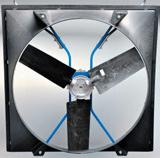
JThe last two GDT auctions both increased by a surprise 3.2% in mid-April and then by another 2.5% in the first week of May.
While the April auction did nothing for EU and UK
prices, the May auction did, boosting Arla’s powder by a useful €200 (£175) equivalent. All of the main commodities increased, with WMP up 5%.
Middle Eastern buying is to be responsible for the increases,
GDT predicted price vs. UK non-aligned price (three-month lag)
rather than China, which has imports that are still lacklustre.
The main question now is whether this is the start of the upturn in earnest or just a dead cat bounce again like there was in February. There does seem to be far more logic to price increases now than then though, especially in the northern hemisphere.
However, the GDT commodities still only convert into an approximate UK milk price equivalent of 29p, but at least that is up nearly 1p on the previous auction.
64 MILK ANALYSIS JUNE 2023 www.abbi-aerotech.com www.rumitechs.co.uk Ph: 07714 846987 HEATSTRESS? The climate in the barn is the key! NEW! NEW! DC-permanent magnetic motor 40-70% energy savings No frequency control needed No motor protection switch needed No special wiring needed No maintenance Mains: 230/400V 50Hz Simpler installation Less electric wiring No obstacles inside No restlessness when doing maintenance Shorter suspension of the fans Lower total investment Airflow in length of cubicles THE SOLUTION: ABBIFAN 140-XXP-2 The latest motor technology now applied on our fans! Direct drive. CROSS VENTILATION blows fresh outside air in your barn!
Jan 19 Mar May Jul Sep Nov Jan 20 Mar May Jul Sep Nov Jan 21 Mar May Jul Sep Nov Jan 22 Mar May Jul Sep Nov Jan 23 Mar May Jul 21 Aug Sep Oct Nov Dec Jan 22 Feb Mar Apr May Jun Jul Aug Sep Oct Nov Dec Jan 23 Feb Mar Apr May Jun 60 50 40 30 20 10 0 50 45 40 35 30 25 GDT Non-aligned Non-aligned Aligned
Last 24 month aligned vs. non-aligned farmgate prices (ppl)
With some milk processors holding their A prices for June, there could be some signs of price stabilisation.

Indices still fall to 28-30p range
JThe latest AMPE figure for April is 31.81p, which is down 2.74p on March. After an allowance for a margin and additional supply chain costs, the farmgate

equivalent is only about 28p. MCVE is at 37.56p, before costs and a margin, and down 1.79p. That equates to a farmgate equivalent of 33.5p.
Milk volumes on par with last year
JThe cold wet spring has certainly taken the sting out of milk volumes. Had it not done so, milk prices would undoubtedly have fallen further and the current prospect of an impending upturn would still be weeks away.
Volumes are on a par with last year now, having been 3-4% higher earlier in the season.
The latest data shows UK milk volumes over the last two weeks have averaged 44.74

million litres per day, some 160,000 litres and 0.4% less than last year, but 0.6% more than the long-term average.

GB milk volumes over the last two weeks have averaged 36.83m litres per day, down 34,000 litres and about 0.1% of last year, and within 0.5% of the long-term average.
This is a positive for the markets, especially as there are signs that Europe’s volumes might be falling too, especially in Germany.
65 MILK ANALYSIS JUNE 2023 Key Features: Flying insects stay away Birds stay out Energy efficient Reduces ground moisture High Volume Low Speed 100ft by 100ft effective working area HVLS - Fans For a no obligation quote or more information Scotland/N. England Will - 07591833853 Wales/Midlands/S.England Fred - 07762800149 N. Ireland/R.O.I - 07803124235 JohnEmail - info@cowcaresystems.com Andrew Cowcare SYSTEMS Innovators in Dairy Farming
NEWProducts
This month, we include a new workwear collection from Ariat, a look at management guides for hedgerows and grassland, a product approved for use on field mice, plus additions to Rumenco’s mineral range.
Driving milk from forage
JWynnstay is launching a campaign, Forage4Profit, to help dairy farmers maximise the quality of home-grown forage and improve milk from forage.
With figures from Kingshay’s cost report from December 2022 showing the amount of milk produced from forage averages 2,900 litres nationally, Wynnstay says there is scope to improve this and reduce purchased feed costs, with the best farms achieving 5,300 litres of milk from forage.
Every 1,000 litres of milk from forage equates to about 460kg of concentrate feed, David Howard, head of dairy at Wynnstay, and by increasing home-grown forage quality, some significant savings on total feed costs can be made.
rMore information from wynnstay.co.uk/ forage-for-profit
Specially formulated for the period on the approach to calving, CalverMaxx is Rumenco’s newest addition to its Maxx range of products, which are designed to include high levels of minerals, vitamins and trace elements to optimise cow and calf performance during this period.

Dr Alison Bond, nutritionist for Rumenco, says CalverMaxx contains good levels of minerals, such as iodine, copper, selenium and magnesium, which are essential for normal physiological functioning and are required in increased amounts for optimal growth, immunity and fertility.
She says: “Nutrient requirements are high in the run-up to calving. A multi-purpose product like CalverMaxx will deliver key performance
Rumenco adds to its mineral range
JNew products are featured in each issue of Dairy Farmer. Please send details and pictures to Hannah Morgan at hannah. morgan@agriconnect.com, or call 01772 799 450.
minerals at good levels to optimise both cow and calf performance.”
More information from rumenco.co.uk
Product approved for use on field mice
JPest control solutions manufacturer BASF has announced that cholecalciferol rodenticide Selontra is now approved for usage on wood or field mice, making it the only rodenticide on the market suitable for targeting these species.

BASF will provide users with a copy of the new label (also available at pestcontrol.basf. co.uk) until packaging with new labels enter circulation.
Pest controllers can begin using the rodenticide to control mouse infestations immediately, as long as they have a copy of the new label.
Suitable for use in and around buildings, the shelf life of the product has also been extended from three years to five years.
rMore information about becoming a certified Selontra user is available at training.selontra.com
66 JUNE 2023
Got a new product?
r
NEW PRODUCTS
SLURRY LAGOON LINERS AND FLOATING COVERS
SLURRY LAGOON LINERS AND FLOATING COVERS
SLURRY LAGOON LINERS AND FLOATING COVERS
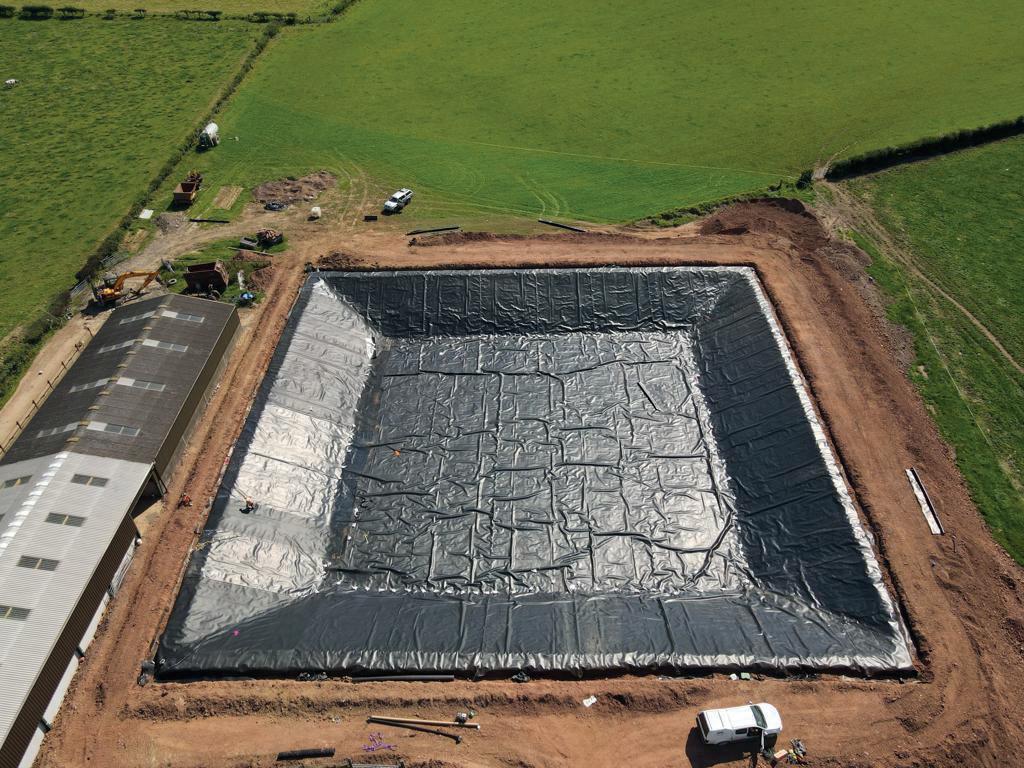

OVER 30 YEARS EXPERIENCE
OVER 30 YEARS EXPERIENCE
MATERIALS & INSTALLATION GUARANTEED


OVER 30 YEARS EXPERIENCE
MATERIALS & INSTALLATION
WATER STORAGE IRRIGATION RESERVOIR
PONDS LAKES
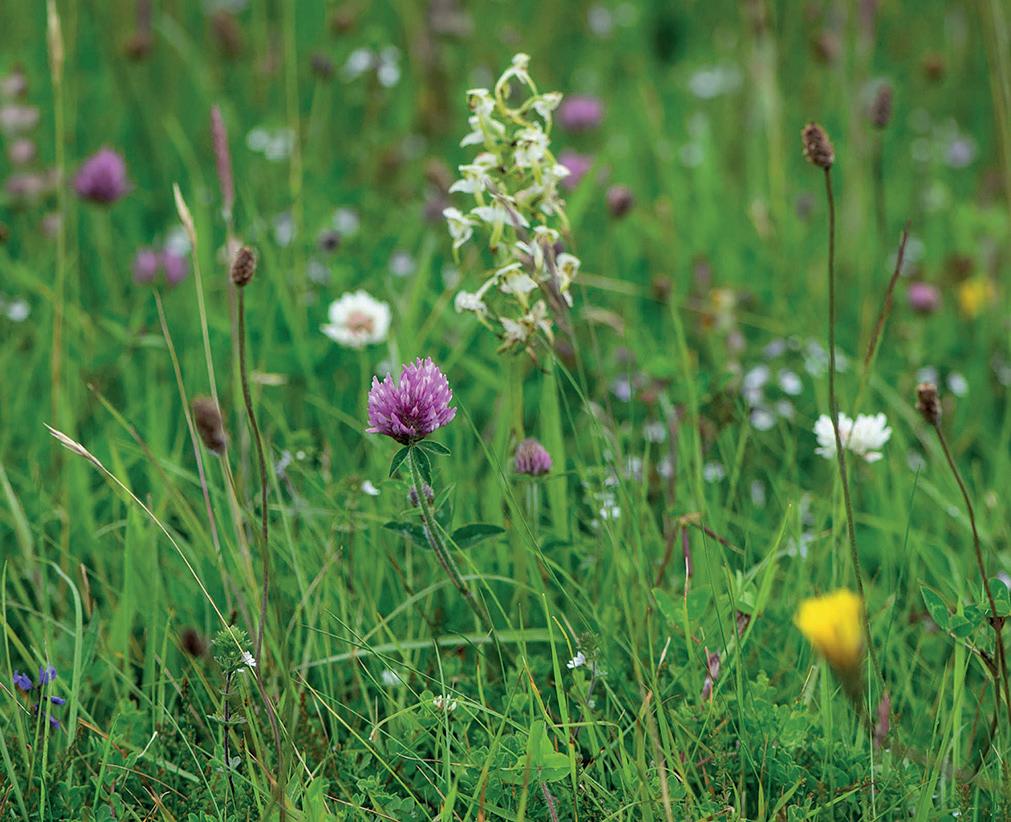
WATER STORAGE IRRIGATION RESERVOIR PONDS LAKES
Tel: 01745 823674 Mob: 07739 711208
Tel: 01745 823674 Mob: 07739 711208
Email: sean@seancarrlining.co.uk
Email: sean@seancarrlining.co.uk
Tel: 01745 823674 Mob: 07739 711208
www.seancarrlining.co.uk
www.seancarrlining.co.uk
Email: sean@seancarrlining.co.uk


Materials meet EA and SEPA requirements, installed and fully tested by TWI / CSWIP CERTIFIED TECHNICIANS Covers comply with EA and SSAFO legislation
www.seancarrlining.co.uk
Materials meet EA and SEPA requirements, installed and fully tested by TWI / CSWIP CERTIFIED TECHNICIANS Covers comply with EA and SSAFO legislation
Full UK & Ireland Coverage
Full UK & Ireland Coverage
Materials meet EA and SEPA requirements, installed and fully tested by TWI / CSWIP CERTIFIED TECHNICIANS Covers comply with EA and SSAFO legislation

Full UK & Ireland Coverage

67
JUNE 2023

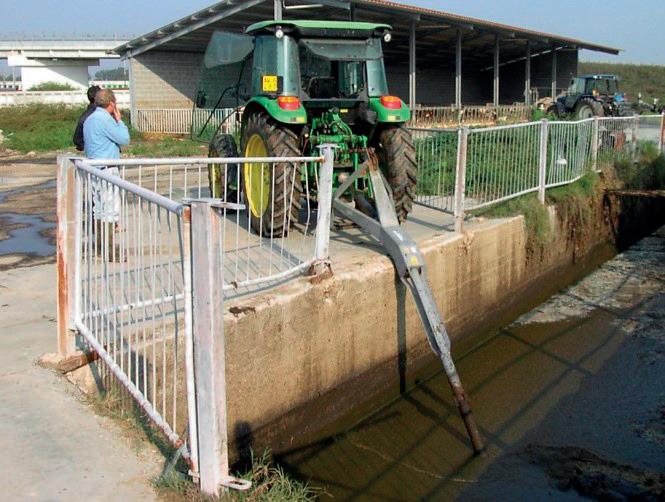


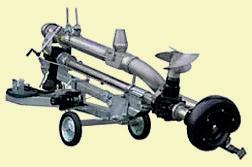
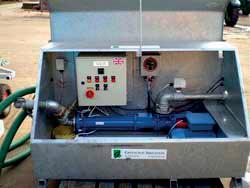









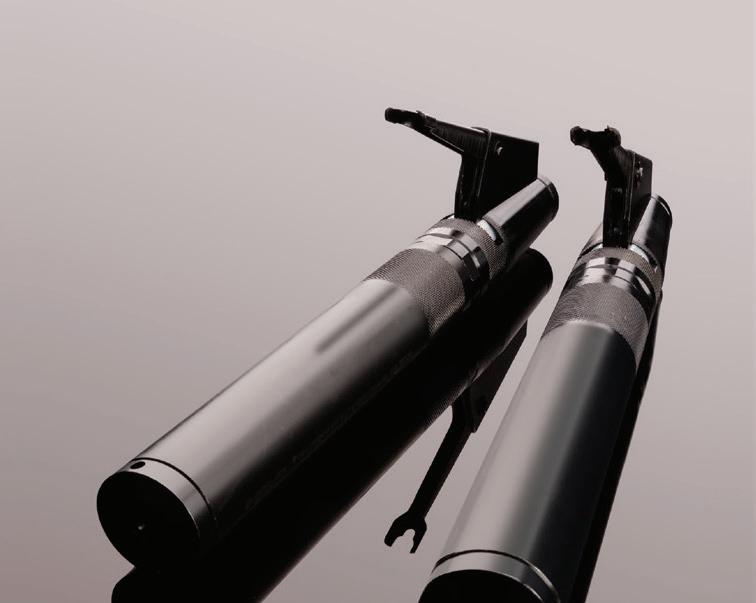



Delaval mobile milking bale for hire/sale. Delaval Blue Diamond 32/32 fast exit MM25s. Save energy, Ice Builders : Bulk Milk Tanks. Heavy duty replacement troughs for most parlours. Delaval VMS Robots : Milk meters, keypads, feeders etc. Everything for the Dairy Farmer Call Vic/Tracey Brown Tel: 01260 226261 www.milkingequipment.com Milking Equipment 68 JUNE 2023 Equipment & Accessories SEPCOM The unique separator Slurry pumps & lagoon mixers 01328 701992 | enquiries@greencrop.co.uk | www.greencrop.co.uk Multicam dirty water irrigator Slurry pump Pump in a box DAIRY FARMER CLASSIFIED TELEPHONE: 01772 799400 1 8m x 1 2m / 6ft x 4ft Each 30kg Per Mat Easy Grip Handles Animal Proof Weather Resistant 100% Rubber Construction R U B B E R S Y S T E M S F O R A G R I C U L T U R E DAIRY MAT ARK www arkmat co uk C a l l o r E m a i l F o r P r i c i n g A n d F u r t h e r D e t a i l s 01392 209 394 info@ark-rubberandresin co uk PARLOUR MATTING HEAVY DUTY SILAGE PIT MATS SUPERSOFT CUBICLE MATS ALLEY MATS 5 YEAR GUARANTEE Livestock Building Services DAIRY FARMER CLASSIFIED 01772 799400 Tel: 01635 253344 Email: sales@raytradeuk.co.uk Web: www.raytradeuk.co.uk SPRAY FOAM INSULATION To Crop & Livestock Stores, Poultry Sheds, Cattle & Pig Buildings, Workshops & Barns. Frost & Condensation Protection. Temperature Control Energy Saving Tel: 01405 812682 www.webstersinsulation.com info@webstersinsulation.com Electric Milk Pasteuriser - MR1000 with Homogeniser. Travis Twin StationGlass Bottle Washer. 6 head Glass and poly milkbottle fillers. 100 ltr Electric Batch Pasteuriser. Batch Ice Cream Freezer Single Phase Electric. APV Gaulin Homogenisers K3 K6 MC18. Dawson 12 head Bottle FillerPlastic and Glass. Labeller HIS Cap SealerCollecting Tables full line. Charles Wait 07788 233608
Business Development Manager
Agriconnect is a business unit within the Arc network, a global events, data, and media platform. Arc is a fast-growing global events, data, and media platform with a varied portfolio content led portals, magazines, and events. Agriconnect’s mission is to empower, inspire, and connect people and business in agriculture by creating trusted content and connections that help the industry thrive.
Since 1844, the brands of Agriconnect have been the trusted source of information for farmers and with brands like Farmers Guardian, events, like LAMMA and Farm Business Innovation, and digital platforms, like FG Insights, Agriconnect continues to bring together the British farming community.

THE ROLE:
• We are now looking for a motivated and driven salesperson to join our Sales team.
• The main function of the role is to develop business through growth in revenue, yield, and to increase customer numbers. You will be required to identify new opportunities and influence companies’ media buying habits within the agricultural sector. Due to the ever-changing nature of the industry, this person will have the ability to spot new avenues and exploit market trends.
• Hours: 35 hours per week – Mon – Fri
• Location: Preston – temporary hybrid remote
• Salary: Competitive, dependant on experience.
SKILLS & EXPERIENCE:
• Own, support and fully develop specific market sectors
• Conduct sales presentations by telephone, email or face to face to existing and prospective clients in order to develop existing business and generate new business wherever possible.
• Advise existing and new customers on the most effective solution to meet client needs within the Agriconnect portfolio.
• Continually seek and develop new sales & opportunities.
• Ability to accurately forecast future sales
• Keep abreast of all current trends, activities and relevant news within agriculture and specific sector


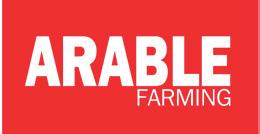
• An interest in agriculture
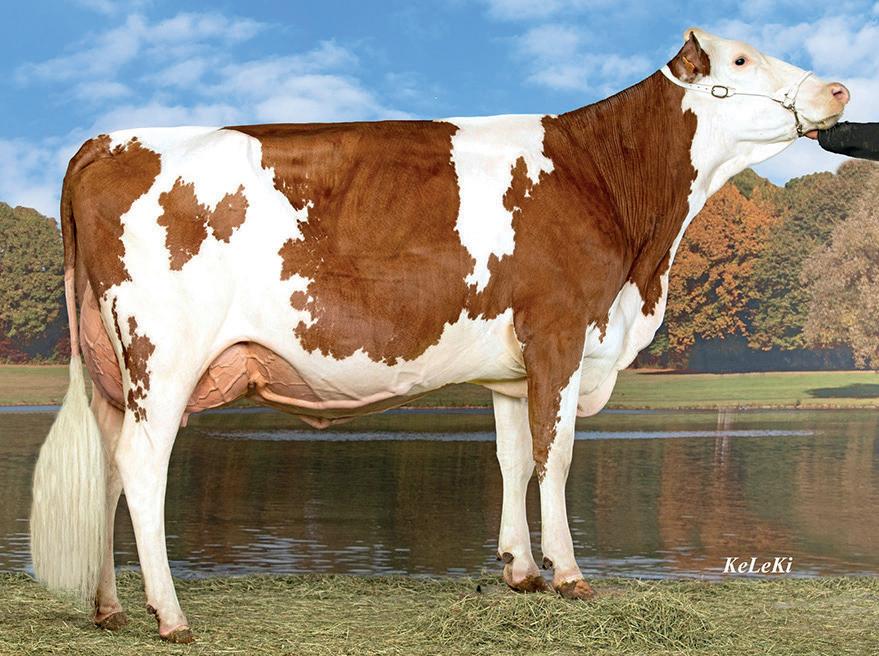
• Highly motivated & driven, with an ability to meet ambitious performance goals
• Be enthusiastic and motivated to continually explore new opportunities, whilst possessing a natural inquisitive nature
• Excellent communication written and interpersonal skills
We offer an excellent package including:

• A competitive basic salary
• 25 days holiday increasing to 27 after two years
• An extra day off on your birthday
• Free life assurance

• Contributory pension scheme
• Employee assistance programme
Arc has ambitious plans for growth, and this is an opportunity to be part of our continuing success story whilst enjoying a fabulous work/ life balance.
We strive to create a culture that is open and respectful, where differences are valued and celebrated. We want everyone to be able to reach their full potential, so we are committed to cultivating a company that promotes inclusion and belonging.
To apply for this role, please email amber.tabiner@agriconnect.com
69 JUNE 2023
Livestock Services FARM HEALTH SOLUTIONS Ask about Herd Health Analysis T . 01756 749444 W . www.crossgateshealth.co.uk
WITH HIGH SCC /MASTITIS? - WANT TO REDUCE USE OF ANTIBIOTICS? - COST EFFECTIVE PRODUCTS WITH EASY WATER TROUGH ADMINISTRATION - DISCOUNTS - WE CAN HELP WITH SHEEP PROBLEMS TOO - CALL FOR A FREE SAMPLE KIT APPLE CIDER VINEGAR (ACV) Nationwide (01948) 662910/663143 george@greenfieldsrise.f9.co.uk Dairy Cattle Highest yielding alternative to Holstein. For udder health and fertility See updated website www.Formakin-Montbeliardes.com In Calf Heifers & Bulls available from France Formakin Montbeliardes Telephone: Robin McMurrich 07971 973155 Email: formakin44@gmail.com
Recruitment
PROBLEMS
GOODEvans ‘Local legend has it that I was knocked out’
Afriend of mine and a friend of hers decided to go for a ride on their horses. They decided to ride to a pub they knew, which would take them about two hours across country.
So far so good. But their journey took them along a canal. There were two swans nesting nearby and they were not best pleased to see them.
They had left the nest about 50 yards behind when the male swan must have had second thoughts. No doubt egged on by his wife, he decided that this was a missed opportunity, that it called for more than just some hissing noises and a ruffling of feathers.
So he flew down the canal and attacked the horses. My friend’s horse bucked and reared uncontrollably, but she managed to get off before she was thrown off.
Her friend was not so lucky, (if luck ever comes into it), and she and her horse ended up in the canal.
Canals are not easy to get out of and, while the lady was able to scramble out, her horse couldn’t.
Eventually the lady got back into the water and led her horse back to where the banks were less steep.
Of course, this swan wanted shooting, but I don’t think you are allowed to do that.
Every bird and animal that is rewilded or exists already has a downside. Should that downside turn up and the bird or animal be protected, you can’t do anything about it.
Advocates of rewilding haven’t thought this through, not because they can’t, but because they don’t want to.
For example, as farmers we see every day what havoc Red Kites inflict on small birds and mammals and just don’t get me started on badgers.
That swan could have just as easily have attacked someone frail, elderly or a child.
Those swans have eggs to hatch and then cygnets to protect, the male could be aggressive for months yet.
An article in a recent Dairy Farmer was a trip down
memory lane for me. It concerned Ceredigion dairy farmer Chris Mossman. I used to know Chris quite well, but what triggered it for me was a farm I know very well in the background of one of the photos.
Let me explain. After I left college, I worked for some time for a relief milking agency. I was only 20, and I went to this farm two days before Christmas because the owner had died suddenly.
I was on my own in the house and outside. There was a huge new cowshed there and about 70 cows. It used to take as long to tie them up as it did to milk them.
Because of a design fault, the cows had to go outside every night. There was only one gate on the farm, at the entrance, so every morning you never knew where the cows would be.
Honest
The executors knew nothing of farming and were very suspicious, so only allowed me two bags of cake every day. I think that they were more surprised that I was honest and how I co-operated and organised the subsequent sale, but they never thanked me.
There was a crawler tractor on the farm which I drove at every opportunity. I thought it was cool. It was an unusually bad winter, so I used to take the milk down to the village every day with the crawler.
And I used to take it down to the village several times a week to pull the bus out of the snow. That was the only time in my life when I was seen as some sort of hero.
There were only about 30 of us in the village in the winter, second homes were an issue even then, and I used to go to the pub every night for a warm and some company.
There were two pubs in the village and it was an unwritten law that, in the interests of fairness, drinkers went to both. So you would all go to the one first and at 9pm we would all walk, including the landlord, to the other.
It was popular to play that skittles game with a ball on
This month, Roger Evans discusses the downsides of rewilding, reminisces about a farm he once milked at and details what medical professionals have made of him over the years.
70 JUNE 2023
a string. I got quite good at it and, if you won, your opponent had to buy you a pint, which meant that I had much to drink and a cheap night on many an occasion.
I was there for four to six months. I o en wonder what they did with that big cowshed — I bet they kept sheep in it. It was when people were pu ing in their rst milking parlours, so it was obsolete as soon as it was built.
I had to go to see a consultant recently.
My mobility is not that good. I reckon it’s because I played rugby until 50, pulled tug of war during the summer and spent most of my life paddling about in wellies on cold, wet concrete.

ese days most of my joints are crying out at the treatment they have received in the past, but you can’t do anything about that now.
e consultant sent me a copy of the le er he sent to my GP in which he described me as a ‘pleasant gentleman’. is caused much raising of eyebrows in my family, but there it is in black and white, and what’s more, it is the opinion of a professional.


But it’s only half of the story. Several years ago, it was the weekend before Christmas, and I took most of the men who worked for me for a lunchtime drink.
Lunchtime in this case stretched to about 4pm.
Find Jobs Faster

As we le the pub, we thought it would be a good idea to have one more at a local rugby club. is club rented a room at the same pub, it was on the upper oor and was accessed by a steep staircase.
I’d had much too much to drink and so, when we le , I fell down the stairs — right to the bo om.
Local legend has it that I was knocked out, but I always maintain that I just curled up and went to sleep.
Anyway someone phoned for an ambulance and we blued-lighted it to the local A&E where we were greeted by a very a ractive lady doctor.
Steep
She might have been a ractive, but she wasn’t big on sympathy and she didn’t like my sarcastic sense of humour. Anyway she gave me a bit of an examination and said I could go.
As a parting shot she gave me a piece of paper, which said: “this man is a drunk, he fell down some stairs and knocked himself out”.
So there we have it; I’ve been described both as a drunk and a pleasant gentleman by medical professionals. Where does the truth lie? Probably somewhere in the middle, just like life itself.
JobsInAgriculture Jobs in your field Let us keep you updated by email and never miss another great job JobsInAgriculture.com
Receive the latest jobs in your inbox with our free email alert service 71 JUNE 2023
“He described me as a pleasant gentleman. This caused much raising of eyebrows in my family
The milk price rollercoaster that dairy producers have clung onto over the last 18 months has made business planning very difficult, so is it time for a new approach? Cedric Porter reports.
At the start of 2022
milk prices were about 35ppl, according to Defra, then by the end of the year they were above 50ppl.
While that rise had been dizzying, so too has been the drop in values, with many prices now well below 40ppl.
Dairy market watcher Chris Walkland thinks they could go back to levels seen at the beginning of last year.
He says: “Prices will probably fall to 35ppl or even lower before they level out and edge upwards as pressure on supply increases following a reduction in output.”
Extreme
Such volatility may be extreme, but it is not unique. Since the break-up of the Milk Marketing Board in 1994, prices have fluctuated wildly, Defra figures show.
In May 2001, prices were 22% higher than the year before, but just over a year later they were 20% lower.
It was a similar situation in
Price volatility raises contract pricing questions
2008. In March that year, average prices were 45% more than the year before, but by May 2009 they were down 15%.
An annual price rise of 20% in August 2013 was replaced with a 25% drop just two years later, which prompted another swing in values between 2016 and 2018.
You need to go back to the price-controlled days of the Milk Marketing Board when there was any price stability.
Following some high and fluctuating prices in the mid-1970s (partly driven by general inflation) in the 20 years before the board’s demise
How other countries pay for milk
FRIESLAND CAMPINA
JThe Dutch co-op pays a basic price which reflects the average price paid by a number of north west Europe dairy companies.
Producers pay €0.60 (53p) per 100kg of milk as a contribution to the Foqus sustainability scheme.
In return, they can access premium payments of up to €3.50 (£3.08) per 100kg.
An animal welfare supplement is up to 20c (18p)/100kg, climate change mitigation attracts a payment of up to €1.50 (£1.32), with a maximum of 50c (44p) for biodiversity enhancement and up to €1.30 (£1.15) for full grazing.
An enhanced programme called On the Way to PlanetProof can attract up to €5 (£4.41)/100kg once a herd is fully accredited.
Because Friesland Campina is a co-op, dairy farmer members also receive a share of profits.
The February milk price for Friesland Campina was €53.76 (£47.31)/100kg.
FONTERRA, NEW ZEALAND
JThe vast majority of New Zealand milk is made into products which are exported. Using the twice-monthly Global Dairy Trade auctions as a reference, dairy farmers are paid on a milk solids basis. The latest April price estimate was NZ$8-$8.60 (£3.98-£4.28)/kg of milk solid.
the price rose by an average of 8% a year with only a handful of months when the price was lower than it was 12 months before.
There have been attempts to smooth out milk price peaks and troughs. The latest is Muller’s A and B pricing schedule introduced in April.
A price
Most of the milk it buys (94%) is bought for what it calls an A price based on the contracts it has with retailers and other buyers. Producers have a month’s notice of milk price changes. The May price is 40ppl.
At its June 2022 peak, the price range was NZ$8.75-$10.25 (£4.35-£5.10).
Dutch global milk price service
ZuivelNL calculates the February Fonterra price is the equivalent of €37.69 (£33.17)/100kg of milk.
As a co-op, dairy farmer members also receive share dividends. The most recent was NZ$0.10 (5p) a share.
CANADA
JMilk prices are set by the Canadian Dairy Commission. Values differ depending on its use, based on butterfat, protein, calcium and lactose components. A formula is used to set the price. Half of the formula is based on the cost of production,
The remaining 6% of Muller’s B priced milk is based on an independently audited value which takes into account global milk prices.
Producers are given three months’ advanced warning of estimated prices, but the actual price they receive is dependent on market conditions. The milk is mainly from the spring flush sold for milk powder.
A number of retailers have introduced dairy contracts for dedicated groups of farmers over the years. Tesco set up its Sustainable Dairy Group in 2007. It has more than 500 members
which is measured by the commission, with the other half based on consumer prices, calculated by the country’s official statistics agency StatCan.
Current prices vary from CA$7.74-$11.22/kg (£4.54-£6.58/kg) for butterfat, CA$2.78-$9.70/kg (£1.63£5.69/kg) for protein and CA$0.89-$2.78 (£0.52-1.63) for other solids, such as lactose and calcium, depending on the class of milk.
For comparison, a 5A class milk attracts a May 2023 payment of CA$8.23 (£4.83) for butterfat, CA$7.26 (£4.26) for protein and CA$0.70 (£0.41) for other solids.
72 BUSINESS CLINIC JUNE 2023
for dairy farmers to deliver improved environmental performance and animal welfare, along with more legislation.




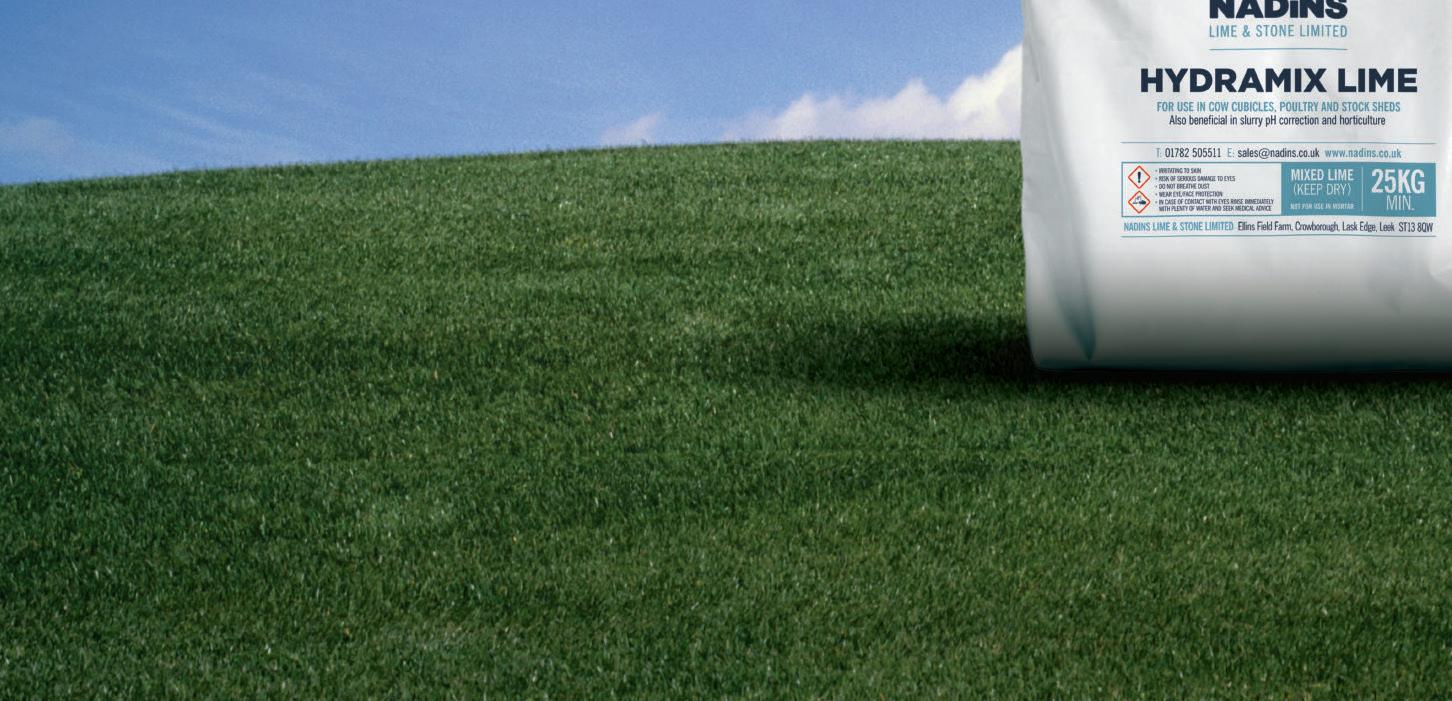
“ at all costs them money and, without reward for that extra e ort, more will exit the industry, especially as there are more alternatives to dairying, including renting out land, environmental payments, carbon o se ing and planting trees.”

Di Wastenage, chair of the Royal Association of British Dairy Farmers, warns that without recognition of the high cost of producing milk, the UK’s dairy de cit will increase further.
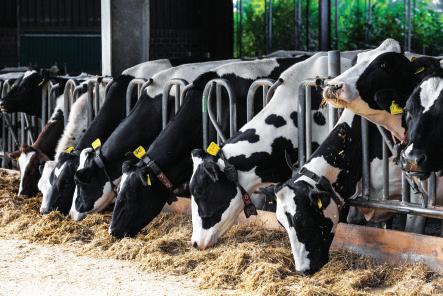
A move to more secure pricing models will be essential, says John Allen of Kite Consulting. and the price it pays is based on cost of production.








Looking at the price it pays, members are more likely to bene t from being in the group when general prices are falling rather than rising.
Since the beginning of 2020, the average price paid to members has ranged from 30.87ppl in December

2020 to 48ppl in January this year.


















































































In contrast, the average Defra price has uctuated from 26.71ppl in May 2020 to 51.6ppl in December 2022. Tesco producers are ge ing a premium of more than 3ppl in May this year.
















A move to more secure pricing models will be essential if dairy
















farmers are to survive and processors are to get the milk they need, says John Allen of Kite Consulting.
Fewer farmers




He says: “More volatility is likely to mean fewer farmers and less milk and a greater use of locked in supply chains. ere is also greater pressure
She says: “UK farming and dairy farming, in particular, are producing highly nutritious foods to some of the highest environmental standards throughout the world.
“As a result, farmers must receive a sustainable price for their produce to ensure this production is not substituted for imported products with lower environmental and animal welfare credentials.”
73 JUNE 2023
Hot and bothered cows get £1.24 million study
Anew research project aims to address the problem of dairy cow heat stress to ensure sustainable milk production and improve cow welfare as temperatures look set to increase in the future.
Researchers from the universities of Reading, Essex and Cardi and Wri le University College are collaborating on the £1.24 million Biotechnology and Biological Sciences Research Council-funded project to understand the interaction between temperature, microclimates within farm buildings and cow physiology and behaviour.
e project will bring together experts in animal and dairy sciences, mathematical modelling and statistics and building design engineering.
Chris Reynolds, professor of animal and dairy sciences at the University of Reading, says: “Heat stress due to climate change could have severe negative consequences for the health and productivity of dairy cows.
“Lactating cows have a high rate of metabolism, which makes them less tolerant of high temperatures. Research is essential to inform and shape future cow management strategies and building designs.”
Research will take place at the
University of Reading’s Centre for Dairy Research and six commercial dairy farms across the UK.
Individual cow behaviour will be continuously monitored using tracking sensors which record pa erns of movement, activity and space use for each animal in the herd.
Detailed observations of barn microclimates (temperature, humidity, air quality and ventilation) will also be obtained and combined with physiological data (cow body temperature, milk production and health).
Cows are known to adapt their behaviour to help cope with high temperatures and humidity.
ey may increase their intake of water, seek shade or areas of increased ventilation, or exhibit other individual and social behavioural responses, all of which can be observed.

Tracking sensors
Edward Codling, professor of mathematical biology at the University of Essex, says: “Our tracking sensors will allow us to analyse how indoor-housed dairy cows respond to, and cope with, heat stress in an unprecedented level of detail.

“By combining animal tracking data with continuous sensor monitoring of barn microclimates,
we will be able to model and predict the complex interactions between cow behavioural choices and their housed environment.”
e data collected will inform development of housing designed to reduce heat stress and improve welfare.
Zhiwen Luo, professor in architectural and urban science at Cardi University, says: “We have to respond to the changing environment and through be er understanding of how cows interact with building microclimates, design housing and management systems which minimise heat stress and enable more sustainable dairy systems.”
Trial shows methane reduction in herds using health system
JEarly detection of health problems in dairy cows could lead to a 15% reduction in the amount of methane emissions they produce, according to new research.
The work – carried out by the Agricultural Research and Education Centre (AREC) Raumberg-Gumpenstein in
Austria, in conjunction with dairy innovators, smaXtec – looked at the impact of animal health on methane emissions.It found that the use of smaXtec’s bolus technology helped farmers detect and treat sick cows sooner, leading to a 10-15% reduction in the amount of methane emissions per kg of milk produced.
Dr Thomas Guggenberger, head of the Institute of Livestock Research at AREC Raumberg-Gumpenstein, says the calculation is based on using IPCC standards to measure the benefits of the health monitoring system.
He says: “Our calculations, which are also based on our
own respiration experiments, have shown that animals with a longer useful life emit less methane per kg of milk at typical breed performance.
“Early detection of disease and proactive health management can reduce animal losses, effectively reducing methane emissions in the dairy industry.”
74 RESEARCH JUNE 2023
The study will see observations of shed microclimates combined with physiological data to help predict heat stress behaviour and inform future building design.
Birmingham October 19, 2023




SHOWCASING THE BEST AND BRIGHTEST FARMING TALENT
ENTRIES AND NOMINATIONS ARE NOW OPEN









ENTER TODAY
To enter for yourself or to nominate someone, scan the QR code below or visit: enter.britishfarmingawards.co.uk
Entries close June 23, 2023


There are infinite reasons to support our farmers, who all provide an invaluable service for the ever-growing population and the British Farming Awards are back for 2023 to celebrate the people at the heart of agriculture.



You can enter for yourself, or you can nominate someone you believe deserves recognition for their outstanding contribution to UK agriculture.
Sponsored by


out more
Find
britishfarmingawards.com
Vox Conference
Centre,














































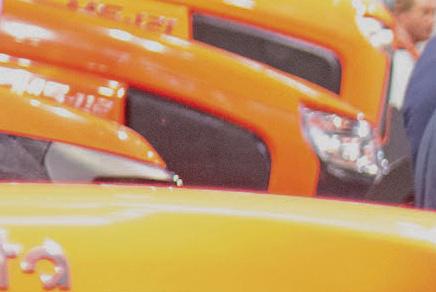




















































































17-18 january 2024 LAMMAShow.com

























































































































































































































































































































































































































 Mark Hall
Mark Hall






























































































































































































































































































































